The Nature of Learning at Forest School: Practitioners' Perspectives
VerifiedAdded on 2023/05/30
|42
|13340
|155
AI Summary
This paper investigates forest school practitioners perceptions of learning at forest school to identify the topics covered, the learning styles, and the philosophies underpinning its delivery, based on interviews with experienced forest school practitioners.
Contribute Materials
Your contribution can guide someone’s learning journey. Share your
documents today.
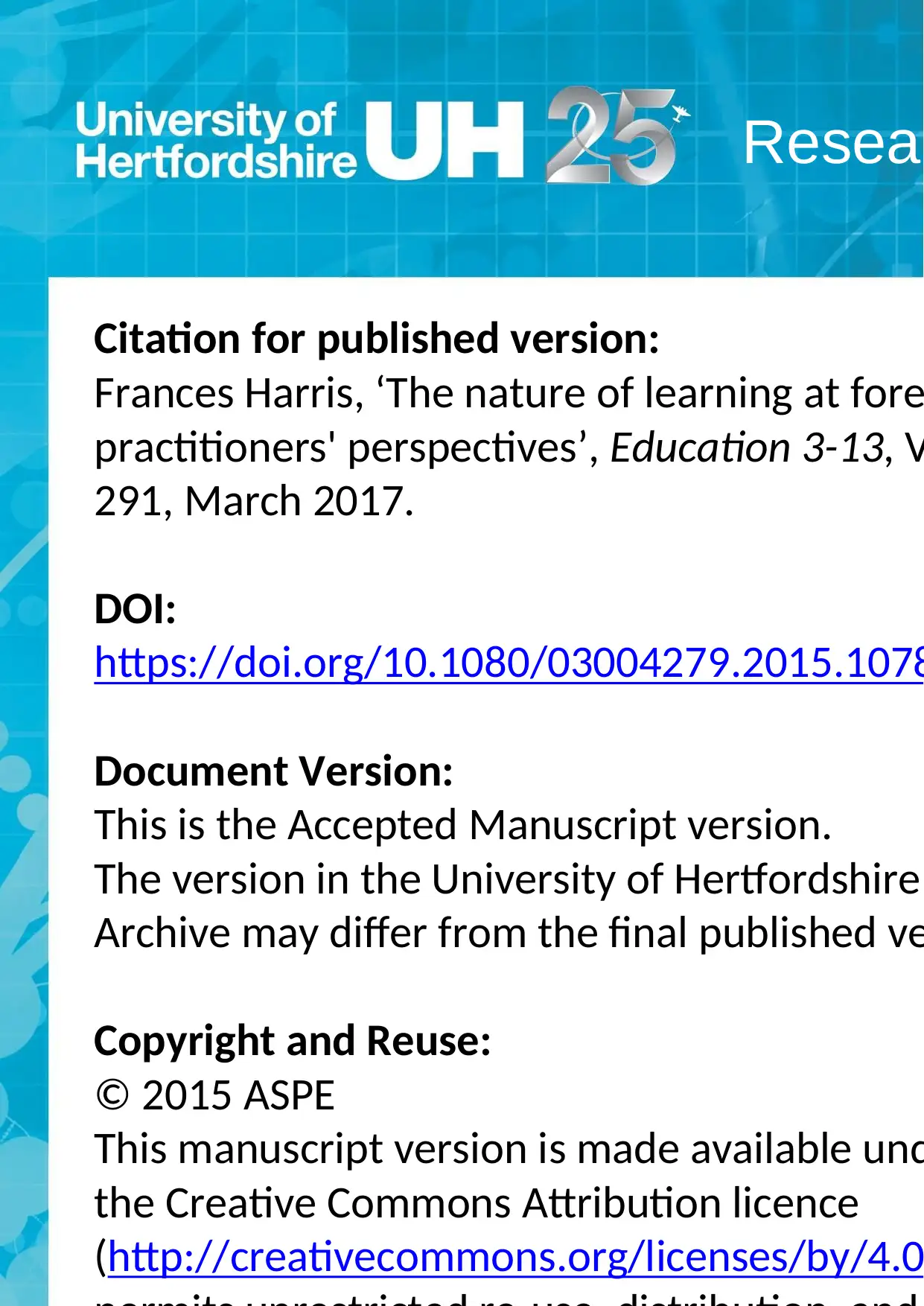
Resear
Citation for published version:
Frances Harris, ‘The nature of learning at fore
practitioners' perspectives’, Education 3-13, V
291, March 2017.
DOI:
https://doi.org/10.1080/03004279.2015.1078
Document Version:
This is the Accepted Manuscript version.
The version in the University of Hertfordshire
Archive may differ from the final published ve
Copyright and Reuse:
© 2015 ASPE
This manuscript version is made available und
the Creative Commons Attribution licence
(http://creativecommons.org/licenses/by/4.0
Citation for published version:
Frances Harris, ‘The nature of learning at fore
practitioners' perspectives’, Education 3-13, V
291, March 2017.
DOI:
https://doi.org/10.1080/03004279.2015.1078
Document Version:
This is the Accepted Manuscript version.
The version in the University of Hertfordshire
Archive may differ from the final published ve
Copyright and Reuse:
© 2015 ASPE
This manuscript version is made available und
the Creative Commons Attribution licence
(http://creativecommons.org/licenses/by/4.0
Secure Best Marks with AI Grader
Need help grading? Try our AI Grader for instant feedback on your assignments.

Pre-print version. Please see final published version before citing.
Harris, F. Education 3-13 DOI 10.1080/03004279.2015.1078833
The Nature of Learning at Forest School: Practitioners' Perspectives.
This paper investigates forest school practitioners perceptions of learning at forest
school to identify the topics covered, the learning styles, and the philosophies
underpinning its delivery, based on interviews with experienced forest school
practitioners. Practitioners identified the focus of learning at forest school as social
development: teamwork, relationships with others, self-knowledge, and learning to take
risks. Children also engaged with nature, and developed an attachment to the woods
where forest school took place. Learning styles were kinaesthetic, sensory and
experiential. Forest school leaders saw themselves as facilitators of learning, rather than
teachers.
Keywords
Forest school, primary school, outdoor learning, negotiated learning, children and nature.
Harris, F. Education 3-13 DOI 10.1080/03004279.2015.1078833
The Nature of Learning at Forest School: Practitioners' Perspectives.
This paper investigates forest school practitioners perceptions of learning at forest
school to identify the topics covered, the learning styles, and the philosophies
underpinning its delivery, based on interviews with experienced forest school
practitioners. Practitioners identified the focus of learning at forest school as social
development: teamwork, relationships with others, self-knowledge, and learning to take
risks. Children also engaged with nature, and developed an attachment to the woods
where forest school took place. Learning styles were kinaesthetic, sensory and
experiential. Forest school leaders saw themselves as facilitators of learning, rather than
teachers.
Keywords
Forest school, primary school, outdoor learning, negotiated learning, children and nature.
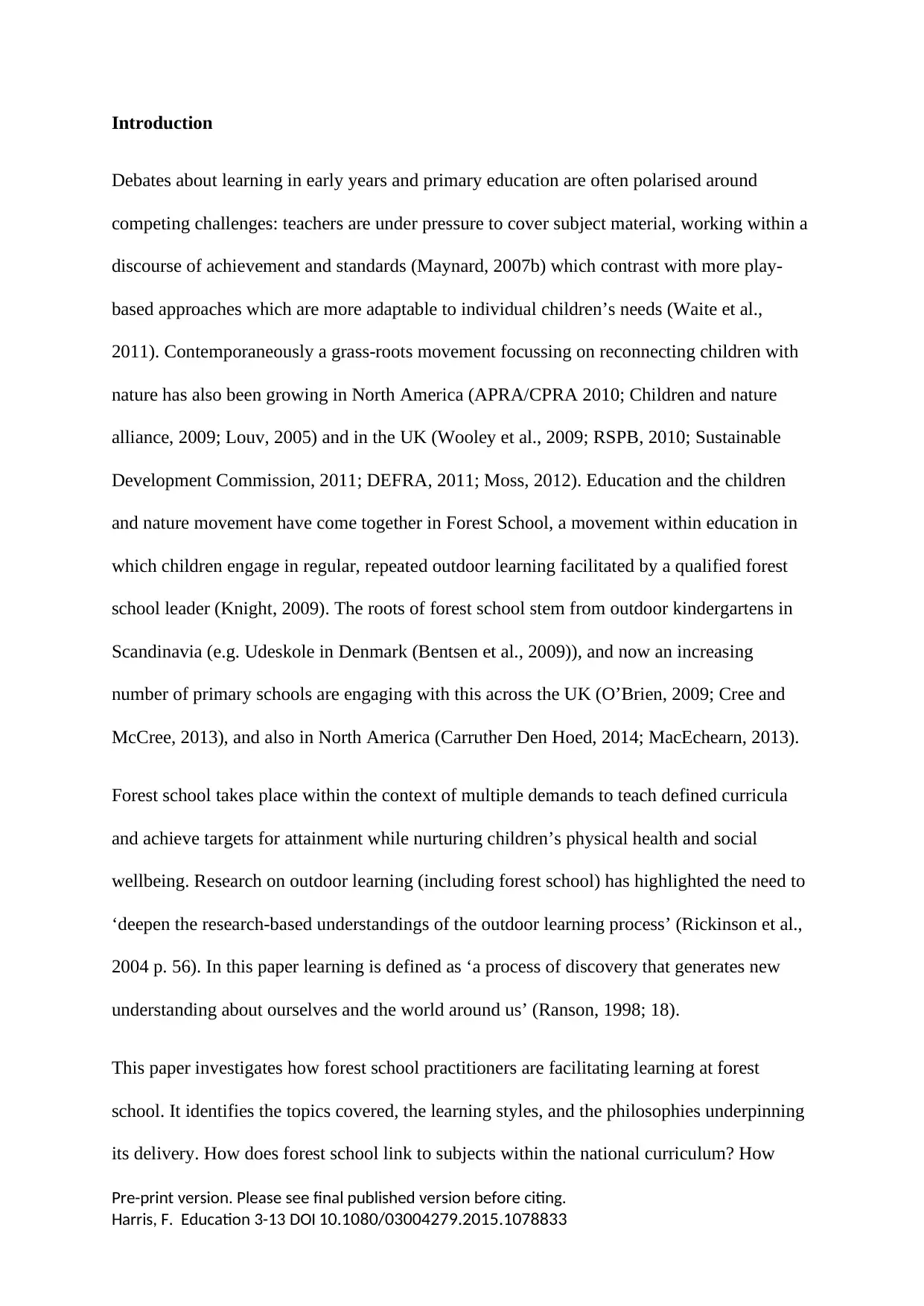
Pre-print version. Please see final published version before citing.
Harris, F. Education 3-13 DOI 10.1080/03004279.2015.1078833
Introduction
Debates about learning in early years and primary education are often polarised around
competing challenges: teachers are under pressure to cover subject material, working within a
discourse of achievement and standards (Maynard, 2007b) which contrast with more play-
based approaches which are more adaptable to individual children’s needs (Waite et al.,
2011). Contemporaneously a grass-roots movement focussing on reconnecting children with
nature has also been growing in North America (APRA/CPRA 2010; Children and nature
alliance, 2009; Louv, 2005) and in the UK (Wooley et al., 2009; RSPB, 2010; Sustainable
Development Commission, 2011; DEFRA, 2011; Moss, 2012). Education and the children
and nature movement have come together in Forest School, a movement within education in
which children engage in regular, repeated outdoor learning facilitated by a qualified forest
school leader (Knight, 2009). The roots of forest school stem from outdoor kindergartens in
Scandinavia (e.g. Udeskole in Denmark (Bentsen et al., 2009)), and now an increasing
number of primary schools are engaging with this across the UK (O’Brien, 2009; Cree and
McCree, 2013), and also in North America (Carruther Den Hoed, 2014; MacEchearn, 2013).
Forest school takes place within the context of multiple demands to teach defined curricula
and achieve targets for attainment while nurturing children’s physical health and social
wellbeing. Research on outdoor learning (including forest school) has highlighted the need to
‘deepen the research-based understandings of the outdoor learning process’ (Rickinson et al.,
2004 p. 56). In this paper learning is defined as ‘a process of discovery that generates new
understanding about ourselves and the world around us’ (Ranson, 1998; 18).
This paper investigates how forest school practitioners are facilitating learning at forest
school. It identifies the topics covered, the learning styles, and the philosophies underpinning
its delivery. How does forest school link to subjects within the national curriculum? How
Harris, F. Education 3-13 DOI 10.1080/03004279.2015.1078833
Introduction
Debates about learning in early years and primary education are often polarised around
competing challenges: teachers are under pressure to cover subject material, working within a
discourse of achievement and standards (Maynard, 2007b) which contrast with more play-
based approaches which are more adaptable to individual children’s needs (Waite et al.,
2011). Contemporaneously a grass-roots movement focussing on reconnecting children with
nature has also been growing in North America (APRA/CPRA 2010; Children and nature
alliance, 2009; Louv, 2005) and in the UK (Wooley et al., 2009; RSPB, 2010; Sustainable
Development Commission, 2011; DEFRA, 2011; Moss, 2012). Education and the children
and nature movement have come together in Forest School, a movement within education in
which children engage in regular, repeated outdoor learning facilitated by a qualified forest
school leader (Knight, 2009). The roots of forest school stem from outdoor kindergartens in
Scandinavia (e.g. Udeskole in Denmark (Bentsen et al., 2009)), and now an increasing
number of primary schools are engaging with this across the UK (O’Brien, 2009; Cree and
McCree, 2013), and also in North America (Carruther Den Hoed, 2014; MacEchearn, 2013).
Forest school takes place within the context of multiple demands to teach defined curricula
and achieve targets for attainment while nurturing children’s physical health and social
wellbeing. Research on outdoor learning (including forest school) has highlighted the need to
‘deepen the research-based understandings of the outdoor learning process’ (Rickinson et al.,
2004 p. 56). In this paper learning is defined as ‘a process of discovery that generates new
understanding about ourselves and the world around us’ (Ranson, 1998; 18).
This paper investigates how forest school practitioners are facilitating learning at forest
school. It identifies the topics covered, the learning styles, and the philosophies underpinning
its delivery. How does forest school link to subjects within the national curriculum? How
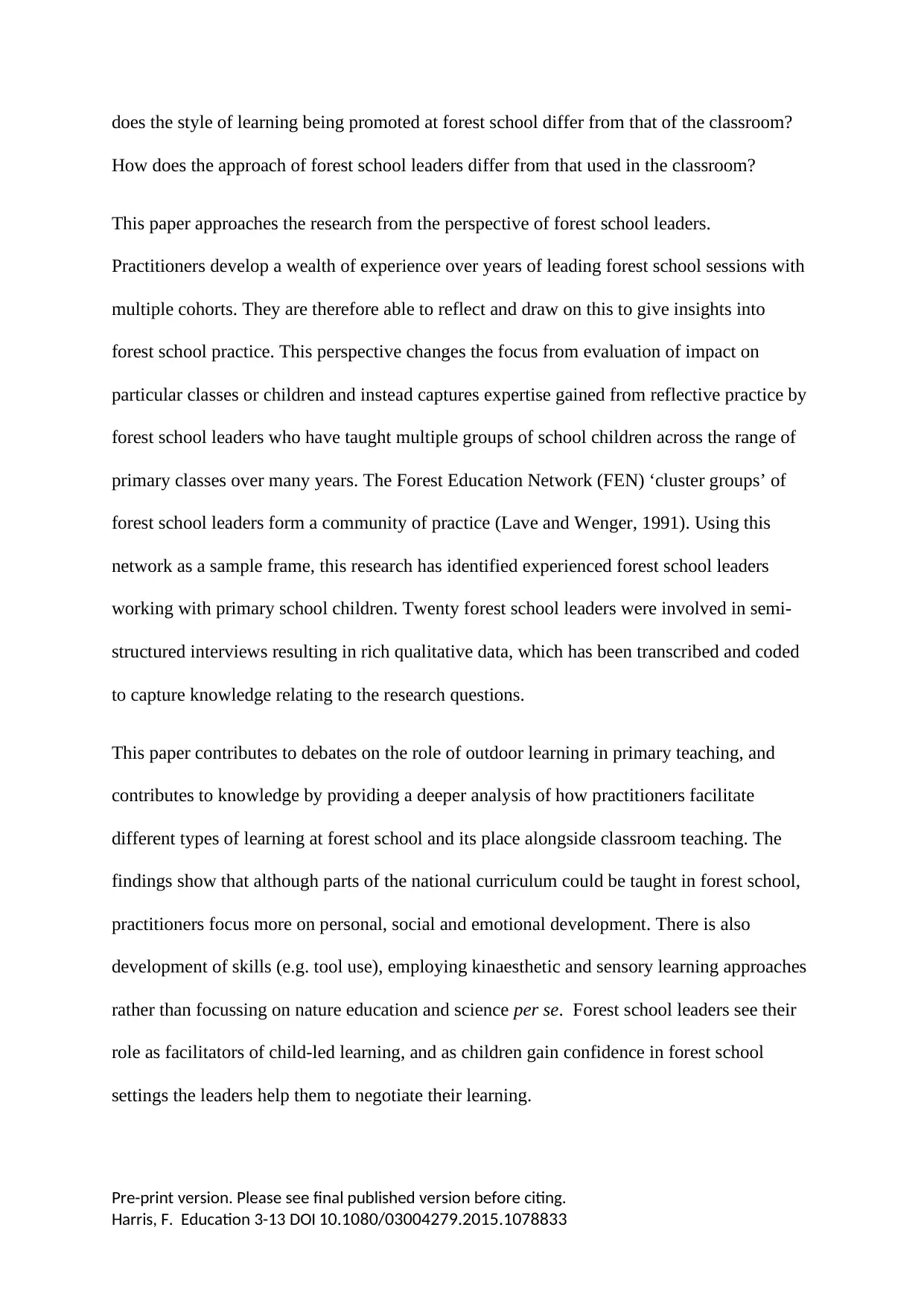
Pre-print version. Please see final published version before citing.
Harris, F. Education 3-13 DOI 10.1080/03004279.2015.1078833
does the style of learning being promoted at forest school differ from that of the classroom?
How does the approach of forest school leaders differ from that used in the classroom?
This paper approaches the research from the perspective of forest school leaders.
Practitioners develop a wealth of experience over years of leading forest school sessions with
multiple cohorts. They are therefore able to reflect and draw on this to give insights into
forest school practice. This perspective changes the focus from evaluation of impact on
particular classes or children and instead captures expertise gained from reflective practice by
forest school leaders who have taught multiple groups of school children across the range of
primary classes over many years. The Forest Education Network (FEN) ‘cluster groups’ of
forest school leaders form a community of practice (Lave and Wenger, 1991). Using this
network as a sample frame, this research has identified experienced forest school leaders
working with primary school children. Twenty forest school leaders were involved in semi-
structured interviews resulting in rich qualitative data, which has been transcribed and coded
to capture knowledge relating to the research questions.
This paper contributes to debates on the role of outdoor learning in primary teaching, and
contributes to knowledge by providing a deeper analysis of how practitioners facilitate
different types of learning at forest school and its place alongside classroom teaching. The
findings show that although parts of the national curriculum could be taught in forest school,
practitioners focus more on personal, social and emotional development. There is also
development of skills (e.g. tool use), employing kinaesthetic and sensory learning approaches
rather than focussing on nature education and science per se. Forest school leaders see their
role as facilitators of child-led learning, and as children gain confidence in forest school
settings the leaders help them to negotiate their learning.
Harris, F. Education 3-13 DOI 10.1080/03004279.2015.1078833
does the style of learning being promoted at forest school differ from that of the classroom?
How does the approach of forest school leaders differ from that used in the classroom?
This paper approaches the research from the perspective of forest school leaders.
Practitioners develop a wealth of experience over years of leading forest school sessions with
multiple cohorts. They are therefore able to reflect and draw on this to give insights into
forest school practice. This perspective changes the focus from evaluation of impact on
particular classes or children and instead captures expertise gained from reflective practice by
forest school leaders who have taught multiple groups of school children across the range of
primary classes over many years. The Forest Education Network (FEN) ‘cluster groups’ of
forest school leaders form a community of practice (Lave and Wenger, 1991). Using this
network as a sample frame, this research has identified experienced forest school leaders
working with primary school children. Twenty forest school leaders were involved in semi-
structured interviews resulting in rich qualitative data, which has been transcribed and coded
to capture knowledge relating to the research questions.
This paper contributes to debates on the role of outdoor learning in primary teaching, and
contributes to knowledge by providing a deeper analysis of how practitioners facilitate
different types of learning at forest school and its place alongside classroom teaching. The
findings show that although parts of the national curriculum could be taught in forest school,
practitioners focus more on personal, social and emotional development. There is also
development of skills (e.g. tool use), employing kinaesthetic and sensory learning approaches
rather than focussing on nature education and science per se. Forest school leaders see their
role as facilitators of child-led learning, and as children gain confidence in forest school
settings the leaders help them to negotiate their learning.
Paraphrase This Document
Need a fresh take? Get an instant paraphrase of this document with our AI Paraphraser
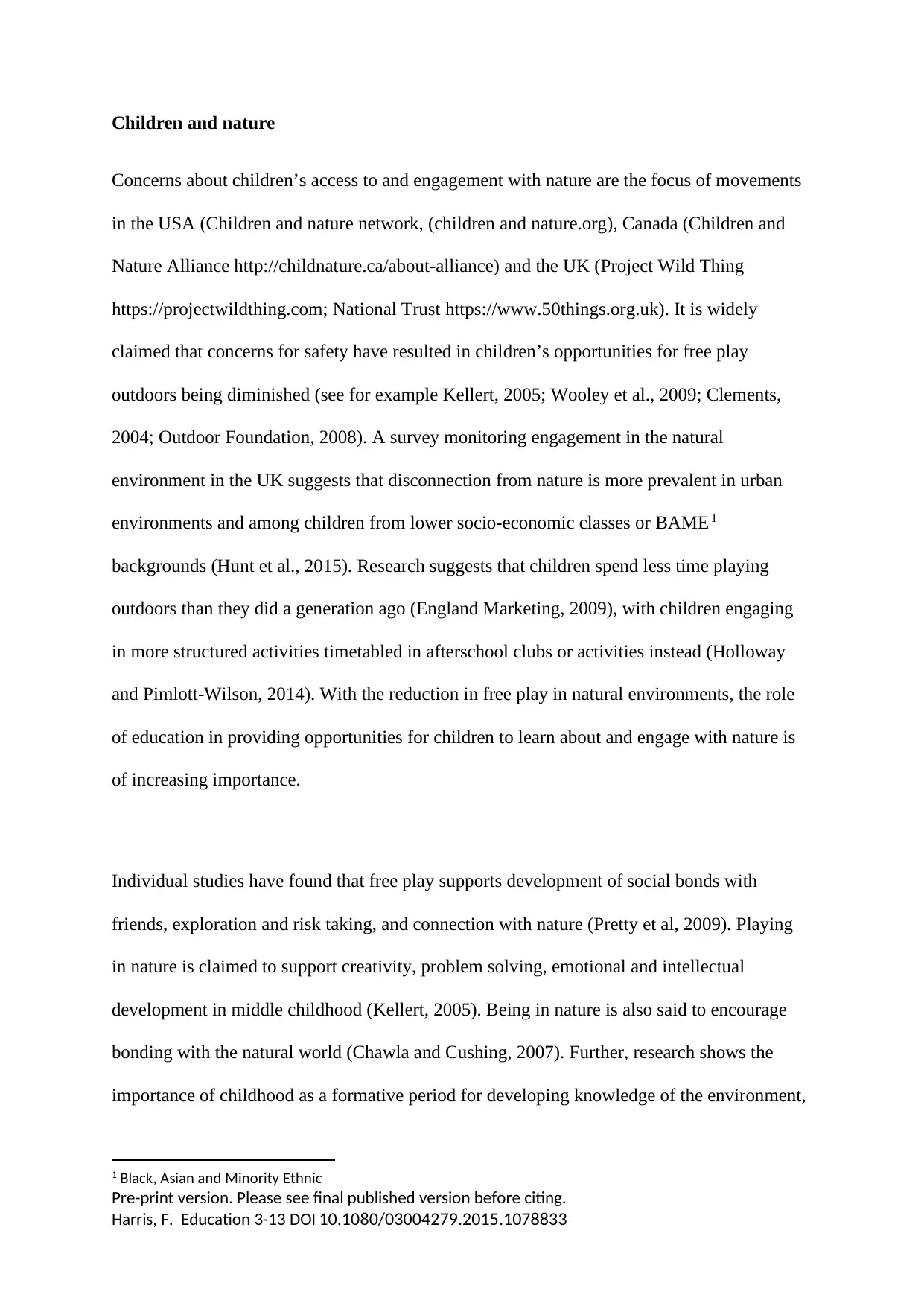
Pre-print version. Please see final published version before citing.
Harris, F. Education 3-13 DOI 10.1080/03004279.2015.1078833
Children and nature
Concerns about children’s access to and engagement with nature are the focus of movements
in the USA (Children and nature network, (children and nature.org), Canada (Children and
Nature Alliance http://childnature.ca/about-alliance) and the UK (Project Wild Thing
https://projectwildthing.com; National Trust https://www.50things.org.uk). It is widely
claimed that concerns for safety have resulted in children’s opportunities for free play
outdoors being diminished (see for example Kellert, 2005; Wooley et al., 2009; Clements,
2004; Outdoor Foundation, 2008). A survey monitoring engagement in the natural
environment in the UK suggests that disconnection from nature is more prevalent in urban
environments and among children from lower socio-economic classes or BAME 1
backgrounds (Hunt et al., 2015). Research suggests that children spend less time playing
outdoors than they did a generation ago (England Marketing, 2009), with children engaging
in more structured activities timetabled in afterschool clubs or activities instead (Holloway
and Pimlott-Wilson, 2014). With the reduction in free play in natural environments, the role
of education in providing opportunities for children to learn about and engage with nature is
of increasing importance.
Individual studies have found that free play supports development of social bonds with
friends, exploration and risk taking, and connection with nature (Pretty et al, 2009). Playing
in nature is claimed to support creativity, problem solving, emotional and intellectual
development in middle childhood (Kellert, 2005). Being in nature is also said to encourage
bonding with the natural world (Chawla and Cushing, 2007). Further, research shows the
importance of childhood as a formative period for developing knowledge of the environment,
1 Black, Asian and Minority Ethnic
Harris, F. Education 3-13 DOI 10.1080/03004279.2015.1078833
Children and nature
Concerns about children’s access to and engagement with nature are the focus of movements
in the USA (Children and nature network, (children and nature.org), Canada (Children and
Nature Alliance http://childnature.ca/about-alliance) and the UK (Project Wild Thing
https://projectwildthing.com; National Trust https://www.50things.org.uk). It is widely
claimed that concerns for safety have resulted in children’s opportunities for free play
outdoors being diminished (see for example Kellert, 2005; Wooley et al., 2009; Clements,
2004; Outdoor Foundation, 2008). A survey monitoring engagement in the natural
environment in the UK suggests that disconnection from nature is more prevalent in urban
environments and among children from lower socio-economic classes or BAME 1
backgrounds (Hunt et al., 2015). Research suggests that children spend less time playing
outdoors than they did a generation ago (England Marketing, 2009), with children engaging
in more structured activities timetabled in afterschool clubs or activities instead (Holloway
and Pimlott-Wilson, 2014). With the reduction in free play in natural environments, the role
of education in providing opportunities for children to learn about and engage with nature is
of increasing importance.
Individual studies have found that free play supports development of social bonds with
friends, exploration and risk taking, and connection with nature (Pretty et al, 2009). Playing
in nature is claimed to support creativity, problem solving, emotional and intellectual
development in middle childhood (Kellert, 2005). Being in nature is also said to encourage
bonding with the natural world (Chawla and Cushing, 2007). Further, research shows the
importance of childhood as a formative period for developing knowledge of the environment,
1 Black, Asian and Minority Ethnic
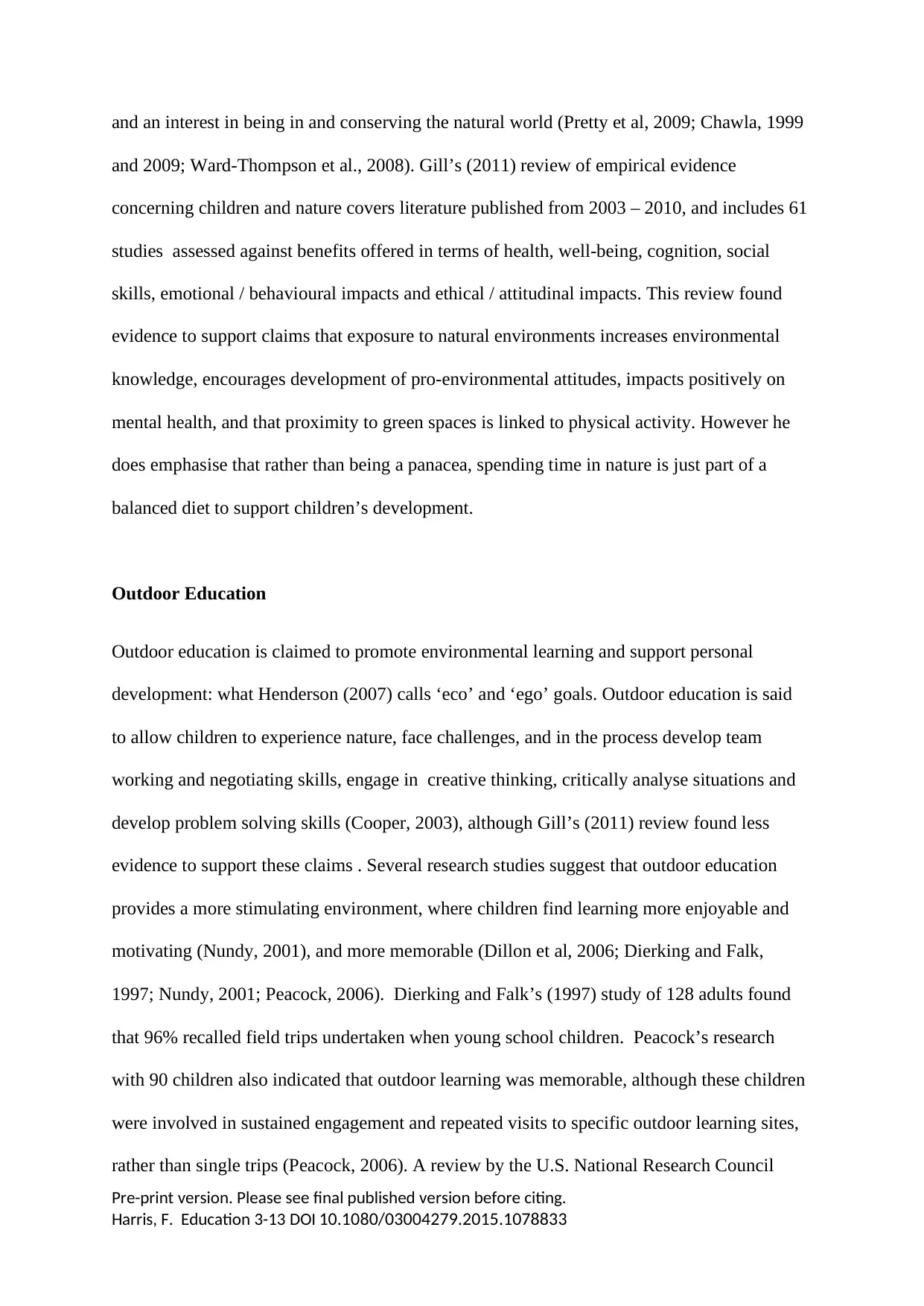
Pre-print version. Please see final published version before citing.
Harris, F. Education 3-13 DOI 10.1080/03004279.2015.1078833
and an interest in being in and conserving the natural world (Pretty et al, 2009; Chawla, 1999
and 2009; Ward-Thompson et al., 2008). Gill’s (2011) review of empirical evidence
concerning children and nature covers literature published from 2003 – 2010, and includes 61
studies assessed against benefits offered in terms of health, well-being, cognition, social
skills, emotional / behavioural impacts and ethical / attitudinal impacts. This review found
evidence to support claims that exposure to natural environments increases environmental
knowledge, encourages development of pro-environmental attitudes, impacts positively on
mental health, and that proximity to green spaces is linked to physical activity. However he
does emphasise that rather than being a panacea, spending time in nature is just part of a
balanced diet to support children’s development.
Outdoor Education
Outdoor education is claimed to promote environmental learning and support personal
development: what Henderson (2007) calls ‘eco’ and ‘ego’ goals. Outdoor education is said
to allow children to experience nature, face challenges, and in the process develop team
working and negotiating skills, engage in creative thinking, critically analyse situations and
develop problem solving skills (Cooper, 2003), although Gill’s (2011) review found less
evidence to support these claims . Several research studies suggest that outdoor education
provides a more stimulating environment, where children find learning more enjoyable and
motivating (Nundy, 2001), and more memorable (Dillon et al, 2006; Dierking and Falk,
1997; Nundy, 2001; Peacock, 2006). Dierking and Falk’s (1997) study of 128 adults found
that 96% recalled field trips undertaken when young school children. Peacock’s research
with 90 children also indicated that outdoor learning was memorable, although these children
were involved in sustained engagement and repeated visits to specific outdoor learning sites,
rather than single trips (Peacock, 2006). A review by the U.S. National Research Council
Harris, F. Education 3-13 DOI 10.1080/03004279.2015.1078833
and an interest in being in and conserving the natural world (Pretty et al, 2009; Chawla, 1999
and 2009; Ward-Thompson et al., 2008). Gill’s (2011) review of empirical evidence
concerning children and nature covers literature published from 2003 – 2010, and includes 61
studies assessed against benefits offered in terms of health, well-being, cognition, social
skills, emotional / behavioural impacts and ethical / attitudinal impacts. This review found
evidence to support claims that exposure to natural environments increases environmental
knowledge, encourages development of pro-environmental attitudes, impacts positively on
mental health, and that proximity to green spaces is linked to physical activity. However he
does emphasise that rather than being a panacea, spending time in nature is just part of a
balanced diet to support children’s development.
Outdoor Education
Outdoor education is claimed to promote environmental learning and support personal
development: what Henderson (2007) calls ‘eco’ and ‘ego’ goals. Outdoor education is said
to allow children to experience nature, face challenges, and in the process develop team
working and negotiating skills, engage in creative thinking, critically analyse situations and
develop problem solving skills (Cooper, 2003), although Gill’s (2011) review found less
evidence to support these claims . Several research studies suggest that outdoor education
provides a more stimulating environment, where children find learning more enjoyable and
motivating (Nundy, 2001), and more memorable (Dillon et al, 2006; Dierking and Falk,
1997; Nundy, 2001; Peacock, 2006). Dierking and Falk’s (1997) study of 128 adults found
that 96% recalled field trips undertaken when young school children. Peacock’s research
with 90 children also indicated that outdoor learning was memorable, although these children
were involved in sustained engagement and repeated visits to specific outdoor learning sites,
rather than single trips (Peacock, 2006). A review by the U.S. National Research Council
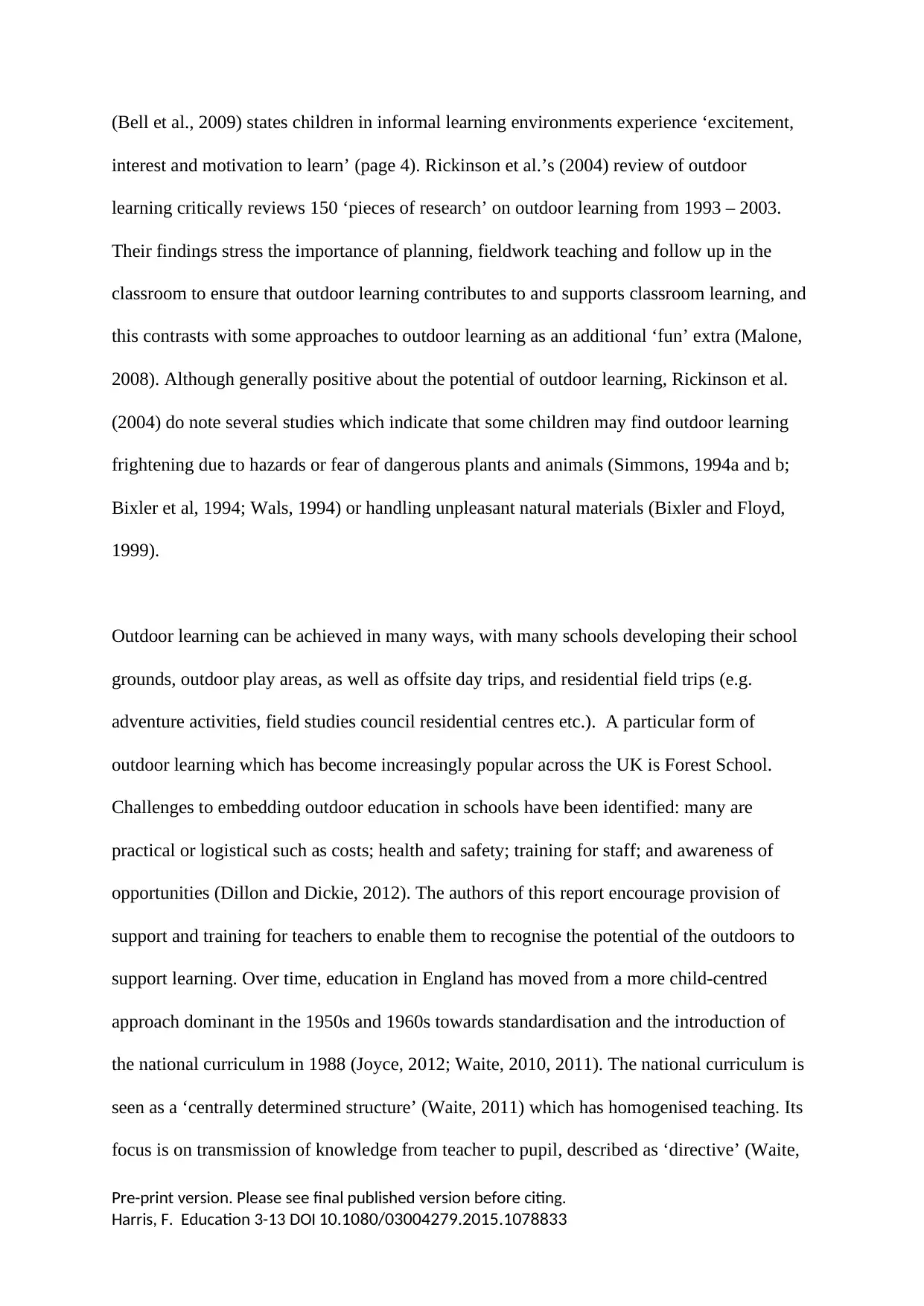
Pre-print version. Please see final published version before citing.
Harris, F. Education 3-13 DOI 10.1080/03004279.2015.1078833
(Bell et al., 2009) states children in informal learning environments experience ‘excitement,
interest and motivation to learn’ (page 4). Rickinson et al.’s (2004) review of outdoor
learning critically reviews 150 ‘pieces of research’ on outdoor learning from 1993 – 2003.
Their findings stress the importance of planning, fieldwork teaching and follow up in the
classroom to ensure that outdoor learning contributes to and supports classroom learning, and
this contrasts with some approaches to outdoor learning as an additional ‘fun’ extra (Malone,
2008). Although generally positive about the potential of outdoor learning, Rickinson et al.
(2004) do note several studies which indicate that some children may find outdoor learning
frightening due to hazards or fear of dangerous plants and animals (Simmons, 1994a and b;
Bixler et al, 1994; Wals, 1994) or handling unpleasant natural materials (Bixler and Floyd,
1999).
Outdoor learning can be achieved in many ways, with many schools developing their school
grounds, outdoor play areas, as well as offsite day trips, and residential field trips (e.g.
adventure activities, field studies council residential centres etc.). A particular form of
outdoor learning which has become increasingly popular across the UK is Forest School.
Challenges to embedding outdoor education in schools have been identified: many are
practical or logistical such as costs; health and safety; training for staff; and awareness of
opportunities (Dillon and Dickie, 2012). The authors of this report encourage provision of
support and training for teachers to enable them to recognise the potential of the outdoors to
support learning. Over time, education in England has moved from a more child-centred
approach dominant in the 1950s and 1960s towards standardisation and the introduction of
the national curriculum in 1988 (Joyce, 2012; Waite, 2010, 2011). The national curriculum is
seen as a ‘centrally determined structure’ (Waite, 2011) which has homogenised teaching. Its
focus is on transmission of knowledge from teacher to pupil, described as ‘directive’ (Waite,
Harris, F. Education 3-13 DOI 10.1080/03004279.2015.1078833
(Bell et al., 2009) states children in informal learning environments experience ‘excitement,
interest and motivation to learn’ (page 4). Rickinson et al.’s (2004) review of outdoor
learning critically reviews 150 ‘pieces of research’ on outdoor learning from 1993 – 2003.
Their findings stress the importance of planning, fieldwork teaching and follow up in the
classroom to ensure that outdoor learning contributes to and supports classroom learning, and
this contrasts with some approaches to outdoor learning as an additional ‘fun’ extra (Malone,
2008). Although generally positive about the potential of outdoor learning, Rickinson et al.
(2004) do note several studies which indicate that some children may find outdoor learning
frightening due to hazards or fear of dangerous plants and animals (Simmons, 1994a and b;
Bixler et al, 1994; Wals, 1994) or handling unpleasant natural materials (Bixler and Floyd,
1999).
Outdoor learning can be achieved in many ways, with many schools developing their school
grounds, outdoor play areas, as well as offsite day trips, and residential field trips (e.g.
adventure activities, field studies council residential centres etc.). A particular form of
outdoor learning which has become increasingly popular across the UK is Forest School.
Challenges to embedding outdoor education in schools have been identified: many are
practical or logistical such as costs; health and safety; training for staff; and awareness of
opportunities (Dillon and Dickie, 2012). The authors of this report encourage provision of
support and training for teachers to enable them to recognise the potential of the outdoors to
support learning. Over time, education in England has moved from a more child-centred
approach dominant in the 1950s and 1960s towards standardisation and the introduction of
the national curriculum in 1988 (Joyce, 2012; Waite, 2010, 2011). The national curriculum is
seen as a ‘centrally determined structure’ (Waite, 2011) which has homogenised teaching. Its
focus is on transmission of knowledge from teacher to pupil, described as ‘directive’ (Waite,
Secure Best Marks with AI Grader
Need help grading? Try our AI Grader for instant feedback on your assignments.

Pre-print version. Please see final published version before citing.
Harris, F. Education 3-13 DOI 10.1080/03004279.2015.1078833
2011). Excellence and raising standards have been the focus (DfES, 2003a), with league
tables of school performance to measure achievement. This audit culture, combined with
growing concerns for health and safety and risk aversion, presents a challenge for proponents
of outdoor learning and more child-led forms of teaching (Waite, 2010). The Rose Review of
the Primary Curriculum (Rose, 2009) called for cross-curricular learning, and Every Child
Matters (DfES, 2003b) encouraged consideration of children’s personal, social and emotional
development. The Learning Outside the Classroom manifesto (DfES, 2006) called for greater
diversity of learning sites, especially outdoor learning. Proponents of outdoor learning are
increasing (UK NEA 2011, Rickinson et al., 2004), and the council for learning outside the
classroom continues to champion outdoor learning. As concerns rise about time spent
outdoors and over-protection of children (Malone, 2007) forest school provides opportunities
for assessing and taking risks.
Education is at times perceived as a set of dichotomies: in the classroom or outdoors; teacher
led or child-led; outcome oriented or process oriented. There remain tensions between
meeting the demands of the national curriculum (pursuing excellence) and activities which
are seen as enriching the learning experience (ensuring enjoyment), with school trips and
non-core curricular activities often seen as contributing more to the latter, and less to the
former (Waite, 2011 ). Malone (2008 pg. 25) differentiates between ‘the real work in the
classroom and the additional ‘fun’ work outside the classroom’. Rea (2008) asks whether
outdoor learning should be an extension of classroom learning to an outdoor environment?
This paper considers how forest school practitioners facilitate different types of learning.
The emergence of Forest School
Harris, F. Education 3-13 DOI 10.1080/03004279.2015.1078833
2011). Excellence and raising standards have been the focus (DfES, 2003a), with league
tables of school performance to measure achievement. This audit culture, combined with
growing concerns for health and safety and risk aversion, presents a challenge for proponents
of outdoor learning and more child-led forms of teaching (Waite, 2010). The Rose Review of
the Primary Curriculum (Rose, 2009) called for cross-curricular learning, and Every Child
Matters (DfES, 2003b) encouraged consideration of children’s personal, social and emotional
development. The Learning Outside the Classroom manifesto (DfES, 2006) called for greater
diversity of learning sites, especially outdoor learning. Proponents of outdoor learning are
increasing (UK NEA 2011, Rickinson et al., 2004), and the council for learning outside the
classroom continues to champion outdoor learning. As concerns rise about time spent
outdoors and over-protection of children (Malone, 2007) forest school provides opportunities
for assessing and taking risks.
Education is at times perceived as a set of dichotomies: in the classroom or outdoors; teacher
led or child-led; outcome oriented or process oriented. There remain tensions between
meeting the demands of the national curriculum (pursuing excellence) and activities which
are seen as enriching the learning experience (ensuring enjoyment), with school trips and
non-core curricular activities often seen as contributing more to the latter, and less to the
former (Waite, 2011 ). Malone (2008 pg. 25) differentiates between ‘the real work in the
classroom and the additional ‘fun’ work outside the classroom’. Rea (2008) asks whether
outdoor learning should be an extension of classroom learning to an outdoor environment?
This paper considers how forest school practitioners facilitate different types of learning.
The emergence of Forest School
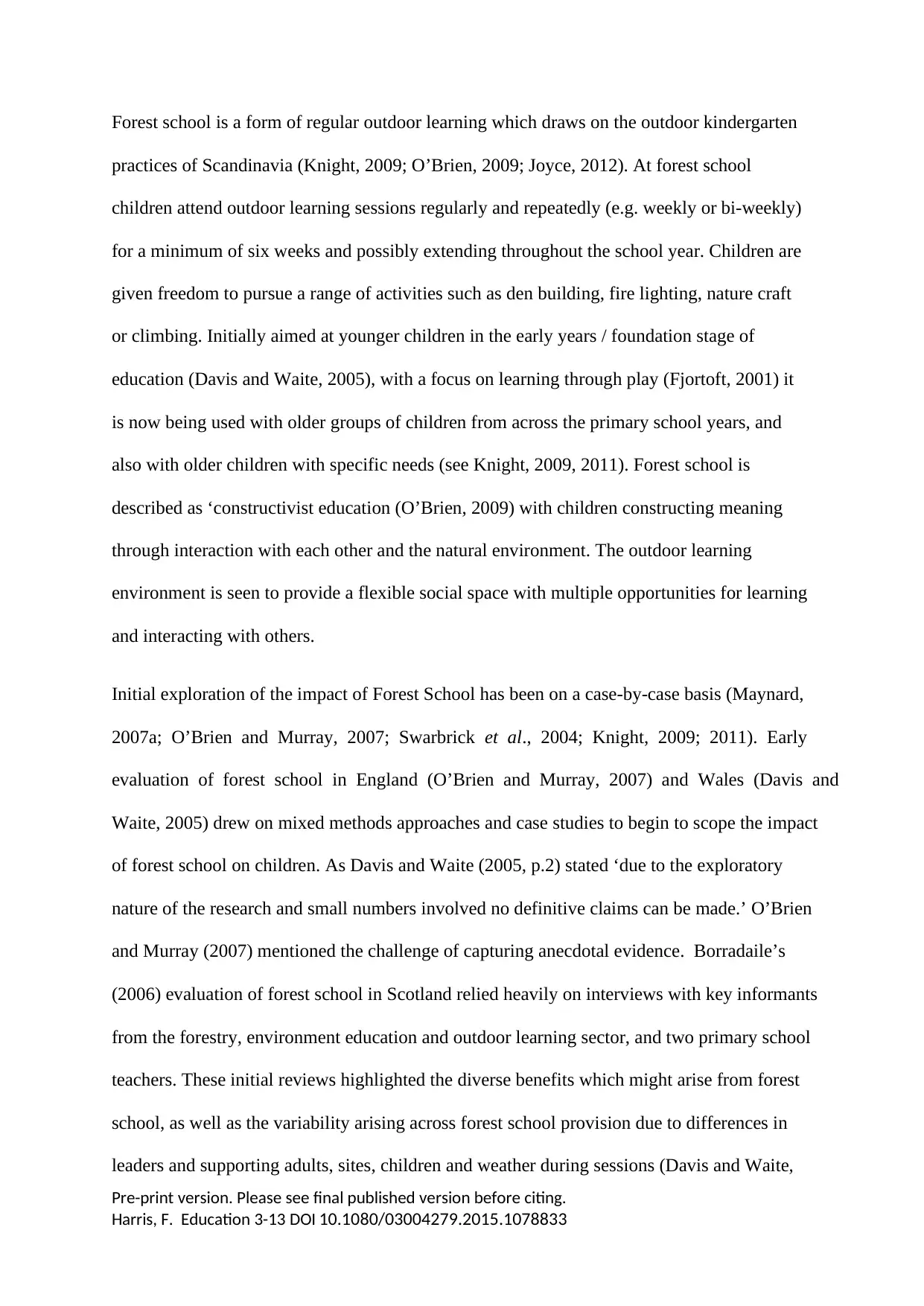
Pre-print version. Please see final published version before citing.
Harris, F. Education 3-13 DOI 10.1080/03004279.2015.1078833
Forest school is a form of regular outdoor learning which draws on the outdoor kindergarten
practices of Scandinavia (Knight, 2009; O’Brien, 2009; Joyce, 2012). At forest school
children attend outdoor learning sessions regularly and repeatedly (e.g. weekly or bi-weekly)
for a minimum of six weeks and possibly extending throughout the school year. Children are
given freedom to pursue a range of activities such as den building, fire lighting, nature craft
or climbing. Initially aimed at younger children in the early years / foundation stage of
education (Davis and Waite, 2005), with a focus on learning through play (Fjortoft, 2001) it
is now being used with older groups of children from across the primary school years, and
also with older children with specific needs (see Knight, 2009, 2011). Forest school is
described as ‘constructivist education (O’Brien, 2009) with children constructing meaning
through interaction with each other and the natural environment. The outdoor learning
environment is seen to provide a flexible social space with multiple opportunities for learning
and interacting with others.
Initial exploration of the impact of Forest School has been on a case-by-case basis (Maynard,
2007a; O’Brien and Murray, 2007; Swarbrick et al., 2004; Knight, 2009; 2011). Early
evaluation of forest school in England (O’Brien and Murray, 2007) and Wales (Davis and
Waite, 2005) drew on mixed methods approaches and case studies to begin to scope the impact
of forest school on children. As Davis and Waite (2005, p.2) stated ‘due to the exploratory
nature of the research and small numbers involved no definitive claims can be made.’ O’Brien
and Murray (2007) mentioned the challenge of capturing anecdotal evidence. Borradaile’s
(2006) evaluation of forest school in Scotland relied heavily on interviews with key informants
from the forestry, environment education and outdoor learning sector, and two primary school
teachers. These initial reviews highlighted the diverse benefits which might arise from forest
school, as well as the variability arising across forest school provision due to differences in
leaders and supporting adults, sites, children and weather during sessions (Davis and Waite,
Harris, F. Education 3-13 DOI 10.1080/03004279.2015.1078833
Forest school is a form of regular outdoor learning which draws on the outdoor kindergarten
practices of Scandinavia (Knight, 2009; O’Brien, 2009; Joyce, 2012). At forest school
children attend outdoor learning sessions regularly and repeatedly (e.g. weekly or bi-weekly)
for a minimum of six weeks and possibly extending throughout the school year. Children are
given freedom to pursue a range of activities such as den building, fire lighting, nature craft
or climbing. Initially aimed at younger children in the early years / foundation stage of
education (Davis and Waite, 2005), with a focus on learning through play (Fjortoft, 2001) it
is now being used with older groups of children from across the primary school years, and
also with older children with specific needs (see Knight, 2009, 2011). Forest school is
described as ‘constructivist education (O’Brien, 2009) with children constructing meaning
through interaction with each other and the natural environment. The outdoor learning
environment is seen to provide a flexible social space with multiple opportunities for learning
and interacting with others.
Initial exploration of the impact of Forest School has been on a case-by-case basis (Maynard,
2007a; O’Brien and Murray, 2007; Swarbrick et al., 2004; Knight, 2009; 2011). Early
evaluation of forest school in England (O’Brien and Murray, 2007) and Wales (Davis and
Waite, 2005) drew on mixed methods approaches and case studies to begin to scope the impact
of forest school on children. As Davis and Waite (2005, p.2) stated ‘due to the exploratory
nature of the research and small numbers involved no definitive claims can be made.’ O’Brien
and Murray (2007) mentioned the challenge of capturing anecdotal evidence. Borradaile’s
(2006) evaluation of forest school in Scotland relied heavily on interviews with key informants
from the forestry, environment education and outdoor learning sector, and two primary school
teachers. These initial reviews highlighted the diverse benefits which might arise from forest
school, as well as the variability arising across forest school provision due to differences in
leaders and supporting adults, sites, children and weather during sessions (Davis and Waite,

Pre-print version. Please see final published version before citing.
Harris, F. Education 3-13 DOI 10.1080/03004279.2015.1078833
2005). Subsequent more detailed studies often focus on a single purported benefit, drawing on
case studies or small cohorts. These studies suggest forest school aims to contribute to learning
in a range of ways: in addition to learning about the environment children learn social skills
and citizenship skills (Knight, 2009; Swarbrick et al., 2004), and it aims to support physical
and mental health (Lovell and Roe, 2009; Maynard, 2007).
Since these early studies forest school has becoming more widely adopted, as practitioners
argue that it is much more than “mucking about in a wood” (Ritchie, 2010) and provides a
valuable learning and development experience for children. This is an area where practice has
preceded debate and theoretical development. It is recognised that the effects of forest school in
primary school children needs further assessment to provide more robust evidence of whether the
investment in delivering forest schools is worthwhile and a call for more thorough research based
on a common methodology has been made (Murray, 2003). Formal research is hampered by the
practical and logistical considerations which preclude setting up a specific comparative
“trial” of the impacts of forest school on a large number of children under conditions of rigid
experimental control (Smith-Sebasto, 2000). The challenges of working in more detail with
larger cohorts was discussed in a seminar in 2010 (Harris et al., 2010) and key factors
included the identification of quantifiable outcomes that are easily and reliably measured in
the context of forest school sessions and activities. Use of pre and post tests is challenging in
small children who are still learning to read and write. Teachers’ data assessing children’s
attainment and development is often confidential and not accessible to external researchers.
Waite and Goodenough (2010) identified the role practitioners can play as ‘conduits of
evidence’ through their access to children participating in woodland activities, and claim that
through their training and skills in observation of children, practitioners will be able to
recognise when and how activates are affecting child participants. However they also
Harris, F. Education 3-13 DOI 10.1080/03004279.2015.1078833
2005). Subsequent more detailed studies often focus on a single purported benefit, drawing on
case studies or small cohorts. These studies suggest forest school aims to contribute to learning
in a range of ways: in addition to learning about the environment children learn social skills
and citizenship skills (Knight, 2009; Swarbrick et al., 2004), and it aims to support physical
and mental health (Lovell and Roe, 2009; Maynard, 2007).
Since these early studies forest school has becoming more widely adopted, as practitioners
argue that it is much more than “mucking about in a wood” (Ritchie, 2010) and provides a
valuable learning and development experience for children. This is an area where practice has
preceded debate and theoretical development. It is recognised that the effects of forest school in
primary school children needs further assessment to provide more robust evidence of whether the
investment in delivering forest schools is worthwhile and a call for more thorough research based
on a common methodology has been made (Murray, 2003). Formal research is hampered by the
practical and logistical considerations which preclude setting up a specific comparative
“trial” of the impacts of forest school on a large number of children under conditions of rigid
experimental control (Smith-Sebasto, 2000). The challenges of working in more detail with
larger cohorts was discussed in a seminar in 2010 (Harris et al., 2010) and key factors
included the identification of quantifiable outcomes that are easily and reliably measured in
the context of forest school sessions and activities. Use of pre and post tests is challenging in
small children who are still learning to read and write. Teachers’ data assessing children’s
attainment and development is often confidential and not accessible to external researchers.
Waite and Goodenough (2010) identified the role practitioners can play as ‘conduits of
evidence’ through their access to children participating in woodland activities, and claim that
through their training and skills in observation of children, practitioners will be able to
recognise when and how activates are affecting child participants. However they also
Paraphrase This Document
Need a fresh take? Get an instant paraphrase of this document with our AI Paraphraser

Pre-print version. Please see final published version before citing.
Harris, F. Education 3-13 DOI 10.1080/03004279.2015.1078833
recognised that many of the supposed benefits of forest school as ‘soft’ and harder to assess
and measure objectively. This highlights the need to move on from mall scale research and
anecdotal evidence, and instead work with those with longer term experiences of forest
school working cross a range of groups of children.
Forest school practitioners are specifically trained to gain a qualification to lead the sessions.
This involves training in the ethos of forest school (regular, repeated activities to allow
children to build skills and self-confidence), bushcraft skills; child development (schemas);
nurturing personal, social and emotional development through teamwork and managing
behaviour; and risk (risk assessments, health and safety first aid) (Archimedes training ltd,
nd). Practitioners come from a range of backgrounds, including school teachers, teaching
assistants, and those working in early years settings; environmental educators, (often working
for wild life trusts or conservation bodies) and those from bush craft / outdoor adventure
organisations. Many forest school leaders come together regularly in regional ‘cluster
groups’, developed by the forest education network (formerly Forest Education Initiative).
This community of practice (Lave and Wenger, 1991) allows forest school leaders to
exchange ideas for best practice for working with different age groups or specific groups of
children. Training is now ‘governed’ by the forest school association, which seeks to ensure
rigorous quality, as well as CPD to support leaders after qualification.
Method
This research was developed following a pilot study of forest school, which involved
participant observation of children attending weekly forest school sessions over a half-term
(5-6 weeks). The pilot study observed 6 cohorts of approximately 12 children each (total 72
Harris, F. Education 3-13 DOI 10.1080/03004279.2015.1078833
recognised that many of the supposed benefits of forest school as ‘soft’ and harder to assess
and measure objectively. This highlights the need to move on from mall scale research and
anecdotal evidence, and instead work with those with longer term experiences of forest
school working cross a range of groups of children.
Forest school practitioners are specifically trained to gain a qualification to lead the sessions.
This involves training in the ethos of forest school (regular, repeated activities to allow
children to build skills and self-confidence), bushcraft skills; child development (schemas);
nurturing personal, social and emotional development through teamwork and managing
behaviour; and risk (risk assessments, health and safety first aid) (Archimedes training ltd,
nd). Practitioners come from a range of backgrounds, including school teachers, teaching
assistants, and those working in early years settings; environmental educators, (often working
for wild life trusts or conservation bodies) and those from bush craft / outdoor adventure
organisations. Many forest school leaders come together regularly in regional ‘cluster
groups’, developed by the forest education network (formerly Forest Education Initiative).
This community of practice (Lave and Wenger, 1991) allows forest school leaders to
exchange ideas for best practice for working with different age groups or specific groups of
children. Training is now ‘governed’ by the forest school association, which seeks to ensure
rigorous quality, as well as CPD to support leaders after qualification.
Method
This research was developed following a pilot study of forest school, which involved
participant observation of children attending weekly forest school sessions over a half-term
(5-6 weeks). The pilot study observed 6 cohorts of approximately 12 children each (total 72
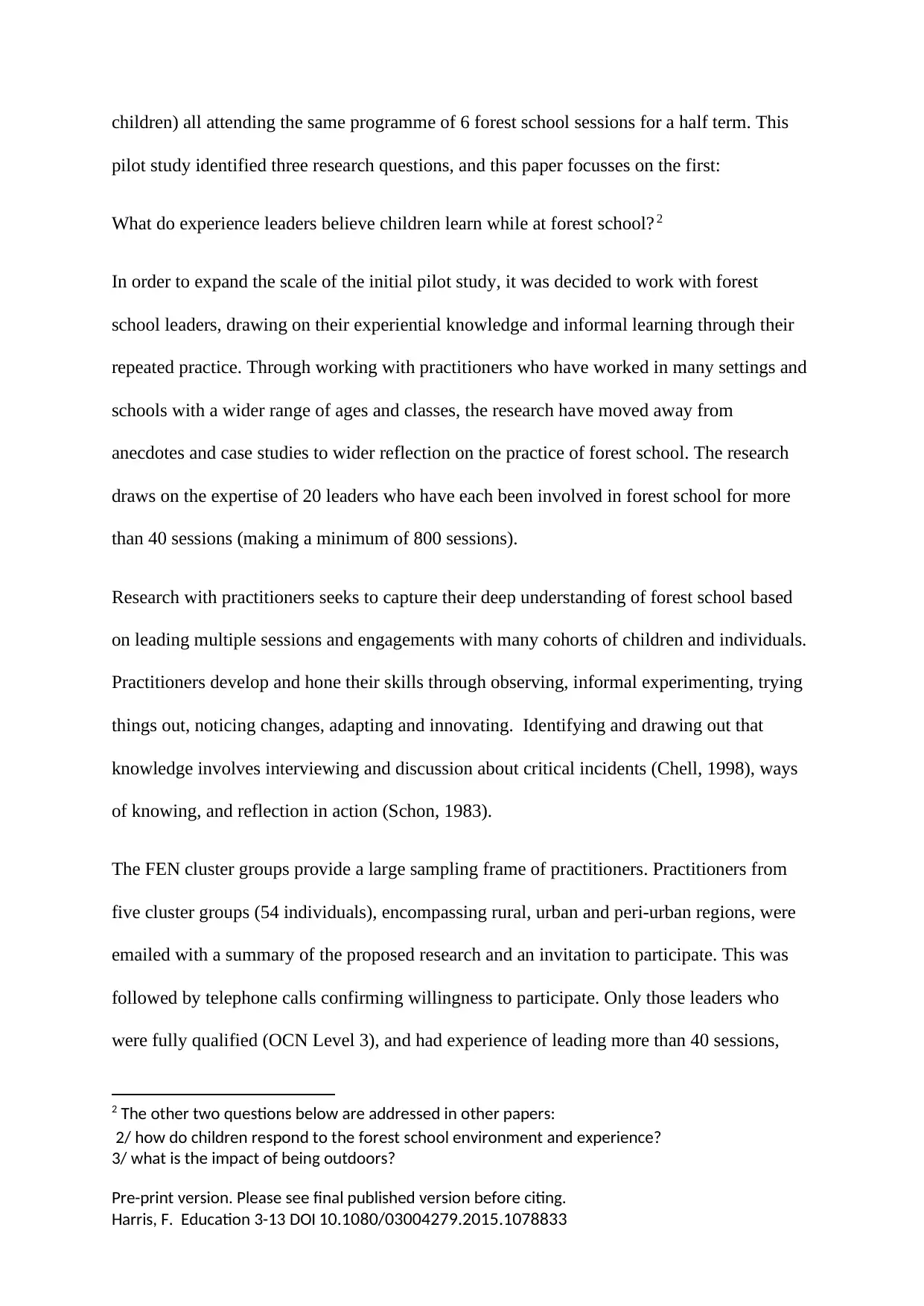
Pre-print version. Please see final published version before citing.
Harris, F. Education 3-13 DOI 10.1080/03004279.2015.1078833
children) all attending the same programme of 6 forest school sessions for a half term. This
pilot study identified three research questions, and this paper focusses on the first:
What do experience leaders believe children learn while at forest school? 2
In order to expand the scale of the initial pilot study, it was decided to work with forest
school leaders, drawing on their experiential knowledge and informal learning through their
repeated practice. Through working with practitioners who have worked in many settings and
schools with a wider range of ages and classes, the research have moved away from
anecdotes and case studies to wider reflection on the practice of forest school. The research
draws on the expertise of 20 leaders who have each been involved in forest school for more
than 40 sessions (making a minimum of 800 sessions).
Research with practitioners seeks to capture their deep understanding of forest school based
on leading multiple sessions and engagements with many cohorts of children and individuals.
Practitioners develop and hone their skills through observing, informal experimenting, trying
things out, noticing changes, adapting and innovating. Identifying and drawing out that
knowledge involves interviewing and discussion about critical incidents (Chell, 1998), ways
of knowing, and reflection in action (Schon, 1983).
The FEN cluster groups provide a large sampling frame of practitioners. Practitioners from
five cluster groups (54 individuals), encompassing rural, urban and peri-urban regions, were
emailed with a summary of the proposed research and an invitation to participate. This was
followed by telephone calls confirming willingness to participate. Only those leaders who
were fully qualified (OCN Level 3), and had experience of leading more than 40 sessions,
2 The other two questions below are addressed in other papers:
2/ how do children respond to the forest school environment and experience?
3/ what is the impact of being outdoors?
Harris, F. Education 3-13 DOI 10.1080/03004279.2015.1078833
children) all attending the same programme of 6 forest school sessions for a half term. This
pilot study identified three research questions, and this paper focusses on the first:
What do experience leaders believe children learn while at forest school? 2
In order to expand the scale of the initial pilot study, it was decided to work with forest
school leaders, drawing on their experiential knowledge and informal learning through their
repeated practice. Through working with practitioners who have worked in many settings and
schools with a wider range of ages and classes, the research have moved away from
anecdotes and case studies to wider reflection on the practice of forest school. The research
draws on the expertise of 20 leaders who have each been involved in forest school for more
than 40 sessions (making a minimum of 800 sessions).
Research with practitioners seeks to capture their deep understanding of forest school based
on leading multiple sessions and engagements with many cohorts of children and individuals.
Practitioners develop and hone their skills through observing, informal experimenting, trying
things out, noticing changes, adapting and innovating. Identifying and drawing out that
knowledge involves interviewing and discussion about critical incidents (Chell, 1998), ways
of knowing, and reflection in action (Schon, 1983).
The FEN cluster groups provide a large sampling frame of practitioners. Practitioners from
five cluster groups (54 individuals), encompassing rural, urban and peri-urban regions, were
emailed with a summary of the proposed research and an invitation to participate. This was
followed by telephone calls confirming willingness to participate. Only those leaders who
were fully qualified (OCN Level 3), and had experience of leading more than 40 sessions,
2 The other two questions below are addressed in other papers:
2/ how do children respond to the forest school environment and experience?
3/ what is the impact of being outdoors?
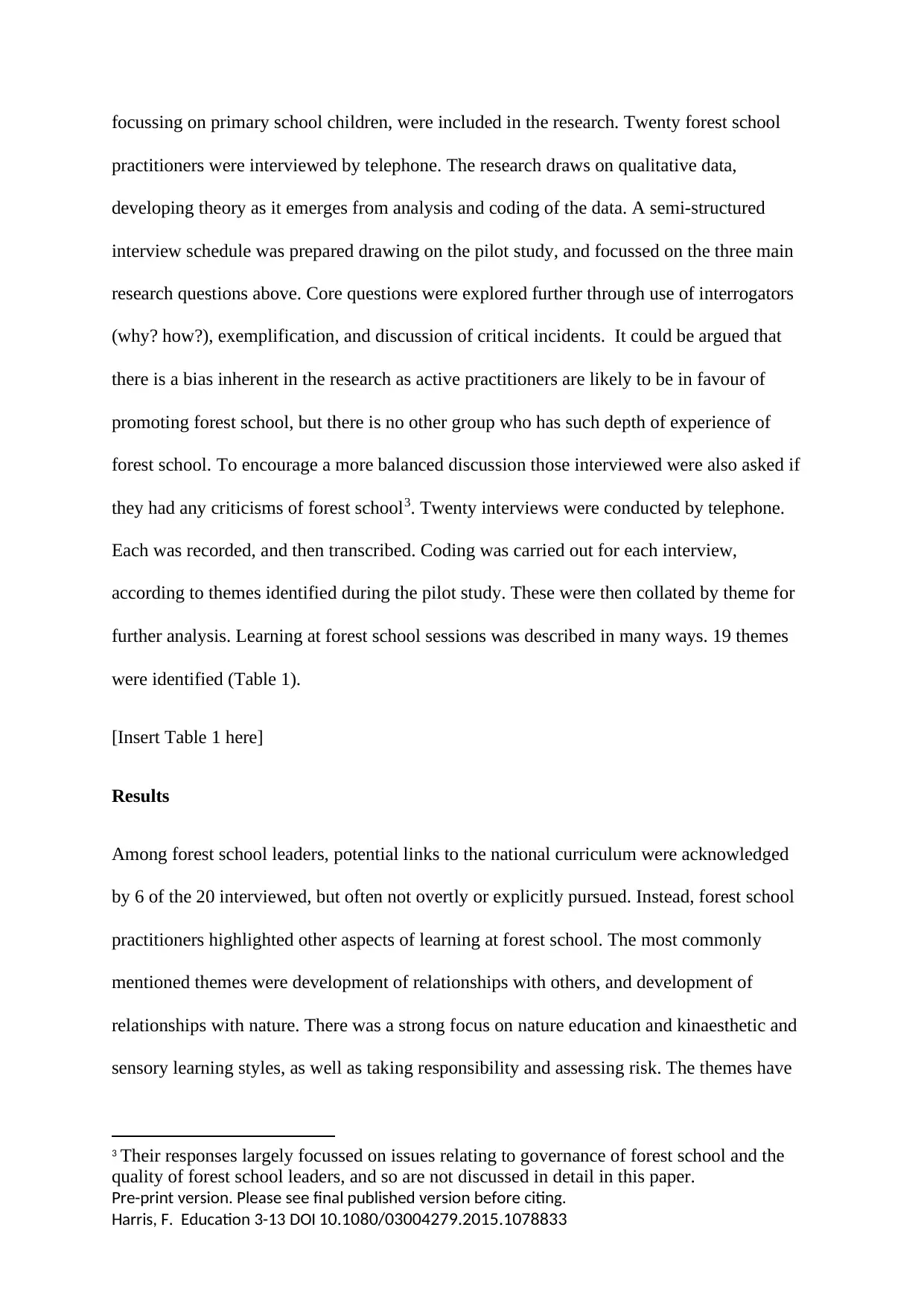
Pre-print version. Please see final published version before citing.
Harris, F. Education 3-13 DOI 10.1080/03004279.2015.1078833
focussing on primary school children, were included in the research. Twenty forest school
practitioners were interviewed by telephone. The research draws on qualitative data,
developing theory as it emerges from analysis and coding of the data. A semi-structured
interview schedule was prepared drawing on the pilot study, and focussed on the three main
research questions above. Core questions were explored further through use of interrogators
(why? how?), exemplification, and discussion of critical incidents. It could be argued that
there is a bias inherent in the research as active practitioners are likely to be in favour of
promoting forest school, but there is no other group who has such depth of experience of
forest school. To encourage a more balanced discussion those interviewed were also asked if
they had any criticisms of forest school3. Twenty interviews were conducted by telephone.
Each was recorded, and then transcribed. Coding was carried out for each interview,
according to themes identified during the pilot study. These were then collated by theme for
further analysis. Learning at forest school sessions was described in many ways. 19 themes
were identified (Table 1).
[Insert Table 1 here]
Results
Among forest school leaders, potential links to the national curriculum were acknowledged
by 6 of the 20 interviewed, but often not overtly or explicitly pursued. Instead, forest school
practitioners highlighted other aspects of learning at forest school. The most commonly
mentioned themes were development of relationships with others, and development of
relationships with nature. There was a strong focus on nature education and kinaesthetic and
sensory learning styles, as well as taking responsibility and assessing risk. The themes have
3 Their responses largely focussed on issues relating to governance of forest school and the
quality of forest school leaders, and so are not discussed in detail in this paper.
Harris, F. Education 3-13 DOI 10.1080/03004279.2015.1078833
focussing on primary school children, were included in the research. Twenty forest school
practitioners were interviewed by telephone. The research draws on qualitative data,
developing theory as it emerges from analysis and coding of the data. A semi-structured
interview schedule was prepared drawing on the pilot study, and focussed on the three main
research questions above. Core questions were explored further through use of interrogators
(why? how?), exemplification, and discussion of critical incidents. It could be argued that
there is a bias inherent in the research as active practitioners are likely to be in favour of
promoting forest school, but there is no other group who has such depth of experience of
forest school. To encourage a more balanced discussion those interviewed were also asked if
they had any criticisms of forest school3. Twenty interviews were conducted by telephone.
Each was recorded, and then transcribed. Coding was carried out for each interview,
according to themes identified during the pilot study. These were then collated by theme for
further analysis. Learning at forest school sessions was described in many ways. 19 themes
were identified (Table 1).
[Insert Table 1 here]
Results
Among forest school leaders, potential links to the national curriculum were acknowledged
by 6 of the 20 interviewed, but often not overtly or explicitly pursued. Instead, forest school
practitioners highlighted other aspects of learning at forest school. The most commonly
mentioned themes were development of relationships with others, and development of
relationships with nature. There was a strong focus on nature education and kinaesthetic and
sensory learning styles, as well as taking responsibility and assessing risk. The themes have
3 Their responses largely focussed on issues relating to governance of forest school and the
quality of forest school leaders, and so are not discussed in detail in this paper.
Secure Best Marks with AI Grader
Need help grading? Try our AI Grader for instant feedback on your assignments.
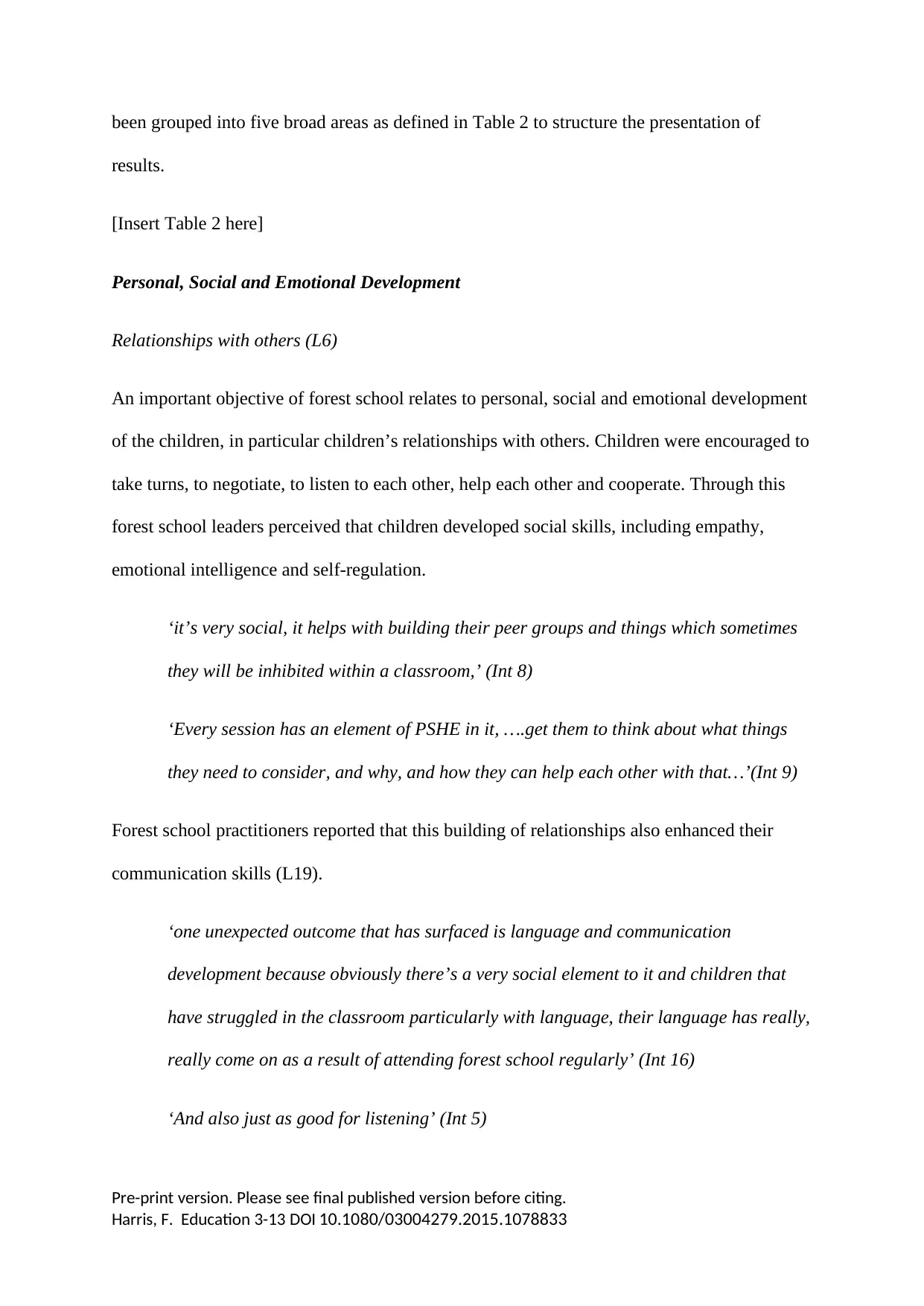
Pre-print version. Please see final published version before citing.
Harris, F. Education 3-13 DOI 10.1080/03004279.2015.1078833
been grouped into five broad areas as defined in Table 2 to structure the presentation of
results.
[Insert Table 2 here]
Personal, Social and Emotional Development
Relationships with others (L6)
An important objective of forest school relates to personal, social and emotional development
of the children, in particular children’s relationships with others. Children were encouraged to
take turns, to negotiate, to listen to each other, help each other and cooperate. Through this
forest school leaders perceived that children developed social skills, including empathy,
emotional intelligence and self-regulation.
‘it’s very social, it helps with building their peer groups and things which sometimes
they will be inhibited within a classroom,’ (Int 8)
‘Every session has an element of PSHE in it, ….get them to think about what things
they need to consider, and why, and how they can help each other with that…’(Int 9)
Forest school practitioners reported that this building of relationships also enhanced their
communication skills (L19).
‘one unexpected outcome that has surfaced is language and communication
development because obviously there’s a very social element to it and children that
have struggled in the classroom particularly with language, their language has really,
really come on as a result of attending forest school regularly’ (Int 16)
‘And also just as good for listening’ (Int 5)
Harris, F. Education 3-13 DOI 10.1080/03004279.2015.1078833
been grouped into five broad areas as defined in Table 2 to structure the presentation of
results.
[Insert Table 2 here]
Personal, Social and Emotional Development
Relationships with others (L6)
An important objective of forest school relates to personal, social and emotional development
of the children, in particular children’s relationships with others. Children were encouraged to
take turns, to negotiate, to listen to each other, help each other and cooperate. Through this
forest school leaders perceived that children developed social skills, including empathy,
emotional intelligence and self-regulation.
‘it’s very social, it helps with building their peer groups and things which sometimes
they will be inhibited within a classroom,’ (Int 8)
‘Every session has an element of PSHE in it, ….get them to think about what things
they need to consider, and why, and how they can help each other with that…’(Int 9)
Forest school practitioners reported that this building of relationships also enhanced their
communication skills (L19).
‘one unexpected outcome that has surfaced is language and communication
development because obviously there’s a very social element to it and children that
have struggled in the classroom particularly with language, their language has really,
really come on as a result of attending forest school regularly’ (Int 16)
‘And also just as good for listening’ (Int 5)
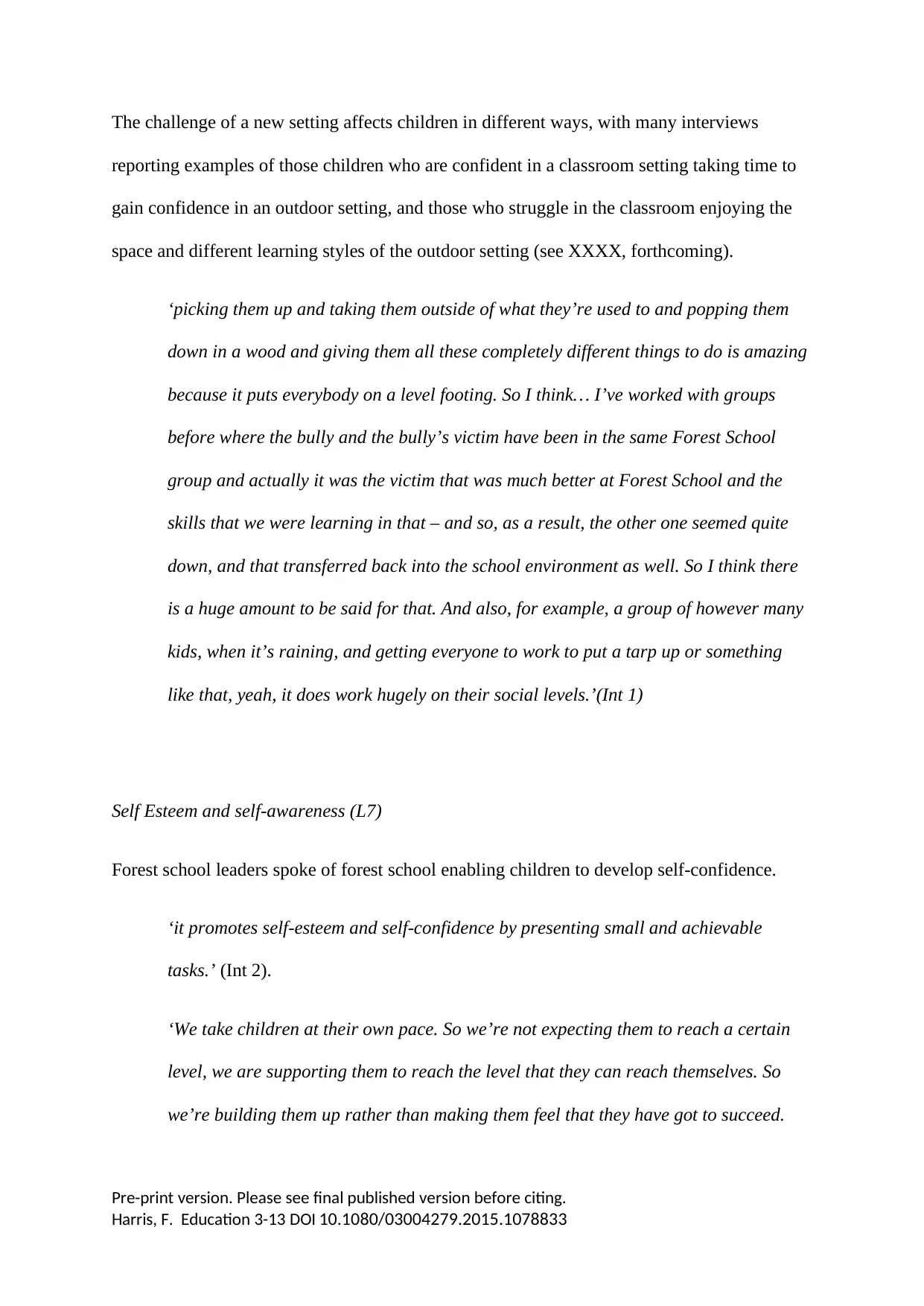
Pre-print version. Please see final published version before citing.
Harris, F. Education 3-13 DOI 10.1080/03004279.2015.1078833
The challenge of a new setting affects children in different ways, with many interviews
reporting examples of those children who are confident in a classroom setting taking time to
gain confidence in an outdoor setting, and those who struggle in the classroom enjoying the
space and different learning styles of the outdoor setting (see XXXX, forthcoming).
‘picking them up and taking them outside of what they’re used to and popping them
down in a wood and giving them all these completely different things to do is amazing
because it puts everybody on a level footing. So I think… I’ve worked with groups
before where the bully and the bully’s victim have been in the same Forest School
group and actually it was the victim that was much better at Forest School and the
skills that we were learning in that – and so, as a result, the other one seemed quite
down, and that transferred back into the school environment as well. So I think there
is a huge amount to be said for that. And also, for example, a group of however many
kids, when it’s raining, and getting everyone to work to put a tarp up or something
like that, yeah, it does work hugely on their social levels.’(Int 1)
Self Esteem and self-awareness (L7)
Forest school leaders spoke of forest school enabling children to develop self-confidence.
‘it promotes self-esteem and self-confidence by presenting small and achievable
tasks.’ (Int 2).
‘We take children at their own pace. So we’re not expecting them to reach a certain
level, we are supporting them to reach the level that they can reach themselves. So
we’re building them up rather than making them feel that they have got to succeed.
Harris, F. Education 3-13 DOI 10.1080/03004279.2015.1078833
The challenge of a new setting affects children in different ways, with many interviews
reporting examples of those children who are confident in a classroom setting taking time to
gain confidence in an outdoor setting, and those who struggle in the classroom enjoying the
space and different learning styles of the outdoor setting (see XXXX, forthcoming).
‘picking them up and taking them outside of what they’re used to and popping them
down in a wood and giving them all these completely different things to do is amazing
because it puts everybody on a level footing. So I think… I’ve worked with groups
before where the bully and the bully’s victim have been in the same Forest School
group and actually it was the victim that was much better at Forest School and the
skills that we were learning in that – and so, as a result, the other one seemed quite
down, and that transferred back into the school environment as well. So I think there
is a huge amount to be said for that. And also, for example, a group of however many
kids, when it’s raining, and getting everyone to work to put a tarp up or something
like that, yeah, it does work hugely on their social levels.’(Int 1)
Self Esteem and self-awareness (L7)
Forest school leaders spoke of forest school enabling children to develop self-confidence.
‘it promotes self-esteem and self-confidence by presenting small and achievable
tasks.’ (Int 2).
‘We take children at their own pace. So we’re not expecting them to reach a certain
level, we are supporting them to reach the level that they can reach themselves. So
we’re building them up rather than making them feel that they have got to succeed.
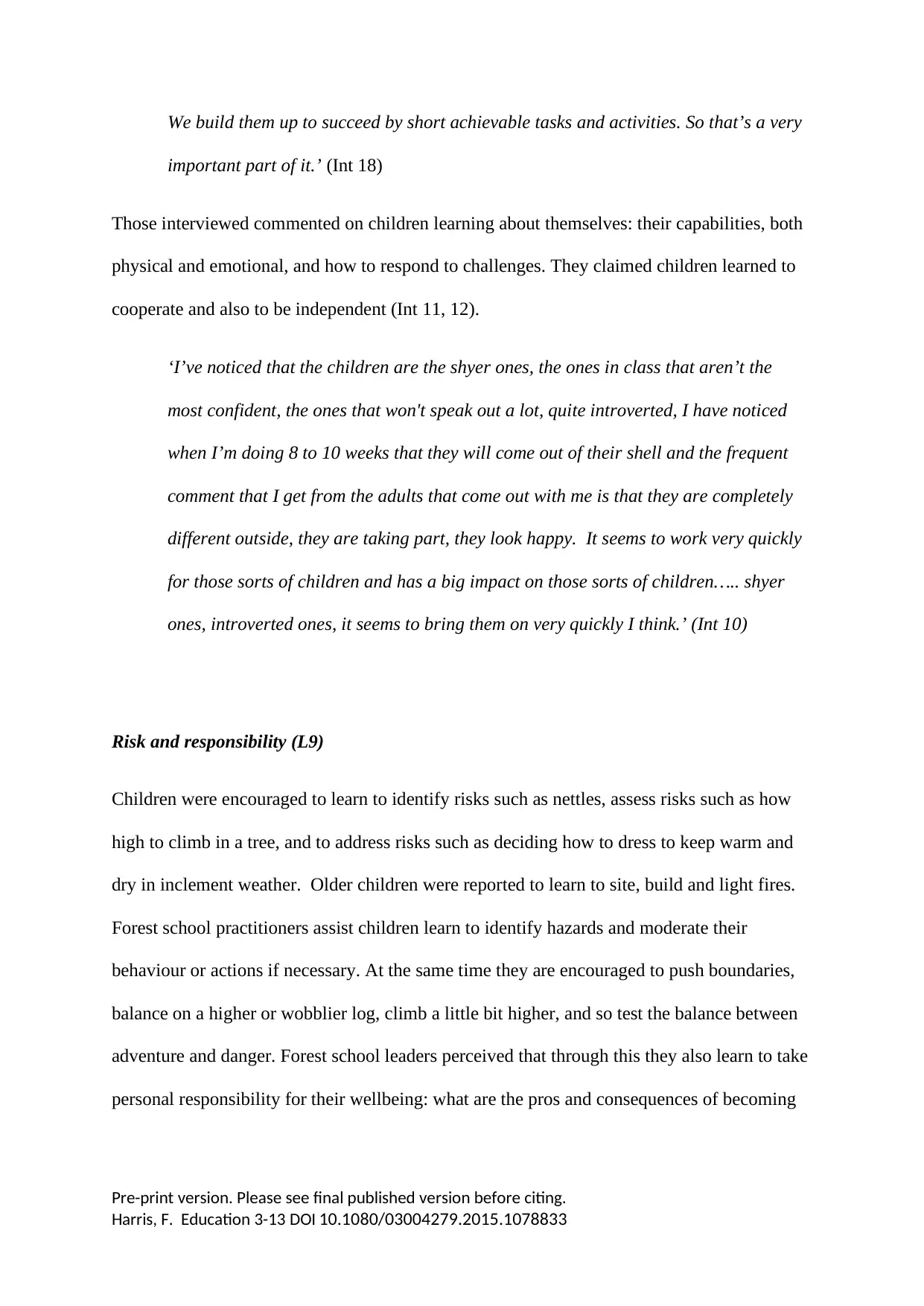
Pre-print version. Please see final published version before citing.
Harris, F. Education 3-13 DOI 10.1080/03004279.2015.1078833
We build them up to succeed by short achievable tasks and activities. So that’s a very
important part of it.’ (Int 18)
Those interviewed commented on children learning about themselves: their capabilities, both
physical and emotional, and how to respond to challenges. They claimed children learned to
cooperate and also to be independent (Int 11, 12).
‘I’ve noticed that the children are the shyer ones, the ones in class that aren’t the
most confident, the ones that won't speak out a lot, quite introverted, I have noticed
when I’m doing 8 to 10 weeks that they will come out of their shell and the frequent
comment that I get from the adults that come out with me is that they are completely
different outside, they are taking part, they look happy. It seems to work very quickly
for those sorts of children and has a big impact on those sorts of children….. shyer
ones, introverted ones, it seems to bring them on very quickly I think.’ (Int 10)
Risk and responsibility (L9)
Children were encouraged to learn to identify risks such as nettles, assess risks such as how
high to climb in a tree, and to address risks such as deciding how to dress to keep warm and
dry in inclement weather. Older children were reported to learn to site, build and light fires.
Forest school practitioners assist children learn to identify hazards and moderate their
behaviour or actions if necessary. At the same time they are encouraged to push boundaries,
balance on a higher or wobblier log, climb a little bit higher, and so test the balance between
adventure and danger. Forest school leaders perceived that through this they also learn to take
personal responsibility for their wellbeing: what are the pros and consequences of becoming
Harris, F. Education 3-13 DOI 10.1080/03004279.2015.1078833
We build them up to succeed by short achievable tasks and activities. So that’s a very
important part of it.’ (Int 18)
Those interviewed commented on children learning about themselves: their capabilities, both
physical and emotional, and how to respond to challenges. They claimed children learned to
cooperate and also to be independent (Int 11, 12).
‘I’ve noticed that the children are the shyer ones, the ones in class that aren’t the
most confident, the ones that won't speak out a lot, quite introverted, I have noticed
when I’m doing 8 to 10 weeks that they will come out of their shell and the frequent
comment that I get from the adults that come out with me is that they are completely
different outside, they are taking part, they look happy. It seems to work very quickly
for those sorts of children and has a big impact on those sorts of children….. shyer
ones, introverted ones, it seems to bring them on very quickly I think.’ (Int 10)
Risk and responsibility (L9)
Children were encouraged to learn to identify risks such as nettles, assess risks such as how
high to climb in a tree, and to address risks such as deciding how to dress to keep warm and
dry in inclement weather. Older children were reported to learn to site, build and light fires.
Forest school practitioners assist children learn to identify hazards and moderate their
behaviour or actions if necessary. At the same time they are encouraged to push boundaries,
balance on a higher or wobblier log, climb a little bit higher, and so test the balance between
adventure and danger. Forest school leaders perceived that through this they also learn to take
personal responsibility for their wellbeing: what are the pros and consequences of becoming
Paraphrase This Document
Need a fresh take? Get an instant paraphrase of this document with our AI Paraphraser
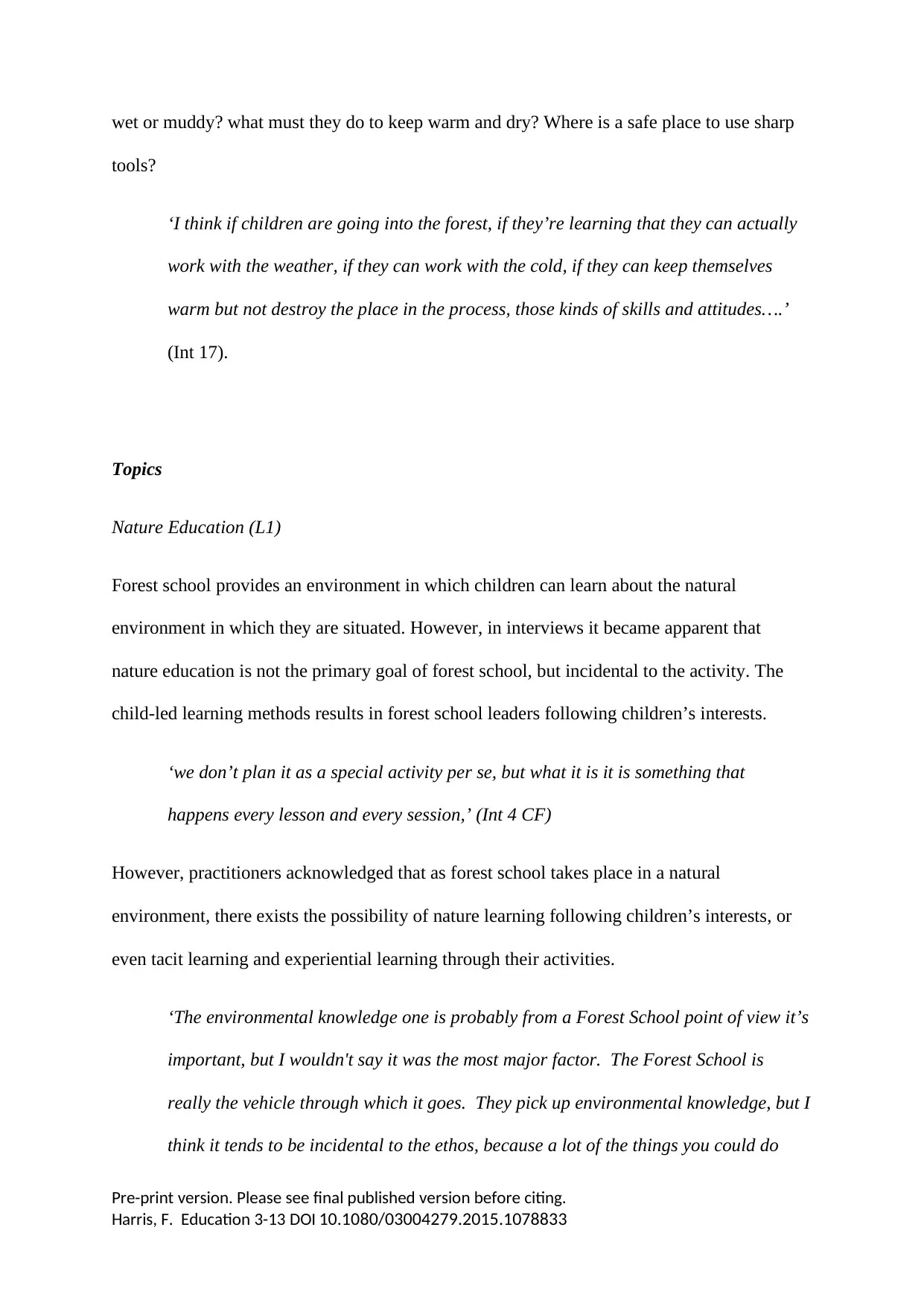
Pre-print version. Please see final published version before citing.
Harris, F. Education 3-13 DOI 10.1080/03004279.2015.1078833
wet or muddy? what must they do to keep warm and dry? Where is a safe place to use sharp
tools?
‘I think if children are going into the forest, if they’re learning that they can actually
work with the weather, if they can work with the cold, if they can keep themselves
warm but not destroy the place in the process, those kinds of skills and attitudes….’
(Int 17).
Topics
Nature Education (L1)
Forest school provides an environment in which children can learn about the natural
environment in which they are situated. However, in interviews it became apparent that
nature education is not the primary goal of forest school, but incidental to the activity. The
child-led learning methods results in forest school leaders following children’s interests.
‘we don’t plan it as a special activity per se, but what it is it is something that
happens every lesson and every session,’ (Int 4 CF)
However, practitioners acknowledged that as forest school takes place in a natural
environment, there exists the possibility of nature learning following children’s interests, or
even tacit learning and experiential learning through their activities.
‘The environmental knowledge one is probably from a Forest School point of view it’s
important, but I wouldn't say it was the most major factor. The Forest School is
really the vehicle through which it goes. They pick up environmental knowledge, but I
think it tends to be incidental to the ethos, because a lot of the things you could do
Harris, F. Education 3-13 DOI 10.1080/03004279.2015.1078833
wet or muddy? what must they do to keep warm and dry? Where is a safe place to use sharp
tools?
‘I think if children are going into the forest, if they’re learning that they can actually
work with the weather, if they can work with the cold, if they can keep themselves
warm but not destroy the place in the process, those kinds of skills and attitudes….’
(Int 17).
Topics
Nature Education (L1)
Forest school provides an environment in which children can learn about the natural
environment in which they are situated. However, in interviews it became apparent that
nature education is not the primary goal of forest school, but incidental to the activity. The
child-led learning methods results in forest school leaders following children’s interests.
‘we don’t plan it as a special activity per se, but what it is it is something that
happens every lesson and every session,’ (Int 4 CF)
However, practitioners acknowledged that as forest school takes place in a natural
environment, there exists the possibility of nature learning following children’s interests, or
even tacit learning and experiential learning through their activities.
‘The environmental knowledge one is probably from a Forest School point of view it’s
important, but I wouldn't say it was the most major factor. The Forest School is
really the vehicle through which it goes. They pick up environmental knowledge, but I
think it tends to be incidental to the ethos, because a lot of the things you could do
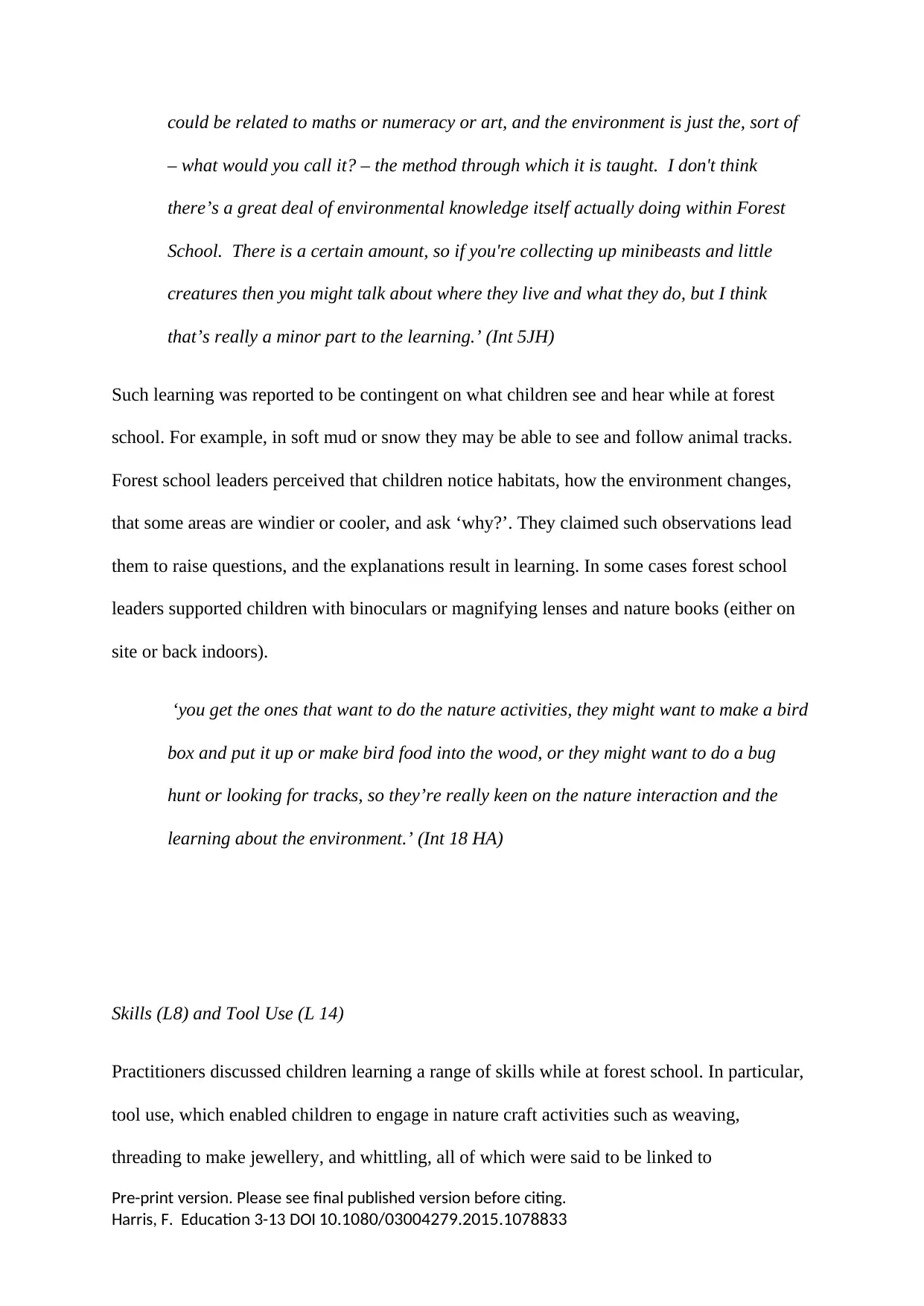
Pre-print version. Please see final published version before citing.
Harris, F. Education 3-13 DOI 10.1080/03004279.2015.1078833
could be related to maths or numeracy or art, and the environment is just the, sort of
– what would you call it? – the method through which it is taught. I don't think
there’s a great deal of environmental knowledge itself actually doing within Forest
School. There is a certain amount, so if you're collecting up minibeasts and little
creatures then you might talk about where they live and what they do, but I think
that’s really a minor part to the learning.’ (Int 5JH)
Such learning was reported to be contingent on what children see and hear while at forest
school. For example, in soft mud or snow they may be able to see and follow animal tracks.
Forest school leaders perceived that children notice habitats, how the environment changes,
that some areas are windier or cooler, and ask ‘why?’. They claimed such observations lead
them to raise questions, and the explanations result in learning. In some cases forest school
leaders supported children with binoculars or magnifying lenses and nature books (either on
site or back indoors).
‘you get the ones that want to do the nature activities, they might want to make a bird
box and put it up or make bird food into the wood, or they might want to do a bug
hunt or looking for tracks, so they’re really keen on the nature interaction and the
learning about the environment.’ (Int 18 HA)
Skills (L8) and Tool Use (L 14)
Practitioners discussed children learning a range of skills while at forest school. In particular,
tool use, which enabled children to engage in nature craft activities such as weaving,
threading to make jewellery, and whittling, all of which were said to be linked to
Harris, F. Education 3-13 DOI 10.1080/03004279.2015.1078833
could be related to maths or numeracy or art, and the environment is just the, sort of
– what would you call it? – the method through which it is taught. I don't think
there’s a great deal of environmental knowledge itself actually doing within Forest
School. There is a certain amount, so if you're collecting up minibeasts and little
creatures then you might talk about where they live and what they do, but I think
that’s really a minor part to the learning.’ (Int 5JH)
Such learning was reported to be contingent on what children see and hear while at forest
school. For example, in soft mud or snow they may be able to see and follow animal tracks.
Forest school leaders perceived that children notice habitats, how the environment changes,
that some areas are windier or cooler, and ask ‘why?’. They claimed such observations lead
them to raise questions, and the explanations result in learning. In some cases forest school
leaders supported children with binoculars or magnifying lenses and nature books (either on
site or back indoors).
‘you get the ones that want to do the nature activities, they might want to make a bird
box and put it up or make bird food into the wood, or they might want to do a bug
hunt or looking for tracks, so they’re really keen on the nature interaction and the
learning about the environment.’ (Int 18 HA)
Skills (L8) and Tool Use (L 14)
Practitioners discussed children learning a range of skills while at forest school. In particular,
tool use, which enabled children to engage in nature craft activities such as weaving,
threading to make jewellery, and whittling, all of which were said to be linked to
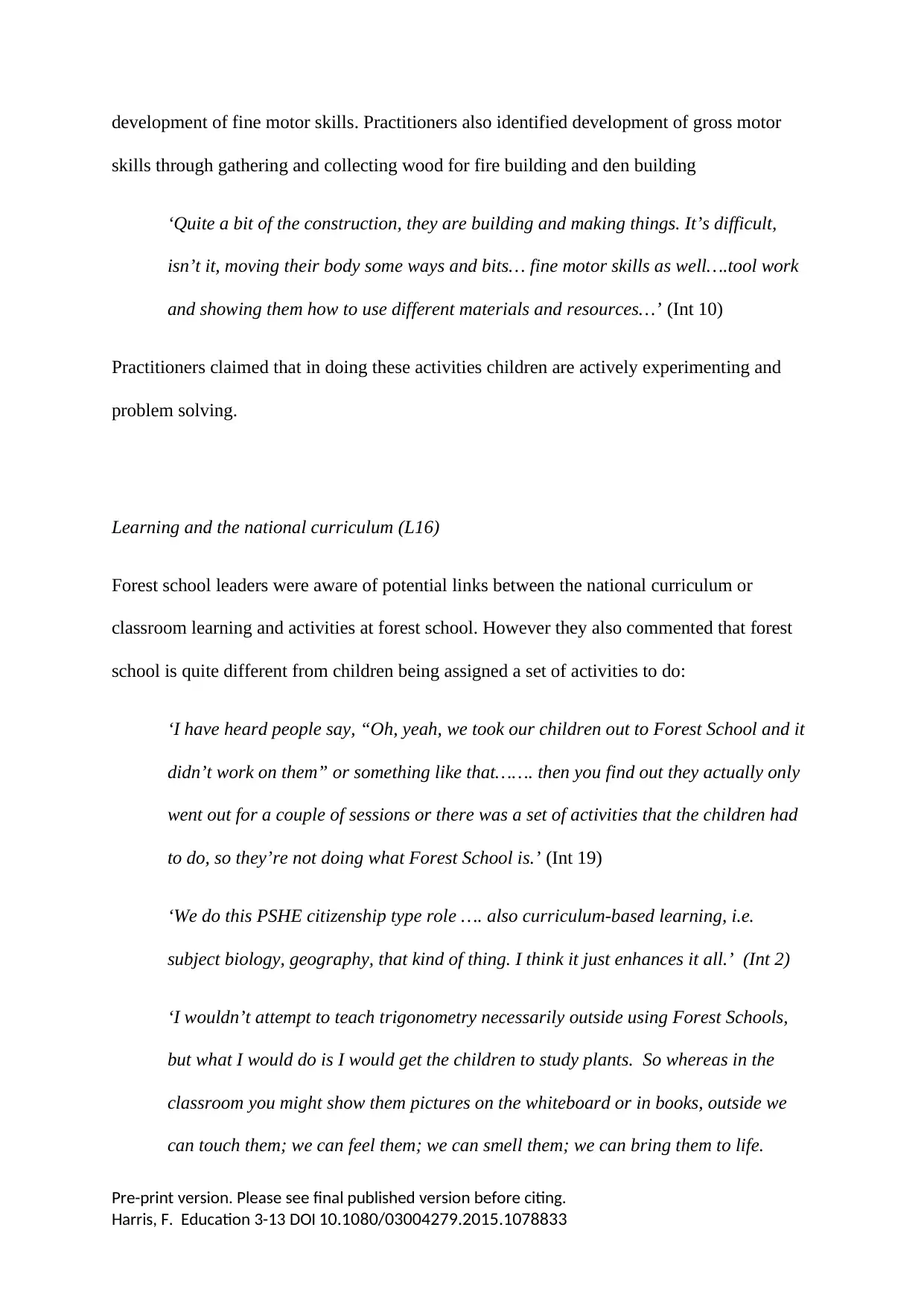
Pre-print version. Please see final published version before citing.
Harris, F. Education 3-13 DOI 10.1080/03004279.2015.1078833
development of fine motor skills. Practitioners also identified development of gross motor
skills through gathering and collecting wood for fire building and den building
‘Quite a bit of the construction, they are building and making things. It’s difficult,
isn’t it, moving their body some ways and bits… fine motor skills as well….tool work
and showing them how to use different materials and resources…’ (Int 10)
Practitioners claimed that in doing these activities children are actively experimenting and
problem solving.
Learning and the national curriculum (L16)
Forest school leaders were aware of potential links between the national curriculum or
classroom learning and activities at forest school. However they also commented that forest
school is quite different from children being assigned a set of activities to do:
‘I have heard people say, “Oh, yeah, we took our children out to Forest School and it
didn’t work on them” or something like that……. then you find out they actually only
went out for a couple of sessions or there was a set of activities that the children had
to do, so they’re not doing what Forest School is.’ (Int 19)
‘We do this PSHE citizenship type role …. also curriculum-based learning, i.e.
subject biology, geography, that kind of thing. I think it just enhances it all.’ (Int 2)
‘I wouldn’t attempt to teach trigonometry necessarily outside using Forest Schools,
but what I would do is I would get the children to study plants. So whereas in the
classroom you might show them pictures on the whiteboard or in books, outside we
can touch them; we can feel them; we can smell them; we can bring them to life.
Harris, F. Education 3-13 DOI 10.1080/03004279.2015.1078833
development of fine motor skills. Practitioners also identified development of gross motor
skills through gathering and collecting wood for fire building and den building
‘Quite a bit of the construction, they are building and making things. It’s difficult,
isn’t it, moving their body some ways and bits… fine motor skills as well….tool work
and showing them how to use different materials and resources…’ (Int 10)
Practitioners claimed that in doing these activities children are actively experimenting and
problem solving.
Learning and the national curriculum (L16)
Forest school leaders were aware of potential links between the national curriculum or
classroom learning and activities at forest school. However they also commented that forest
school is quite different from children being assigned a set of activities to do:
‘I have heard people say, “Oh, yeah, we took our children out to Forest School and it
didn’t work on them” or something like that……. then you find out they actually only
went out for a couple of sessions or there was a set of activities that the children had
to do, so they’re not doing what Forest School is.’ (Int 19)
‘We do this PSHE citizenship type role …. also curriculum-based learning, i.e.
subject biology, geography, that kind of thing. I think it just enhances it all.’ (Int 2)
‘I wouldn’t attempt to teach trigonometry necessarily outside using Forest Schools,
but what I would do is I would get the children to study plants. So whereas in the
classroom you might show them pictures on the whiteboard or in books, outside we
can touch them; we can feel them; we can smell them; we can bring them to life.
Secure Best Marks with AI Grader
Need help grading? Try our AI Grader for instant feedback on your assignments.
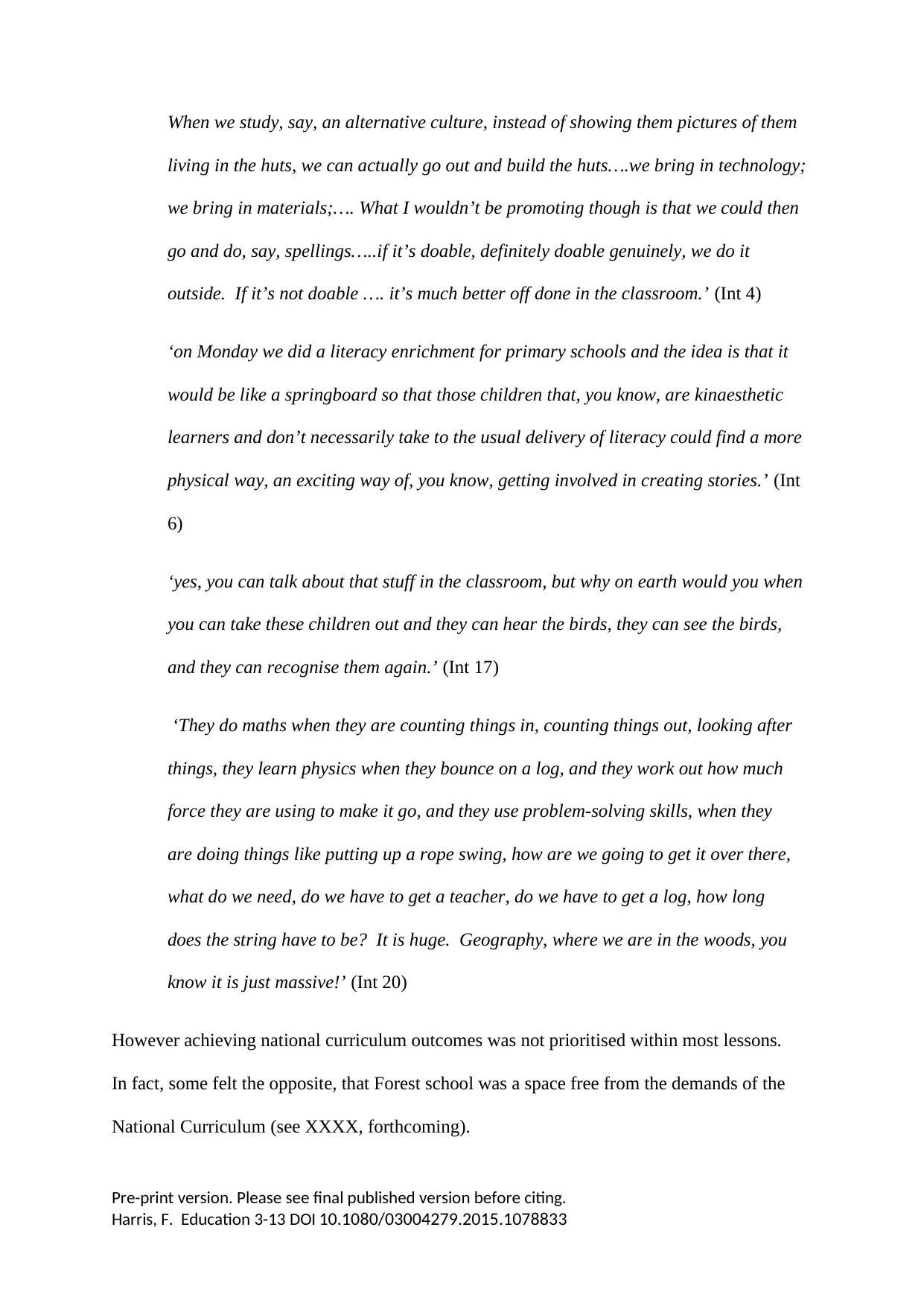
Pre-print version. Please see final published version before citing.
Harris, F. Education 3-13 DOI 10.1080/03004279.2015.1078833
When we study, say, an alternative culture, instead of showing them pictures of them
living in the huts, we can actually go out and build the huts….we bring in technology;
we bring in materials;…. What I wouldn’t be promoting though is that we could then
go and do, say, spellings…..if it’s doable, definitely doable genuinely, we do it
outside. If it’s not doable …. it’s much better off done in the classroom.’ (Int 4)
‘on Monday we did a literacy enrichment for primary schools and the idea is that it
would be like a springboard so that those children that, you know, are kinaesthetic
learners and don’t necessarily take to the usual delivery of literacy could find a more
physical way, an exciting way of, you know, getting involved in creating stories.’ (Int
6)
‘yes, you can talk about that stuff in the classroom, but why on earth would you when
you can take these children out and they can hear the birds, they can see the birds,
and they can recognise them again.’ (Int 17)
‘They do maths when they are counting things in, counting things out, looking after
things, they learn physics when they bounce on a log, and they work out how much
force they are using to make it go, and they use problem-solving skills, when they
are doing things like putting up a rope swing, how are we going to get it over there,
what do we need, do we have to get a teacher, do we have to get a log, how long
does the string have to be? It is huge. Geography, where we are in the woods, you
know it is just massive!’ (Int 20)
However achieving national curriculum outcomes was not prioritised within most lessons.
In fact, some felt the opposite, that Forest school was a space free from the demands of the
National Curriculum (see XXXX, forthcoming).
Harris, F. Education 3-13 DOI 10.1080/03004279.2015.1078833
When we study, say, an alternative culture, instead of showing them pictures of them
living in the huts, we can actually go out and build the huts….we bring in technology;
we bring in materials;…. What I wouldn’t be promoting though is that we could then
go and do, say, spellings…..if it’s doable, definitely doable genuinely, we do it
outside. If it’s not doable …. it’s much better off done in the classroom.’ (Int 4)
‘on Monday we did a literacy enrichment for primary schools and the idea is that it
would be like a springboard so that those children that, you know, are kinaesthetic
learners and don’t necessarily take to the usual delivery of literacy could find a more
physical way, an exciting way of, you know, getting involved in creating stories.’ (Int
6)
‘yes, you can talk about that stuff in the classroom, but why on earth would you when
you can take these children out and they can hear the birds, they can see the birds,
and they can recognise them again.’ (Int 17)
‘They do maths when they are counting things in, counting things out, looking after
things, they learn physics when they bounce on a log, and they work out how much
force they are using to make it go, and they use problem-solving skills, when they
are doing things like putting up a rope swing, how are we going to get it over there,
what do we need, do we have to get a teacher, do we have to get a log, how long
does the string have to be? It is huge. Geography, where we are in the woods, you
know it is just massive!’ (Int 20)
However achieving national curriculum outcomes was not prioritised within most lessons.
In fact, some felt the opposite, that Forest school was a space free from the demands of the
National Curriculum (see XXXX, forthcoming).
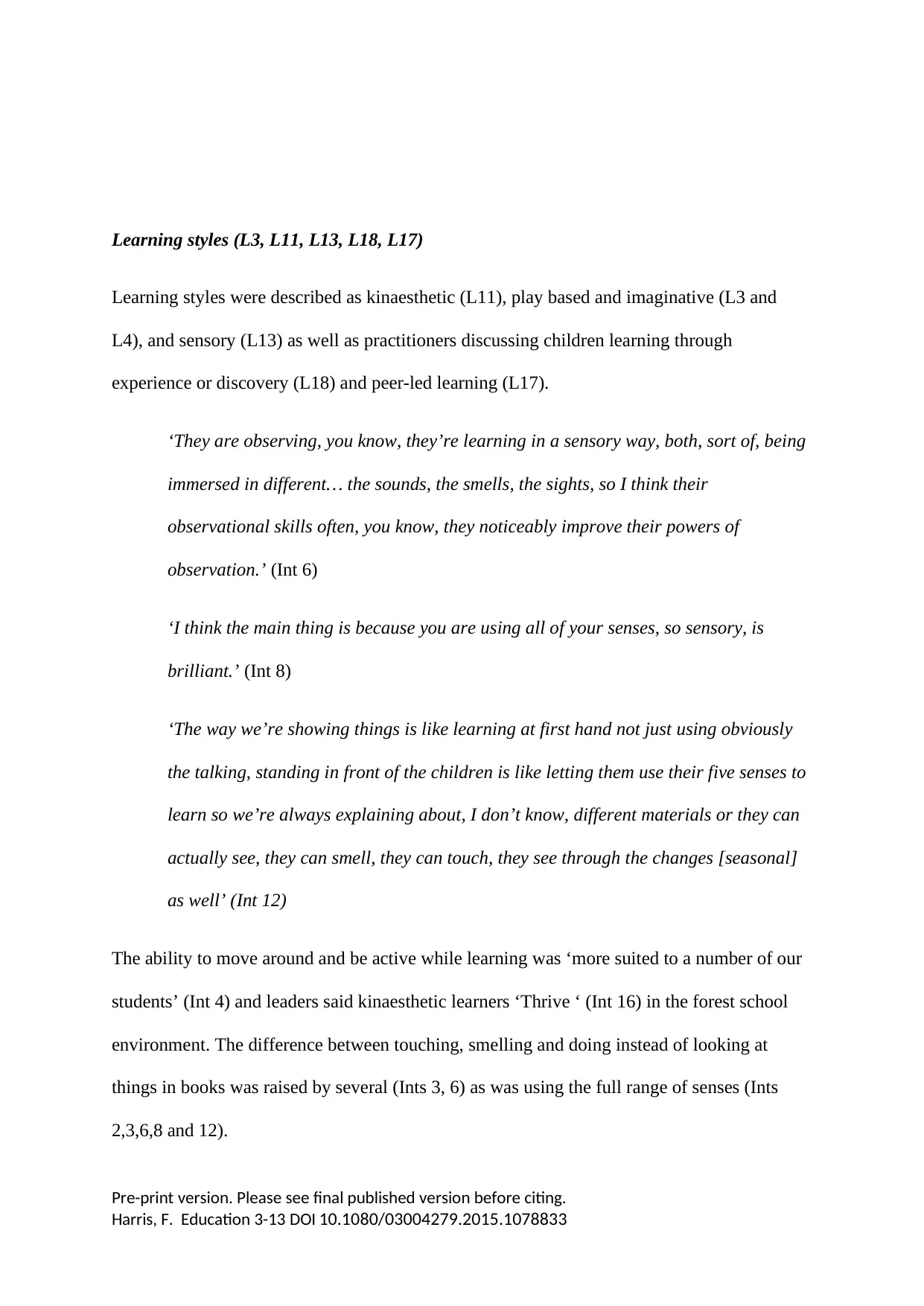
Pre-print version. Please see final published version before citing.
Harris, F. Education 3-13 DOI 10.1080/03004279.2015.1078833
Learning styles (L3, L11, L13, L18, L17)
Learning styles were described as kinaesthetic (L11), play based and imaginative (L3 and
L4), and sensory (L13) as well as practitioners discussing children learning through
experience or discovery (L18) and peer-led learning (L17).
‘They are observing, you know, they’re learning in a sensory way, both, sort of, being
immersed in different… the sounds, the smells, the sights, so I think their
observational skills often, you know, they noticeably improve their powers of
observation.’ (Int 6)
‘I think the main thing is because you are using all of your senses, so sensory, is
brilliant.’ (Int 8)
‘The way we’re showing things is like learning at first hand not just using obviously
the talking, standing in front of the children is like letting them use their five senses to
learn so we’re always explaining about, I don’t know, different materials or they can
actually see, they can smell, they can touch, they see through the changes [seasonal]
as well’ (Int 12)
The ability to move around and be active while learning was ‘more suited to a number of our
students’ (Int 4) and leaders said kinaesthetic learners ‘Thrive ‘ (Int 16) in the forest school
environment. The difference between touching, smelling and doing instead of looking at
things in books was raised by several (Ints 3, 6) as was using the full range of senses (Ints
2,3,6,8 and 12).
Harris, F. Education 3-13 DOI 10.1080/03004279.2015.1078833
Learning styles (L3, L11, L13, L18, L17)
Learning styles were described as kinaesthetic (L11), play based and imaginative (L3 and
L4), and sensory (L13) as well as practitioners discussing children learning through
experience or discovery (L18) and peer-led learning (L17).
‘They are observing, you know, they’re learning in a sensory way, both, sort of, being
immersed in different… the sounds, the smells, the sights, so I think their
observational skills often, you know, they noticeably improve their powers of
observation.’ (Int 6)
‘I think the main thing is because you are using all of your senses, so sensory, is
brilliant.’ (Int 8)
‘The way we’re showing things is like learning at first hand not just using obviously
the talking, standing in front of the children is like letting them use their five senses to
learn so we’re always explaining about, I don’t know, different materials or they can
actually see, they can smell, they can touch, they see through the changes [seasonal]
as well’ (Int 12)
The ability to move around and be active while learning was ‘more suited to a number of our
students’ (Int 4) and leaders said kinaesthetic learners ‘Thrive ‘ (Int 16) in the forest school
environment. The difference between touching, smelling and doing instead of looking at
things in books was raised by several (Ints 3, 6) as was using the full range of senses (Ints
2,3,6,8 and 12).
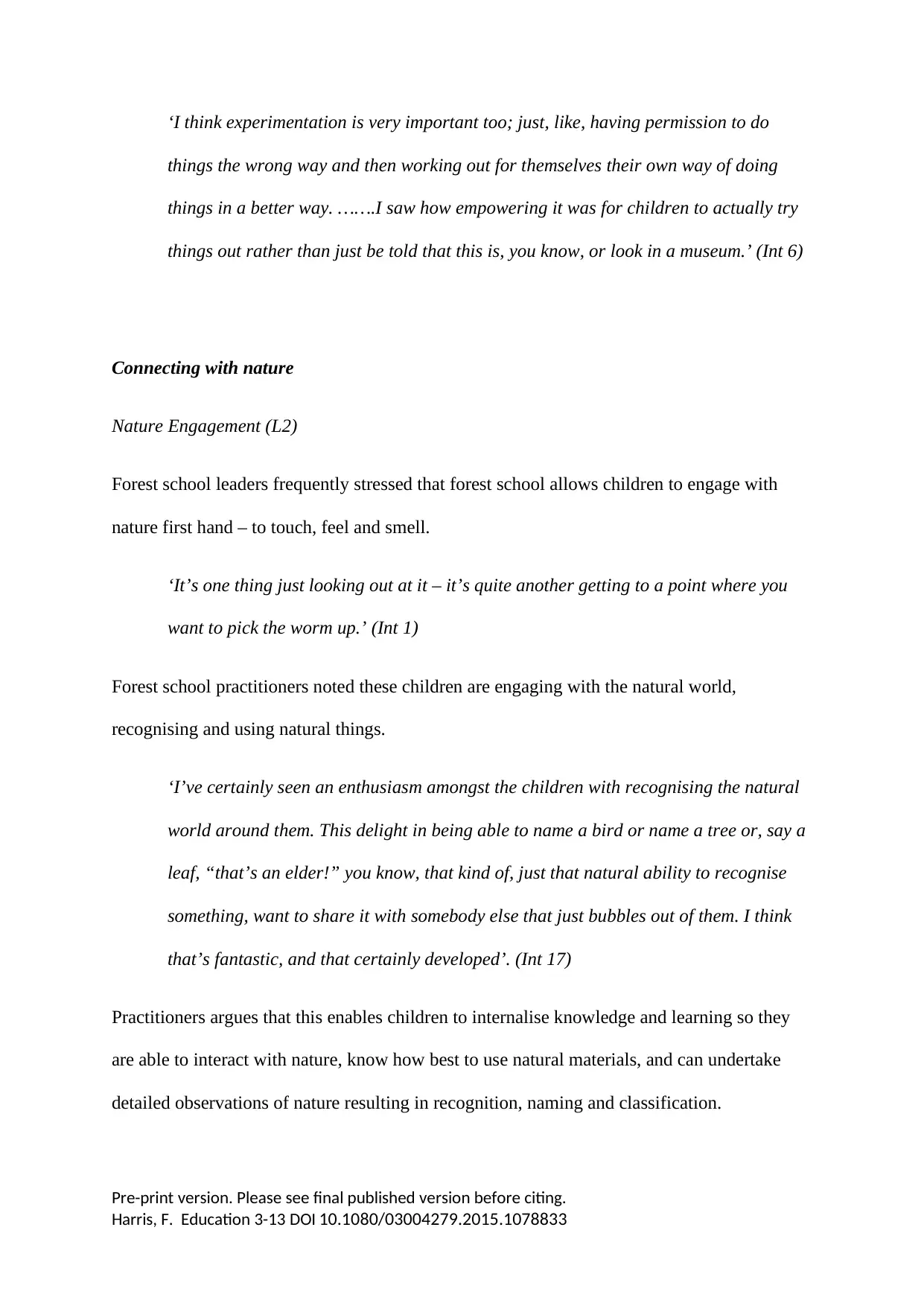
Pre-print version. Please see final published version before citing.
Harris, F. Education 3-13 DOI 10.1080/03004279.2015.1078833
‘I think experimentation is very important too; just, like, having permission to do
things the wrong way and then working out for themselves their own way of doing
things in a better way. …….I saw how empowering it was for children to actually try
things out rather than just be told that this is, you know, or look in a museum.’ (Int 6)
Connecting with nature
Nature Engagement (L2)
Forest school leaders frequently stressed that forest school allows children to engage with
nature first hand – to touch, feel and smell.
‘It’s one thing just looking out at it – it’s quite another getting to a point where you
want to pick the worm up.’ (Int 1)
Forest school practitioners noted these children are engaging with the natural world,
recognising and using natural things.
‘I’ve certainly seen an enthusiasm amongst the children with recognising the natural
world around them. This delight in being able to name a bird or name a tree or, say a
leaf, “that’s an elder!” you know, that kind of, just that natural ability to recognise
something, want to share it with somebody else that just bubbles out of them. I think
that’s fantastic, and that certainly developed’. (Int 17)
Practitioners argues that this enables children to internalise knowledge and learning so they
are able to interact with nature, know how best to use natural materials, and can undertake
detailed observations of nature resulting in recognition, naming and classification.
Harris, F. Education 3-13 DOI 10.1080/03004279.2015.1078833
‘I think experimentation is very important too; just, like, having permission to do
things the wrong way and then working out for themselves their own way of doing
things in a better way. …….I saw how empowering it was for children to actually try
things out rather than just be told that this is, you know, or look in a museum.’ (Int 6)
Connecting with nature
Nature Engagement (L2)
Forest school leaders frequently stressed that forest school allows children to engage with
nature first hand – to touch, feel and smell.
‘It’s one thing just looking out at it – it’s quite another getting to a point where you
want to pick the worm up.’ (Int 1)
Forest school practitioners noted these children are engaging with the natural world,
recognising and using natural things.
‘I’ve certainly seen an enthusiasm amongst the children with recognising the natural
world around them. This delight in being able to name a bird or name a tree or, say a
leaf, “that’s an elder!” you know, that kind of, just that natural ability to recognise
something, want to share it with somebody else that just bubbles out of them. I think
that’s fantastic, and that certainly developed’. (Int 17)
Practitioners argues that this enables children to internalise knowledge and learning so they
are able to interact with nature, know how best to use natural materials, and can undertake
detailed observations of nature resulting in recognition, naming and classification.
Paraphrase This Document
Need a fresh take? Get an instant paraphrase of this document with our AI Paraphraser
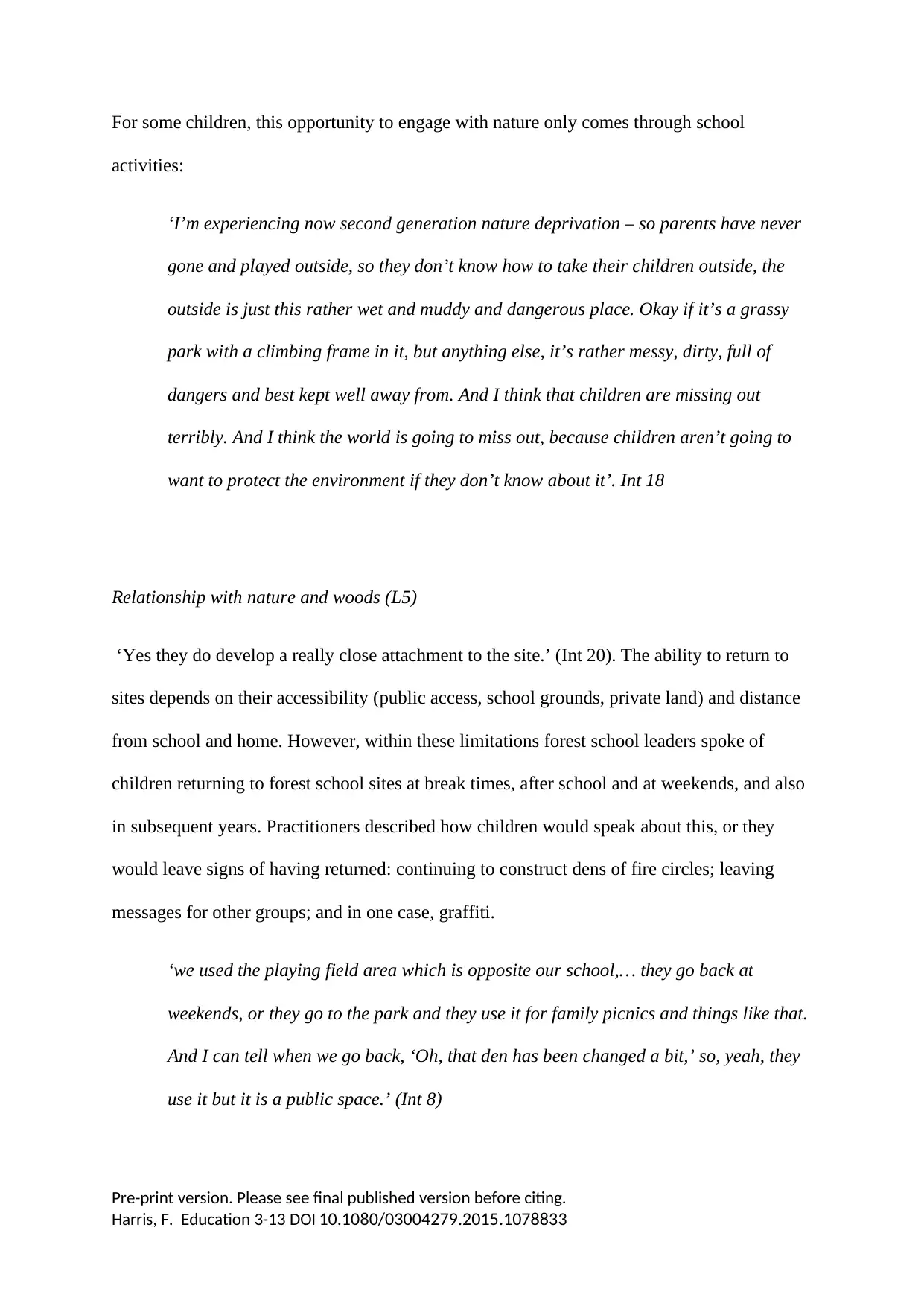
Pre-print version. Please see final published version before citing.
Harris, F. Education 3-13 DOI 10.1080/03004279.2015.1078833
For some children, this opportunity to engage with nature only comes through school
activities:
‘I’m experiencing now second generation nature deprivation – so parents have never
gone and played outside, so they don’t know how to take their children outside, the
outside is just this rather wet and muddy and dangerous place. Okay if it’s a grassy
park with a climbing frame in it, but anything else, it’s rather messy, dirty, full of
dangers and best kept well away from. And I think that children are missing out
terribly. And I think the world is going to miss out, because children aren’t going to
want to protect the environment if they don’t know about it’. Int 18
Relationship with nature and woods (L5)
‘Yes they do develop a really close attachment to the site.’ (Int 20). The ability to return to
sites depends on their accessibility (public access, school grounds, private land) and distance
from school and home. However, within these limitations forest school leaders spoke of
children returning to forest school sites at break times, after school and at weekends, and also
in subsequent years. Practitioners described how children would speak about this, or they
would leave signs of having returned: continuing to construct dens of fire circles; leaving
messages for other groups; and in one case, graffiti.
‘we used the playing field area which is opposite our school,… they go back at
weekends, or they go to the park and they use it for family picnics and things like that.
And I can tell when we go back, ‘Oh, that den has been changed a bit,’ so, yeah, they
use it but it is a public space.’ (Int 8)
Harris, F. Education 3-13 DOI 10.1080/03004279.2015.1078833
For some children, this opportunity to engage with nature only comes through school
activities:
‘I’m experiencing now second generation nature deprivation – so parents have never
gone and played outside, so they don’t know how to take their children outside, the
outside is just this rather wet and muddy and dangerous place. Okay if it’s a grassy
park with a climbing frame in it, but anything else, it’s rather messy, dirty, full of
dangers and best kept well away from. And I think that children are missing out
terribly. And I think the world is going to miss out, because children aren’t going to
want to protect the environment if they don’t know about it’. Int 18
Relationship with nature and woods (L5)
‘Yes they do develop a really close attachment to the site.’ (Int 20). The ability to return to
sites depends on their accessibility (public access, school grounds, private land) and distance
from school and home. However, within these limitations forest school leaders spoke of
children returning to forest school sites at break times, after school and at weekends, and also
in subsequent years. Practitioners described how children would speak about this, or they
would leave signs of having returned: continuing to construct dens of fire circles; leaving
messages for other groups; and in one case, graffiti.
‘we used the playing field area which is opposite our school,… they go back at
weekends, or they go to the park and they use it for family picnics and things like that.
And I can tell when we go back, ‘Oh, that den has been changed a bit,’ so, yeah, they
use it but it is a public space.’ (Int 8)
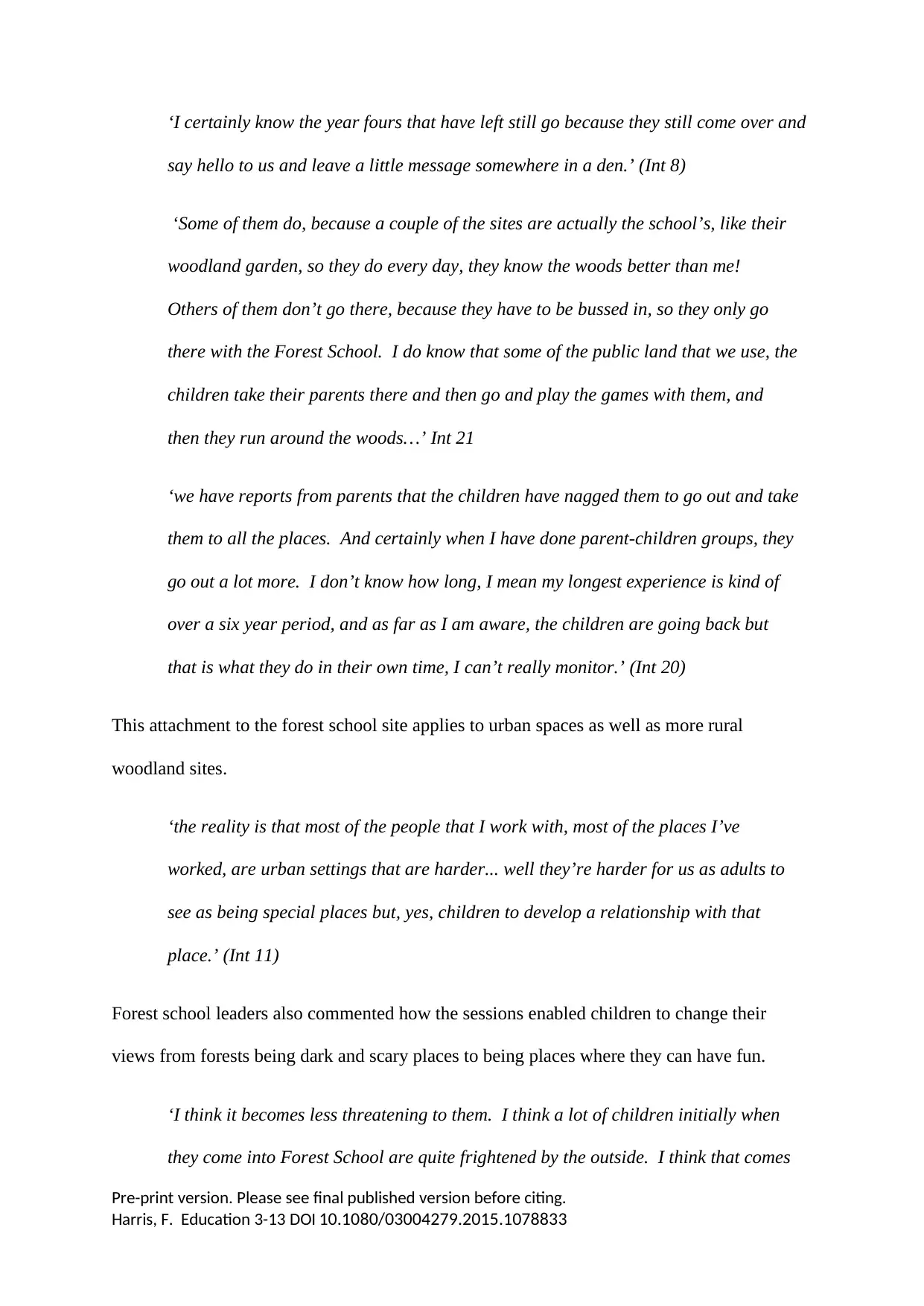
Pre-print version. Please see final published version before citing.
Harris, F. Education 3-13 DOI 10.1080/03004279.2015.1078833
‘I certainly know the year fours that have left still go because they still come over and
say hello to us and leave a little message somewhere in a den.’ (Int 8)
‘Some of them do, because a couple of the sites are actually the school’s, like their
woodland garden, so they do every day, they know the woods better than me!
Others of them don’t go there, because they have to be bussed in, so they only go
there with the Forest School. I do know that some of the public land that we use, the
children take their parents there and then go and play the games with them, and
then they run around the woods…’ Int 21
‘we have reports from parents that the children have nagged them to go out and take
them to all the places. And certainly when I have done parent-children groups, they
go out a lot more. I don’t know how long, I mean my longest experience is kind of
over a six year period, and as far as I am aware, the children are going back but
that is what they do in their own time, I can’t really monitor.’ (Int 20)
This attachment to the forest school site applies to urban spaces as well as more rural
woodland sites.
‘the reality is that most of the people that I work with, most of the places I’ve
worked, are urban settings that are harder... well they’re harder for us as adults to
see as being special places but, yes, children to develop a relationship with that
place.’ (Int 11)
Forest school leaders also commented how the sessions enabled children to change their
views from forests being dark and scary places to being places where they can have fun.
‘I think it becomes less threatening to them. I think a lot of children initially when
they come into Forest School are quite frightened by the outside. I think that comes
Harris, F. Education 3-13 DOI 10.1080/03004279.2015.1078833
‘I certainly know the year fours that have left still go because they still come over and
say hello to us and leave a little message somewhere in a den.’ (Int 8)
‘Some of them do, because a couple of the sites are actually the school’s, like their
woodland garden, so they do every day, they know the woods better than me!
Others of them don’t go there, because they have to be bussed in, so they only go
there with the Forest School. I do know that some of the public land that we use, the
children take their parents there and then go and play the games with them, and
then they run around the woods…’ Int 21
‘we have reports from parents that the children have nagged them to go out and take
them to all the places. And certainly when I have done parent-children groups, they
go out a lot more. I don’t know how long, I mean my longest experience is kind of
over a six year period, and as far as I am aware, the children are going back but
that is what they do in their own time, I can’t really monitor.’ (Int 20)
This attachment to the forest school site applies to urban spaces as well as more rural
woodland sites.
‘the reality is that most of the people that I work with, most of the places I’ve
worked, are urban settings that are harder... well they’re harder for us as adults to
see as being special places but, yes, children to develop a relationship with that
place.’ (Int 11)
Forest school leaders also commented how the sessions enabled children to change their
views from forests being dark and scary places to being places where they can have fun.
‘I think it becomes less threatening to them. I think a lot of children initially when
they come into Forest School are quite frightened by the outside. I think that comes
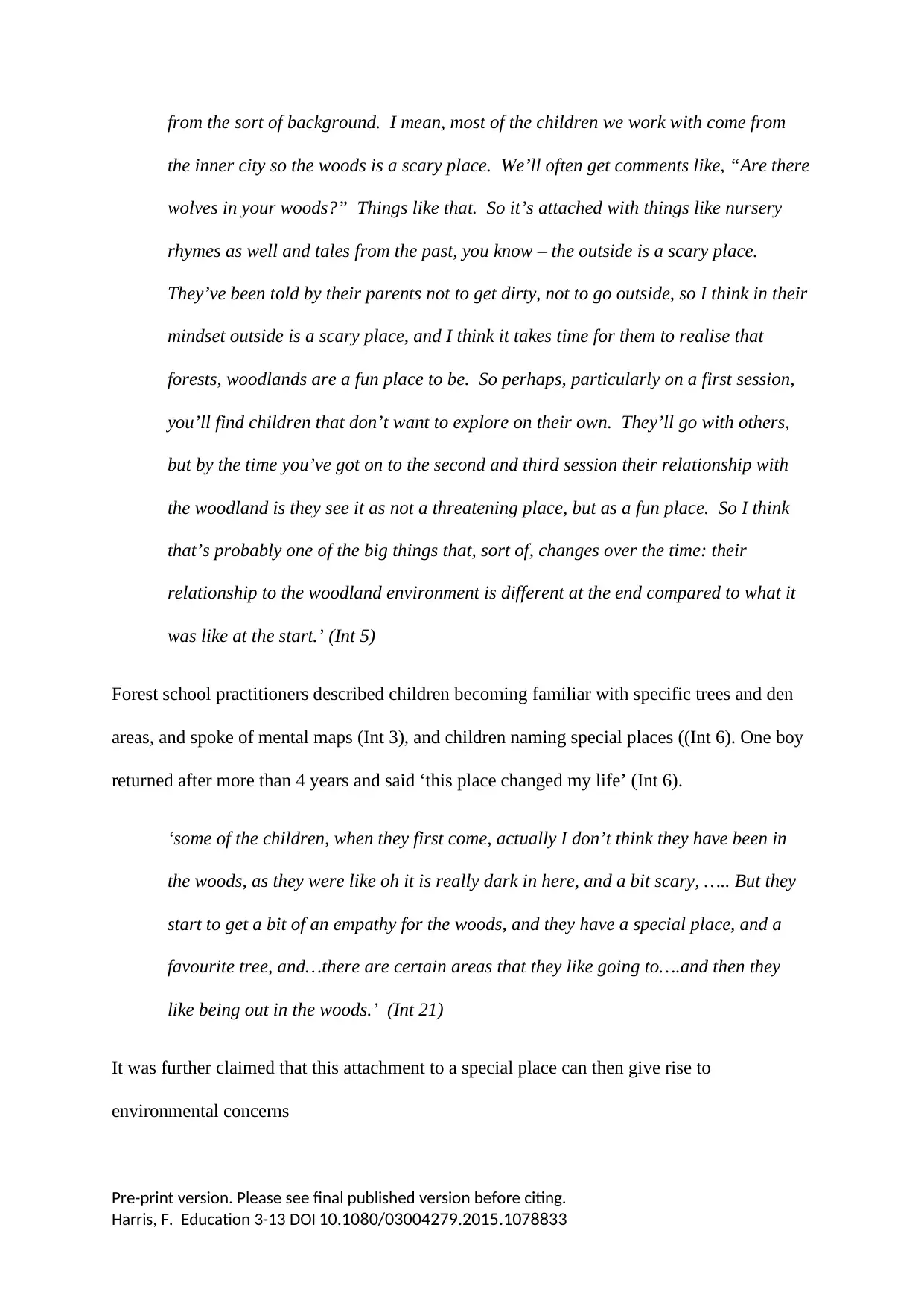
Pre-print version. Please see final published version before citing.
Harris, F. Education 3-13 DOI 10.1080/03004279.2015.1078833
from the sort of background. I mean, most of the children we work with come from
the inner city so the woods is a scary place. We’ll often get comments like, “Are there
wolves in your woods?” Things like that. So it’s attached with things like nursery
rhymes as well and tales from the past, you know – the outside is a scary place.
They’ve been told by their parents not to get dirty, not to go outside, so I think in their
mindset outside is a scary place, and I think it takes time for them to realise that
forests, woodlands are a fun place to be. So perhaps, particularly on a first session,
you’ll find children that don’t want to explore on their own. They’ll go with others,
but by the time you’ve got on to the second and third session their relationship with
the woodland is they see it as not a threatening place, but as a fun place. So I think
that’s probably one of the big things that, sort of, changes over the time: their
relationship to the woodland environment is different at the end compared to what it
was like at the start.’ (Int 5)
Forest school practitioners described children becoming familiar with specific trees and den
areas, and spoke of mental maps (Int 3), and children naming special places ((Int 6). One boy
returned after more than 4 years and said ‘this place changed my life’ (Int 6).
‘some of the children, when they first come, actually I don’t think they have been in
the woods, as they were like oh it is really dark in here, and a bit scary, ….. But they
start to get a bit of an empathy for the woods, and they have a special place, and a
favourite tree, and…there are certain areas that they like going to….and then they
like being out in the woods.’ (Int 21)
It was further claimed that this attachment to a special place can then give rise to
environmental concerns
Harris, F. Education 3-13 DOI 10.1080/03004279.2015.1078833
from the sort of background. I mean, most of the children we work with come from
the inner city so the woods is a scary place. We’ll often get comments like, “Are there
wolves in your woods?” Things like that. So it’s attached with things like nursery
rhymes as well and tales from the past, you know – the outside is a scary place.
They’ve been told by their parents not to get dirty, not to go outside, so I think in their
mindset outside is a scary place, and I think it takes time for them to realise that
forests, woodlands are a fun place to be. So perhaps, particularly on a first session,
you’ll find children that don’t want to explore on their own. They’ll go with others,
but by the time you’ve got on to the second and third session their relationship with
the woodland is they see it as not a threatening place, but as a fun place. So I think
that’s probably one of the big things that, sort of, changes over the time: their
relationship to the woodland environment is different at the end compared to what it
was like at the start.’ (Int 5)
Forest school practitioners described children becoming familiar with specific trees and den
areas, and spoke of mental maps (Int 3), and children naming special places ((Int 6). One boy
returned after more than 4 years and said ‘this place changed my life’ (Int 6).
‘some of the children, when they first come, actually I don’t think they have been in
the woods, as they were like oh it is really dark in here, and a bit scary, ….. But they
start to get a bit of an empathy for the woods, and they have a special place, and a
favourite tree, and…there are certain areas that they like going to….and then they
like being out in the woods.’ (Int 21)
It was further claimed that this attachment to a special place can then give rise to
environmental concerns
Secure Best Marks with AI Grader
Need help grading? Try our AI Grader for instant feedback on your assignments.
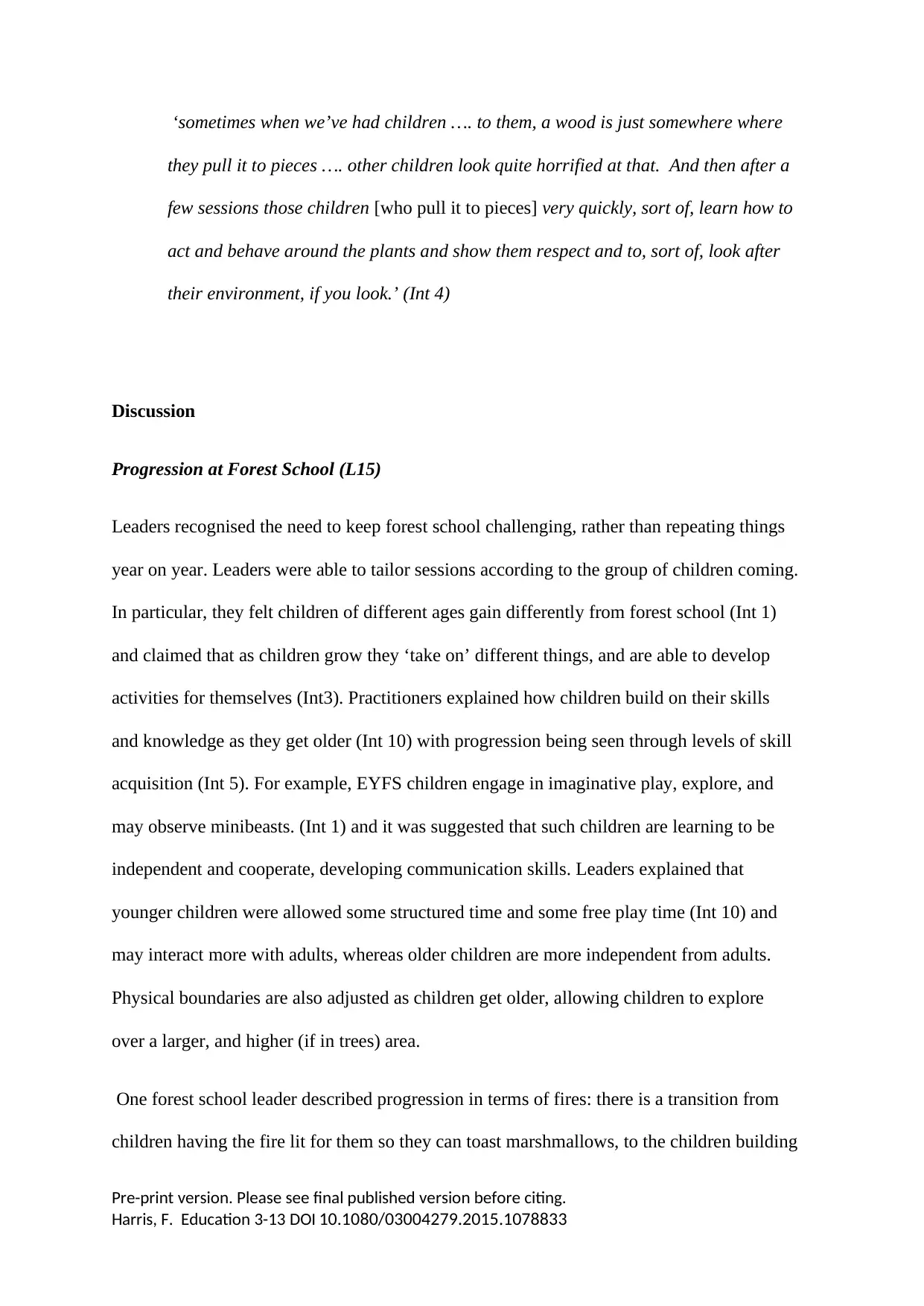
Pre-print version. Please see final published version before citing.
Harris, F. Education 3-13 DOI 10.1080/03004279.2015.1078833
‘sometimes when we’ve had children …. to them, a wood is just somewhere where
they pull it to pieces …. other children look quite horrified at that. And then after a
few sessions those children [who pull it to pieces] very quickly, sort of, learn how to
act and behave around the plants and show them respect and to, sort of, look after
their environment, if you look.’ (Int 4)
Discussion
Progression at Forest School (L15)
Leaders recognised the need to keep forest school challenging, rather than repeating things
year on year. Leaders were able to tailor sessions according to the group of children coming.
In particular, they felt children of different ages gain differently from forest school (Int 1)
and claimed that as children grow they ‘take on’ different things, and are able to develop
activities for themselves (Int3). Practitioners explained how children build on their skills
and knowledge as they get older (Int 10) with progression being seen through levels of skill
acquisition (Int 5). For example, EYFS children engage in imaginative play, explore, and
may observe minibeasts. (Int 1) and it was suggested that such children are learning to be
independent and cooperate, developing communication skills. Leaders explained that
younger children were allowed some structured time and some free play time (Int 10) and
may interact more with adults, whereas older children are more independent from adults.
Physical boundaries are also adjusted as children get older, allowing children to explore
over a larger, and higher (if in trees) area.
One forest school leader described progression in terms of fires: there is a transition from
children having the fire lit for them so they can toast marshmallows, to the children building
Harris, F. Education 3-13 DOI 10.1080/03004279.2015.1078833
‘sometimes when we’ve had children …. to them, a wood is just somewhere where
they pull it to pieces …. other children look quite horrified at that. And then after a
few sessions those children [who pull it to pieces] very quickly, sort of, learn how to
act and behave around the plants and show them respect and to, sort of, look after
their environment, if you look.’ (Int 4)
Discussion
Progression at Forest School (L15)
Leaders recognised the need to keep forest school challenging, rather than repeating things
year on year. Leaders were able to tailor sessions according to the group of children coming.
In particular, they felt children of different ages gain differently from forest school (Int 1)
and claimed that as children grow they ‘take on’ different things, and are able to develop
activities for themselves (Int3). Practitioners explained how children build on their skills
and knowledge as they get older (Int 10) with progression being seen through levels of skill
acquisition (Int 5). For example, EYFS children engage in imaginative play, explore, and
may observe minibeasts. (Int 1) and it was suggested that such children are learning to be
independent and cooperate, developing communication skills. Leaders explained that
younger children were allowed some structured time and some free play time (Int 10) and
may interact more with adults, whereas older children are more independent from adults.
Physical boundaries are also adjusted as children get older, allowing children to explore
over a larger, and higher (if in trees) area.
One forest school leader described progression in terms of fires: there is a transition from
children having the fire lit for them so they can toast marshmallows, to the children building

Pre-print version. Please see final published version before citing.
Harris, F. Education 3-13 DOI 10.1080/03004279.2015.1078833
and lighting the fire themselves (Int 8, 12). Similarly, young children might engage in a bug
hunt, whereas older children might do a more complex audit of bugs (Int 8). Older children
might also build larger and more complex dens, learn to use knives instead of potato peelers
to scrape bark from sticks, and perhaps recognise and follow animal tracks (Int 19). The
development of social skills evolves as children get older (Int 1), from playing alongside
each other to together, and developing communication and negotiation skills as group work
becomes more complex. As children grow older some forest school leaders suggested
progression lead children towards either Bush craft, (focussing on skills), or John Muir
awards (focussing on environmental education) (Int5).
The Challenge of negotiated learning
Forest school leaders discussed the balance between directing learning at forest school and
allowing children to shape what is done at forest school. Initial sessions tended to be led by
the forest school practitioner as ground-rules were set in the new environment: delineating
the places children could go and rules for behaviour (e.g. relating to safety). Once children
became familiar with the site and forest school practice, negotiation began.
‘what we'll often start off with is very, sort of, simple activities, and we’ll introduce
things for the children to do. We don't tell them what to do; we, sort of, introduce if
today you’d like to, you know, do mud painting that’s fine, this is what you can do, but
if they decide to do something else and it’s safe then we’ll let them do that. And at the
end of sessions we always say, “What would you like to do next? If it was your
choice, what would you like to do?” ….. it’s child led, rather than teacher led
learning… the children are in charge they take responsibility for it and they know that
they’re going to be able to achieve at their own level and therefore that’s where the
Harris, F. Education 3-13 DOI 10.1080/03004279.2015.1078833
and lighting the fire themselves (Int 8, 12). Similarly, young children might engage in a bug
hunt, whereas older children might do a more complex audit of bugs (Int 8). Older children
might also build larger and more complex dens, learn to use knives instead of potato peelers
to scrape bark from sticks, and perhaps recognise and follow animal tracks (Int 19). The
development of social skills evolves as children get older (Int 1), from playing alongside
each other to together, and developing communication and negotiation skills as group work
becomes more complex. As children grow older some forest school leaders suggested
progression lead children towards either Bush craft, (focussing on skills), or John Muir
awards (focussing on environmental education) (Int5).
The Challenge of negotiated learning
Forest school leaders discussed the balance between directing learning at forest school and
allowing children to shape what is done at forest school. Initial sessions tended to be led by
the forest school practitioner as ground-rules were set in the new environment: delineating
the places children could go and rules for behaviour (e.g. relating to safety). Once children
became familiar with the site and forest school practice, negotiation began.
‘what we'll often start off with is very, sort of, simple activities, and we’ll introduce
things for the children to do. We don't tell them what to do; we, sort of, introduce if
today you’d like to, you know, do mud painting that’s fine, this is what you can do, but
if they decide to do something else and it’s safe then we’ll let them do that. And at the
end of sessions we always say, “What would you like to do next? If it was your
choice, what would you like to do?” ….. it’s child led, rather than teacher led
learning… the children are in charge they take responsibility for it and they know that
they’re going to be able to achieve at their own level and therefore that’s where the
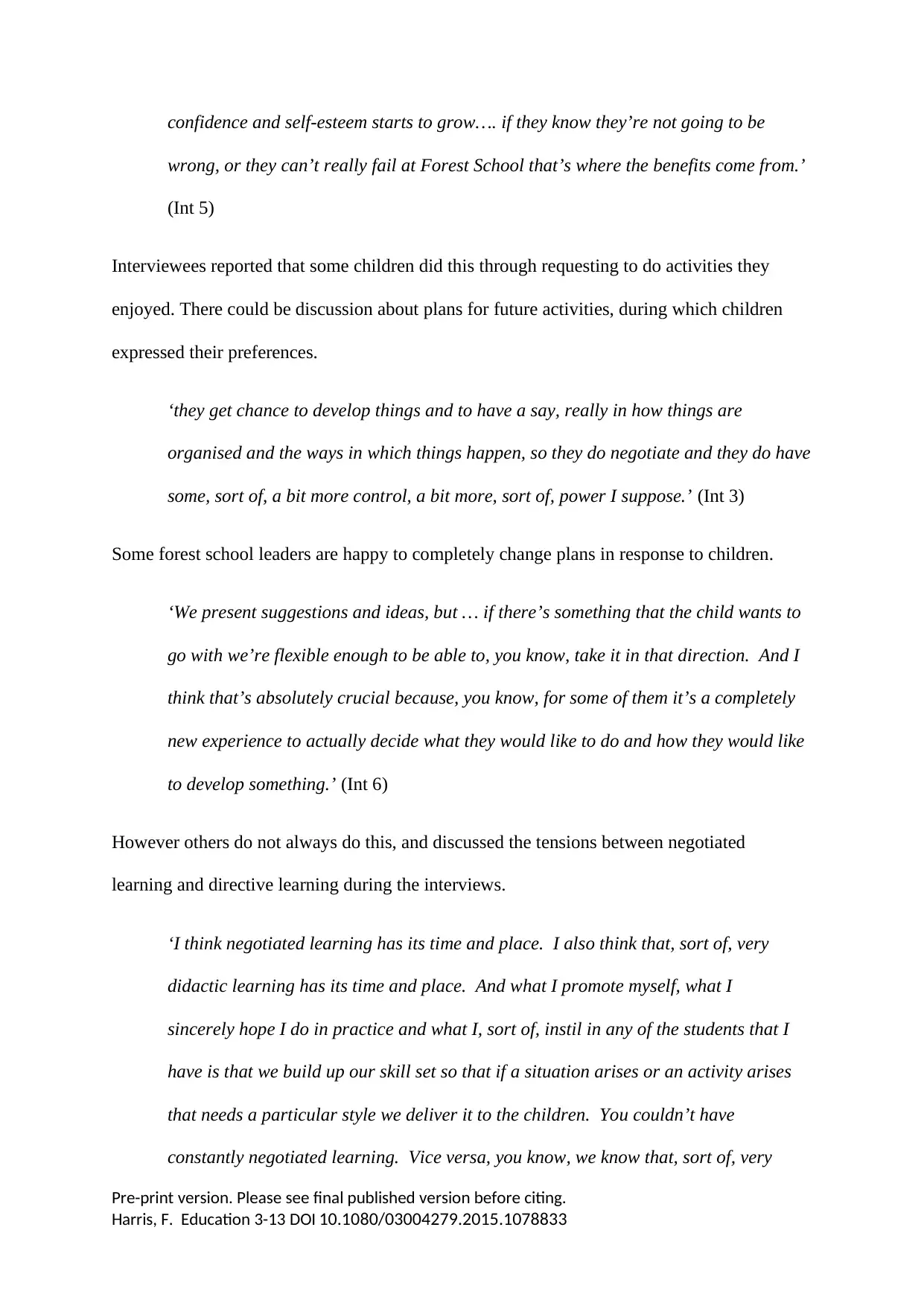
Pre-print version. Please see final published version before citing.
Harris, F. Education 3-13 DOI 10.1080/03004279.2015.1078833
confidence and self-esteem starts to grow…. if they know they’re not going to be
wrong, or they can’t really fail at Forest School that’s where the benefits come from.’
(Int 5)
Interviewees reported that some children did this through requesting to do activities they
enjoyed. There could be discussion about plans for future activities, during which children
expressed their preferences.
‘they get chance to develop things and to have a say, really in how things are
organised and the ways in which things happen, so they do negotiate and they do have
some, sort of, a bit more control, a bit more, sort of, power I suppose.’ (Int 3)
Some forest school leaders are happy to completely change plans in response to children.
‘We present suggestions and ideas, but … if there’s something that the child wants to
go with we’re flexible enough to be able to, you know, take it in that direction. And I
think that’s absolutely crucial because, you know, for some of them it’s a completely
new experience to actually decide what they would like to do and how they would like
to develop something.’ (Int 6)
However others do not always do this, and discussed the tensions between negotiated
learning and directive learning during the interviews.
‘I think negotiated learning has its time and place. I also think that, sort of, very
didactic learning has its time and place. And what I promote myself, what I
sincerely hope I do in practice and what I, sort of, instil in any of the students that I
have is that we build up our skill set so that if a situation arises or an activity arises
that needs a particular style we deliver it to the children. You couldn’t have
constantly negotiated learning. Vice versa, you know, we know that, sort of, very
Harris, F. Education 3-13 DOI 10.1080/03004279.2015.1078833
confidence and self-esteem starts to grow…. if they know they’re not going to be
wrong, or they can’t really fail at Forest School that’s where the benefits come from.’
(Int 5)
Interviewees reported that some children did this through requesting to do activities they
enjoyed. There could be discussion about plans for future activities, during which children
expressed their preferences.
‘they get chance to develop things and to have a say, really in how things are
organised and the ways in which things happen, so they do negotiate and they do have
some, sort of, a bit more control, a bit more, sort of, power I suppose.’ (Int 3)
Some forest school leaders are happy to completely change plans in response to children.
‘We present suggestions and ideas, but … if there’s something that the child wants to
go with we’re flexible enough to be able to, you know, take it in that direction. And I
think that’s absolutely crucial because, you know, for some of them it’s a completely
new experience to actually decide what they would like to do and how they would like
to develop something.’ (Int 6)
However others do not always do this, and discussed the tensions between negotiated
learning and directive learning during the interviews.
‘I think negotiated learning has its time and place. I also think that, sort of, very
didactic learning has its time and place. And what I promote myself, what I
sincerely hope I do in practice and what I, sort of, instil in any of the students that I
have is that we build up our skill set so that if a situation arises or an activity arises
that needs a particular style we deliver it to the children. You couldn’t have
constantly negotiated learning. Vice versa, you know, we know that, sort of, very
Paraphrase This Document
Need a fresh take? Get an instant paraphrase of this document with our AI Paraphraser

Pre-print version. Please see final published version before citing.
Harris, F. Education 3-13 DOI 10.1080/03004279.2015.1078833
much the controlled type of education, yeah, has its moments, but it also has its
weaknesses……. negotiated learning has its time and place, but unless the children
know which direction they want to go in and experience it can, sort of, in cases, you
know, they, sort of, get lost, if you like.’ (Int 4)
Facilitating child-led learning was acknowledged to be a challenge.
‘They get very little choices within school, within mainstream education, …. They’re
allowed to make choices [at forest school] but the question is, is how you facilitate
that and that’s the key, that’s the hard bit.... Some people can find that very easy but
it’s something I think that some people have to learn how to do it.’ (Int 11)
Other practitioners described the importance of developing their own confidence to
facilitate learning, and the time taken to get to know the children (Int 10)
Conclusions
This paper has drawn together the expertise, emerging from practise, of 20 forest school
leaders. Ideally the research would involve a large cohort and statistically significant numbers
of children, however limitations on research funding and ethical considerations regarding
access to school’s data concerning children has meant that at this time, only a smaller scale
project has been possible. Although still a small study, each forest school leader draws on
experience with many children, so expanding the scope of this research compared to smaller
case-study research. Through semi-structured interviews they were encouraged to share their
experience and understanding of forest school in relation to several themes, and this paper
reports on their responses concerning their perceptions of what children learn while at forest
Harris, F. Education 3-13 DOI 10.1080/03004279.2015.1078833
much the controlled type of education, yeah, has its moments, but it also has its
weaknesses……. negotiated learning has its time and place, but unless the children
know which direction they want to go in and experience it can, sort of, in cases, you
know, they, sort of, get lost, if you like.’ (Int 4)
Facilitating child-led learning was acknowledged to be a challenge.
‘They get very little choices within school, within mainstream education, …. They’re
allowed to make choices [at forest school] but the question is, is how you facilitate
that and that’s the key, that’s the hard bit.... Some people can find that very easy but
it’s something I think that some people have to learn how to do it.’ (Int 11)
Other practitioners described the importance of developing their own confidence to
facilitate learning, and the time taken to get to know the children (Int 10)
Conclusions
This paper has drawn together the expertise, emerging from practise, of 20 forest school
leaders. Ideally the research would involve a large cohort and statistically significant numbers
of children, however limitations on research funding and ethical considerations regarding
access to school’s data concerning children has meant that at this time, only a smaller scale
project has been possible. Although still a small study, each forest school leader draws on
experience with many children, so expanding the scope of this research compared to smaller
case-study research. Through semi-structured interviews they were encouraged to share their
experience and understanding of forest school in relation to several themes, and this paper
reports on their responses concerning their perceptions of what children learn while at forest
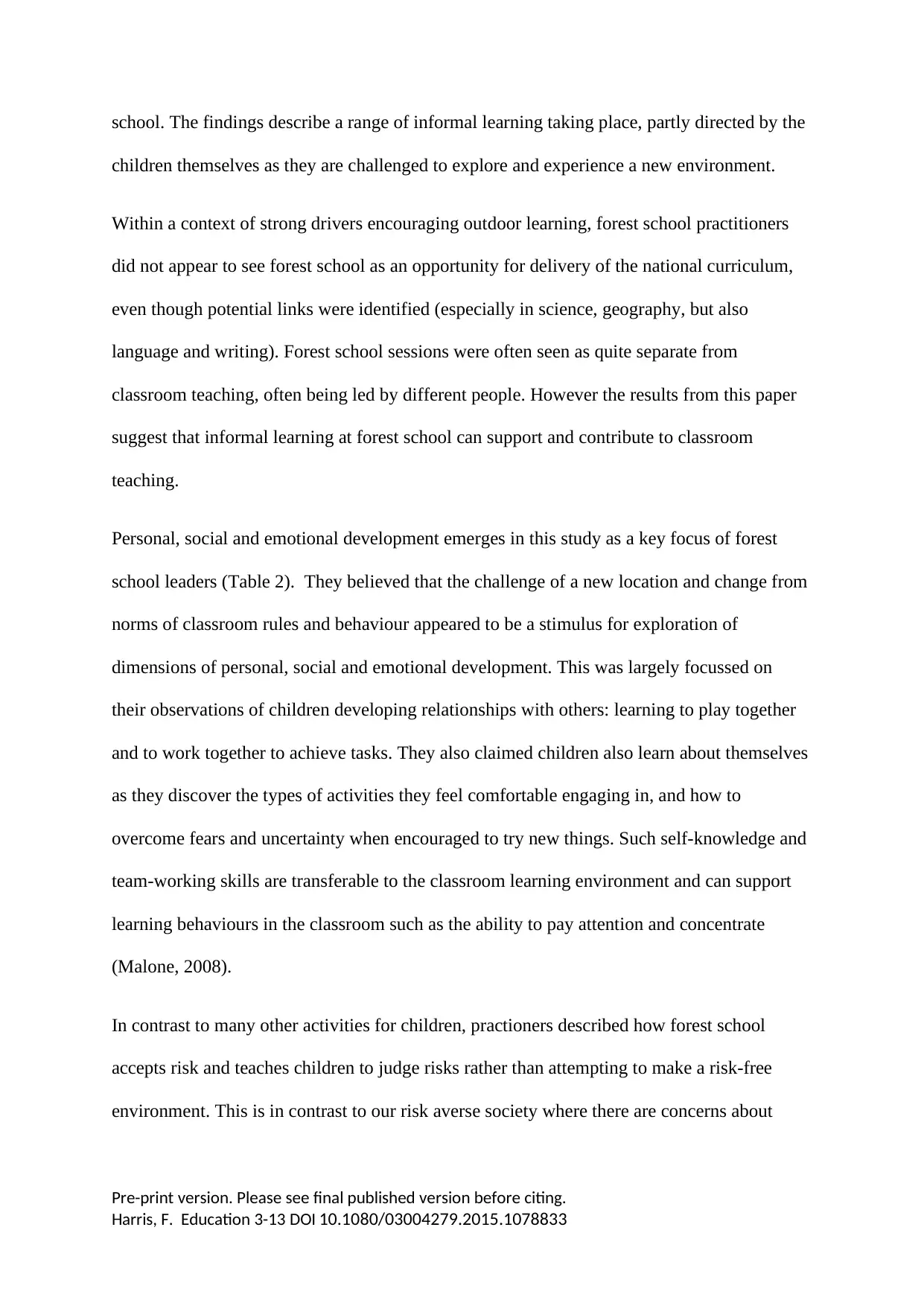
Pre-print version. Please see final published version before citing.
Harris, F. Education 3-13 DOI 10.1080/03004279.2015.1078833
school. The findings describe a range of informal learning taking place, partly directed by the
children themselves as they are challenged to explore and experience a new environment.
Within a context of strong drivers encouraging outdoor learning, forest school practitioners
did not appear to see forest school as an opportunity for delivery of the national curriculum,
even though potential links were identified (especially in science, geography, but also
language and writing). Forest school sessions were often seen as quite separate from
classroom teaching, often being led by different people. However the results from this paper
suggest that informal learning at forest school can support and contribute to classroom
teaching.
Personal, social and emotional development emerges in this study as a key focus of forest
school leaders (Table 2). They believed that the challenge of a new location and change from
norms of classroom rules and behaviour appeared to be a stimulus for exploration of
dimensions of personal, social and emotional development. This was largely focussed on
their observations of children developing relationships with others: learning to play together
and to work together to achieve tasks. They also claimed children also learn about themselves
as they discover the types of activities they feel comfortable engaging in, and how to
overcome fears and uncertainty when encouraged to try new things. Such self-knowledge and
team-working skills are transferable to the classroom learning environment and can support
learning behaviours in the classroom such as the ability to pay attention and concentrate
(Malone, 2008).
In contrast to many other activities for children, practioners described how forest school
accepts risk and teaches children to judge risks rather than attempting to make a risk-free
environment. This is in contrast to our risk averse society where there are concerns about
Harris, F. Education 3-13 DOI 10.1080/03004279.2015.1078833
school. The findings describe a range of informal learning taking place, partly directed by the
children themselves as they are challenged to explore and experience a new environment.
Within a context of strong drivers encouraging outdoor learning, forest school practitioners
did not appear to see forest school as an opportunity for delivery of the national curriculum,
even though potential links were identified (especially in science, geography, but also
language and writing). Forest school sessions were often seen as quite separate from
classroom teaching, often being led by different people. However the results from this paper
suggest that informal learning at forest school can support and contribute to classroom
teaching.
Personal, social and emotional development emerges in this study as a key focus of forest
school leaders (Table 2). They believed that the challenge of a new location and change from
norms of classroom rules and behaviour appeared to be a stimulus for exploration of
dimensions of personal, social and emotional development. This was largely focussed on
their observations of children developing relationships with others: learning to play together
and to work together to achieve tasks. They also claimed children also learn about themselves
as they discover the types of activities they feel comfortable engaging in, and how to
overcome fears and uncertainty when encouraged to try new things. Such self-knowledge and
team-working skills are transferable to the classroom learning environment and can support
learning behaviours in the classroom such as the ability to pay attention and concentrate
(Malone, 2008).
In contrast to many other activities for children, practioners described how forest school
accepts risk and teaches children to judge risks rather than attempting to make a risk-free
environment. This is in contrast to our risk averse society where there are concerns about
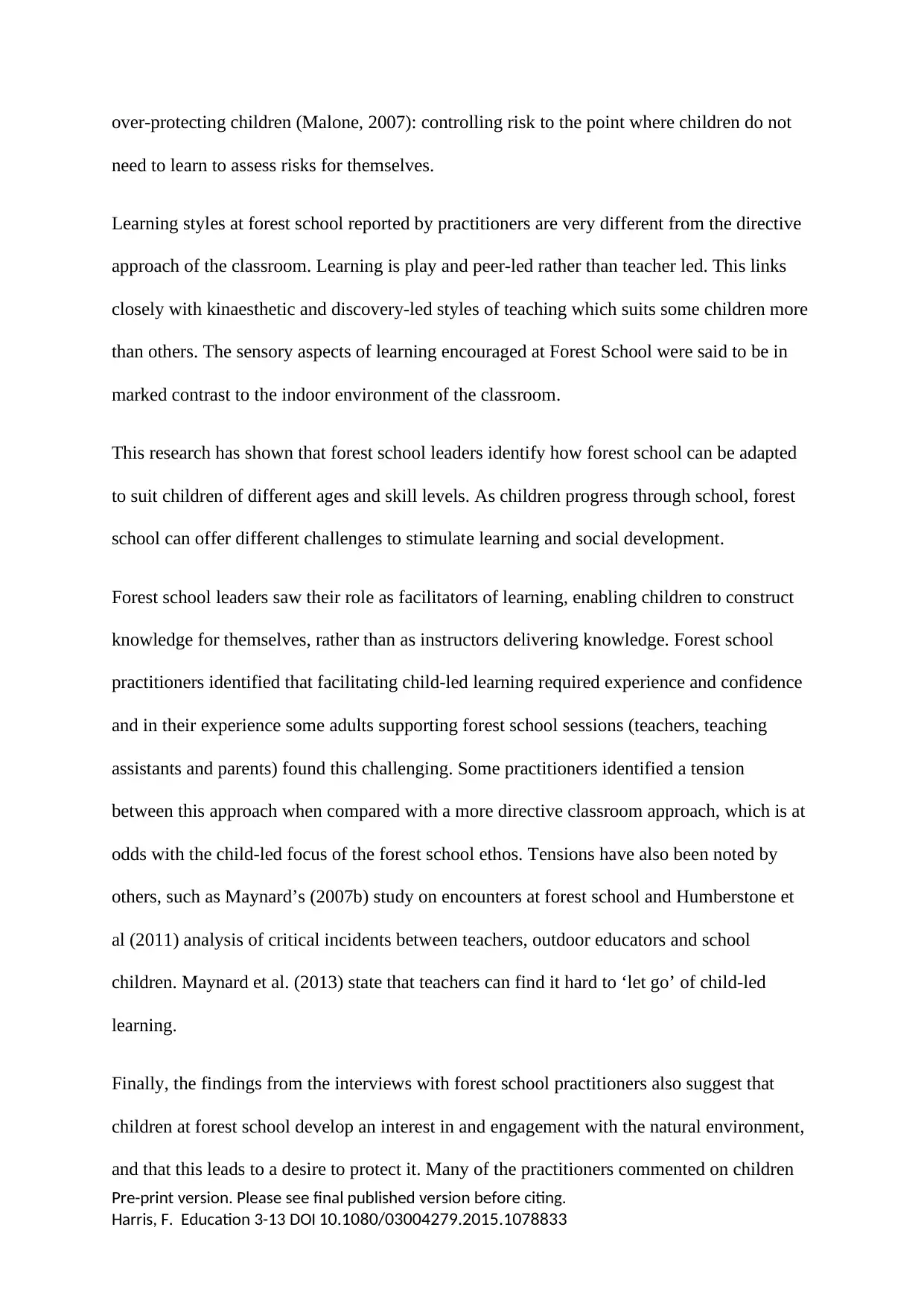
Pre-print version. Please see final published version before citing.
Harris, F. Education 3-13 DOI 10.1080/03004279.2015.1078833
over-protecting children (Malone, 2007): controlling risk to the point where children do not
need to learn to assess risks for themselves.
Learning styles at forest school reported by practitioners are very different from the directive
approach of the classroom. Learning is play and peer-led rather than teacher led. This links
closely with kinaesthetic and discovery-led styles of teaching which suits some children more
than others. The sensory aspects of learning encouraged at Forest School were said to be in
marked contrast to the indoor environment of the classroom.
This research has shown that forest school leaders identify how forest school can be adapted
to suit children of different ages and skill levels. As children progress through school, forest
school can offer different challenges to stimulate learning and social development.
Forest school leaders saw their role as facilitators of learning, enabling children to construct
knowledge for themselves, rather than as instructors delivering knowledge. Forest school
practitioners identified that facilitating child-led learning required experience and confidence
and in their experience some adults supporting forest school sessions (teachers, teaching
assistants and parents) found this challenging. Some practitioners identified a tension
between this approach when compared with a more directive classroom approach, which is at
odds with the child-led focus of the forest school ethos. Tensions have also been noted by
others, such as Maynard’s (2007b) study on encounters at forest school and Humberstone et
al (2011) analysis of critical incidents between teachers, outdoor educators and school
children. Maynard et al. (2013) state that teachers can find it hard to ‘let go’ of child-led
learning.
Finally, the findings from the interviews with forest school practitioners also suggest that
children at forest school develop an interest in and engagement with the natural environment,
and that this leads to a desire to protect it. Many of the practitioners commented on children
Harris, F. Education 3-13 DOI 10.1080/03004279.2015.1078833
over-protecting children (Malone, 2007): controlling risk to the point where children do not
need to learn to assess risks for themselves.
Learning styles at forest school reported by practitioners are very different from the directive
approach of the classroom. Learning is play and peer-led rather than teacher led. This links
closely with kinaesthetic and discovery-led styles of teaching which suits some children more
than others. The sensory aspects of learning encouraged at Forest School were said to be in
marked contrast to the indoor environment of the classroom.
This research has shown that forest school leaders identify how forest school can be adapted
to suit children of different ages and skill levels. As children progress through school, forest
school can offer different challenges to stimulate learning and social development.
Forest school leaders saw their role as facilitators of learning, enabling children to construct
knowledge for themselves, rather than as instructors delivering knowledge. Forest school
practitioners identified that facilitating child-led learning required experience and confidence
and in their experience some adults supporting forest school sessions (teachers, teaching
assistants and parents) found this challenging. Some practitioners identified a tension
between this approach when compared with a more directive classroom approach, which is at
odds with the child-led focus of the forest school ethos. Tensions have also been noted by
others, such as Maynard’s (2007b) study on encounters at forest school and Humberstone et
al (2011) analysis of critical incidents between teachers, outdoor educators and school
children. Maynard et al. (2013) state that teachers can find it hard to ‘let go’ of child-led
learning.
Finally, the findings from the interviews with forest school practitioners also suggest that
children at forest school develop an interest in and engagement with the natural environment,
and that this leads to a desire to protect it. Many of the practitioners commented on children
Secure Best Marks with AI Grader
Need help grading? Try our AI Grader for instant feedback on your assignments.
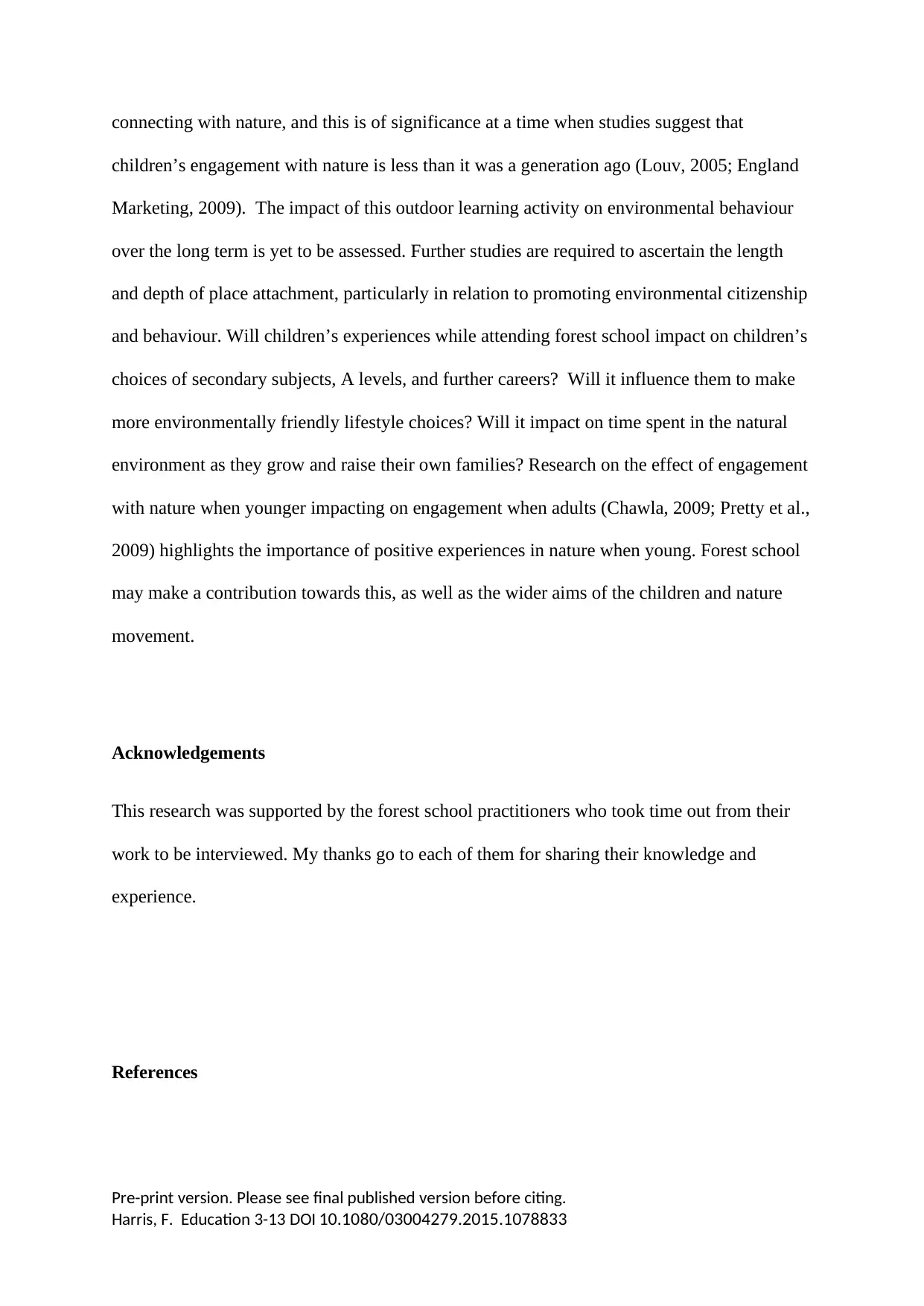
Pre-print version. Please see final published version before citing.
Harris, F. Education 3-13 DOI 10.1080/03004279.2015.1078833
connecting with nature, and this is of significance at a time when studies suggest that
children’s engagement with nature is less than it was a generation ago (Louv, 2005; England
Marketing, 2009). The impact of this outdoor learning activity on environmental behaviour
over the long term is yet to be assessed. Further studies are required to ascertain the length
and depth of place attachment, particularly in relation to promoting environmental citizenship
and behaviour. Will children’s experiences while attending forest school impact on children’s
choices of secondary subjects, A levels, and further careers? Will it influence them to make
more environmentally friendly lifestyle choices? Will it impact on time spent in the natural
environment as they grow and raise their own families? Research on the effect of engagement
with nature when younger impacting on engagement when adults (Chawla, 2009; Pretty et al.,
2009) highlights the importance of positive experiences in nature when young. Forest school
may make a contribution towards this, as well as the wider aims of the children and nature
movement.
Acknowledgements
This research was supported by the forest school practitioners who took time out from their
work to be interviewed. My thanks go to each of them for sharing their knowledge and
experience.
References
Harris, F. Education 3-13 DOI 10.1080/03004279.2015.1078833
connecting with nature, and this is of significance at a time when studies suggest that
children’s engagement with nature is less than it was a generation ago (Louv, 2005; England
Marketing, 2009). The impact of this outdoor learning activity on environmental behaviour
over the long term is yet to be assessed. Further studies are required to ascertain the length
and depth of place attachment, particularly in relation to promoting environmental citizenship
and behaviour. Will children’s experiences while attending forest school impact on children’s
choices of secondary subjects, A levels, and further careers? Will it influence them to make
more environmentally friendly lifestyle choices? Will it impact on time spent in the natural
environment as they grow and raise their own families? Research on the effect of engagement
with nature when younger impacting on engagement when adults (Chawla, 2009; Pretty et al.,
2009) highlights the importance of positive experiences in nature when young. Forest school
may make a contribution towards this, as well as the wider aims of the children and nature
movement.
Acknowledgements
This research was supported by the forest school practitioners who took time out from their
work to be interviewed. My thanks go to each of them for sharing their knowledge and
experience.
References
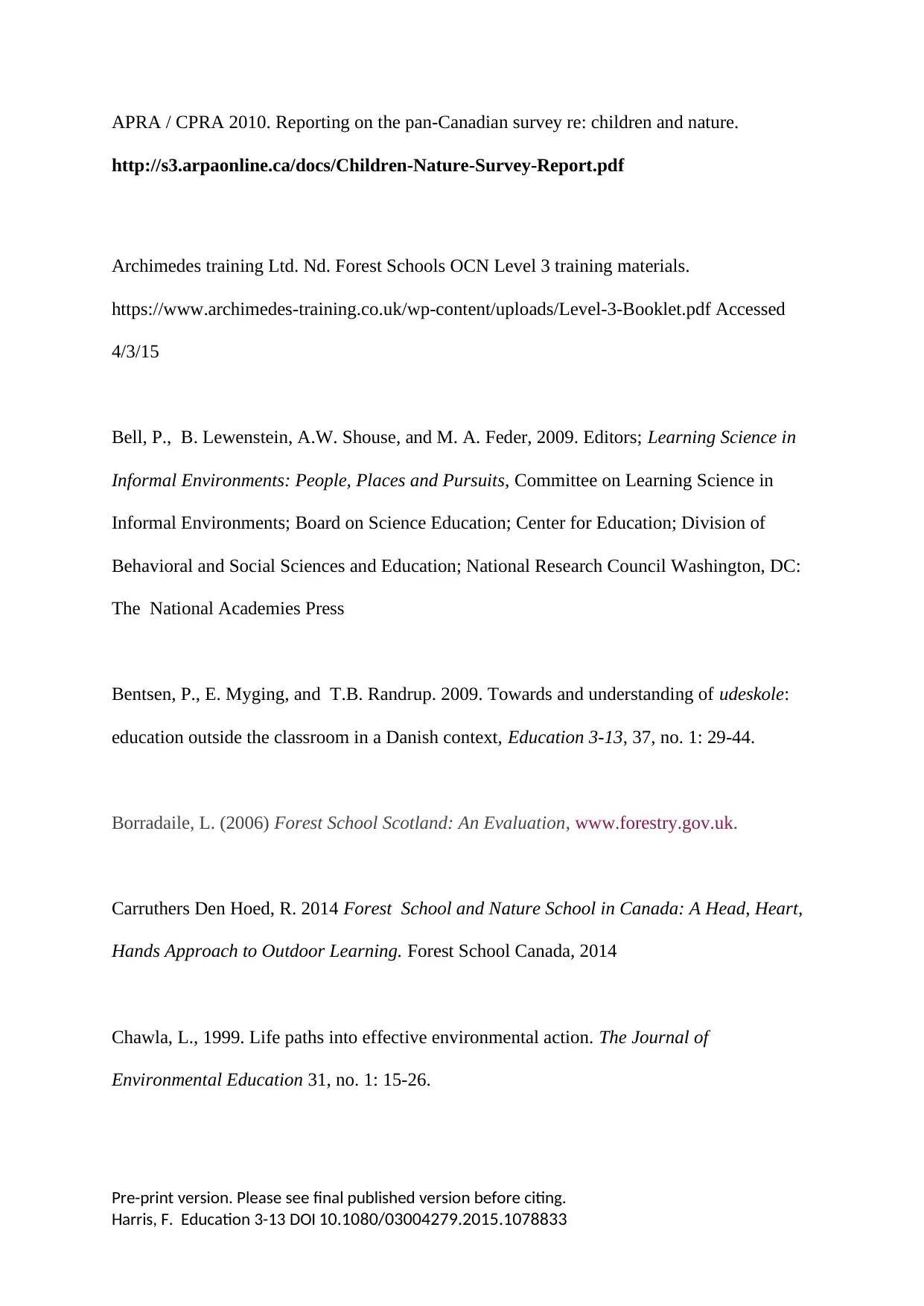
Pre-print version. Please see final published version before citing.
Harris, F. Education 3-13 DOI 10.1080/03004279.2015.1078833
APRA / CPRA 2010. Reporting on the pan-Canadian survey re: children and nature.
http://s3.arpaonline.ca/docs/Children-Nature-Survey-Report.pdf
Archimedes training Ltd. Nd. Forest Schools OCN Level 3 training materials.
https://www.archimedes-training.co.uk/wp-content/uploads/Level-3-Booklet.pdf Accessed
4/3/15
Bell, P., B. Lewenstein, A.W. Shouse, and M. A. Feder, 2009. Editors; Learning Science in
Informal Environments: People, Places and Pursuits, Committee on Learning Science in
Informal Environments; Board on Science Education; Center for Education; Division of
Behavioral and Social Sciences and Education; National Research Council Washington, DC:
The National Academies Press
Bentsen, P., E. Myging, and T.B. Randrup. 2009. Towards and understanding of udeskole:
education outside the classroom in a Danish context, Education 3-13, 37, no. 1: 29-44.
Borradaile, L. (2006) Forest School Scotland: An Evaluation, www.forestry.gov.uk.
Carruthers Den Hoed, R. 2014 Forest School and Nature School in Canada: A Head, Heart,
Hands Approach to Outdoor Learning. Forest School Canada, 2014
Chawla, L., 1999. Life paths into effective environmental action. The Journal of
Environmental Education 31, no. 1: 15-26.
Harris, F. Education 3-13 DOI 10.1080/03004279.2015.1078833
APRA / CPRA 2010. Reporting on the pan-Canadian survey re: children and nature.
http://s3.arpaonline.ca/docs/Children-Nature-Survey-Report.pdf
Archimedes training Ltd. Nd. Forest Schools OCN Level 3 training materials.
https://www.archimedes-training.co.uk/wp-content/uploads/Level-3-Booklet.pdf Accessed
4/3/15
Bell, P., B. Lewenstein, A.W. Shouse, and M. A. Feder, 2009. Editors; Learning Science in
Informal Environments: People, Places and Pursuits, Committee on Learning Science in
Informal Environments; Board on Science Education; Center for Education; Division of
Behavioral and Social Sciences and Education; National Research Council Washington, DC:
The National Academies Press
Bentsen, P., E. Myging, and T.B. Randrup. 2009. Towards and understanding of udeskole:
education outside the classroom in a Danish context, Education 3-13, 37, no. 1: 29-44.
Borradaile, L. (2006) Forest School Scotland: An Evaluation, www.forestry.gov.uk.
Carruthers Den Hoed, R. 2014 Forest School and Nature School in Canada: A Head, Heart,
Hands Approach to Outdoor Learning. Forest School Canada, 2014
Chawla, L., 1999. Life paths into effective environmental action. The Journal of
Environmental Education 31, no. 1: 15-26.

Pre-print version. Please see final published version before citing.
Harris, F. Education 3-13 DOI 10.1080/03004279.2015.1078833
Chawla, L. 2009. Growing up green: Becoming an agent of care for the natural world. The
Journal of Developmental Processes, 4, no.1: 6-23.
Chawla, L. and D.F. Cushing. 2007. Education for strategic environmental behaviour.
Environmental Education Research, 13, 437-452;
Chell, E., 1998. Critical Incident Technique, In Qualitative Methods and Analysis in
Organisational Research-a Practical Guide, Eds. Symon G. and C. Cassell. 51-72, London:
Sage.
Children and Nature Alliance, 2009. Children and Nature Connection Framing Document
http://childnature.ca/sites/default/files/downloads/Alliance-Framing-Doc.pdf
Clements, R. 2004. An Investigation of the Status of Outdoor Play. Contemporary Issues in
Early Childhood 5, no. 1: 68-90.
Cree, J. and M. McCree 2013. A brief history of forest school in the UK – Part 2. Horizons
Magazine no. 62: 32-35.
Cooper, G. 2003. The demise of real experience and the case for outdoor education. ECOS,
24, no.3/4: 10-14.
Davis, B. and S. Waite 2005. Forest school: opportunities and challenges in the early years.
Plymouth: University of Plymouth.
Harris, F. Education 3-13 DOI 10.1080/03004279.2015.1078833
Chawla, L. 2009. Growing up green: Becoming an agent of care for the natural world. The
Journal of Developmental Processes, 4, no.1: 6-23.
Chawla, L. and D.F. Cushing. 2007. Education for strategic environmental behaviour.
Environmental Education Research, 13, 437-452;
Chell, E., 1998. Critical Incident Technique, In Qualitative Methods and Analysis in
Organisational Research-a Practical Guide, Eds. Symon G. and C. Cassell. 51-72, London:
Sage.
Children and Nature Alliance, 2009. Children and Nature Connection Framing Document
http://childnature.ca/sites/default/files/downloads/Alliance-Framing-Doc.pdf
Clements, R. 2004. An Investigation of the Status of Outdoor Play. Contemporary Issues in
Early Childhood 5, no. 1: 68-90.
Cree, J. and M. McCree 2013. A brief history of forest school in the UK – Part 2. Horizons
Magazine no. 62: 32-35.
Cooper, G. 2003. The demise of real experience and the case for outdoor education. ECOS,
24, no.3/4: 10-14.
Davis, B. and S. Waite 2005. Forest school: opportunities and challenges in the early years.
Plymouth: University of Plymouth.
Paraphrase This Document
Need a fresh take? Get an instant paraphrase of this document with our AI Paraphraser
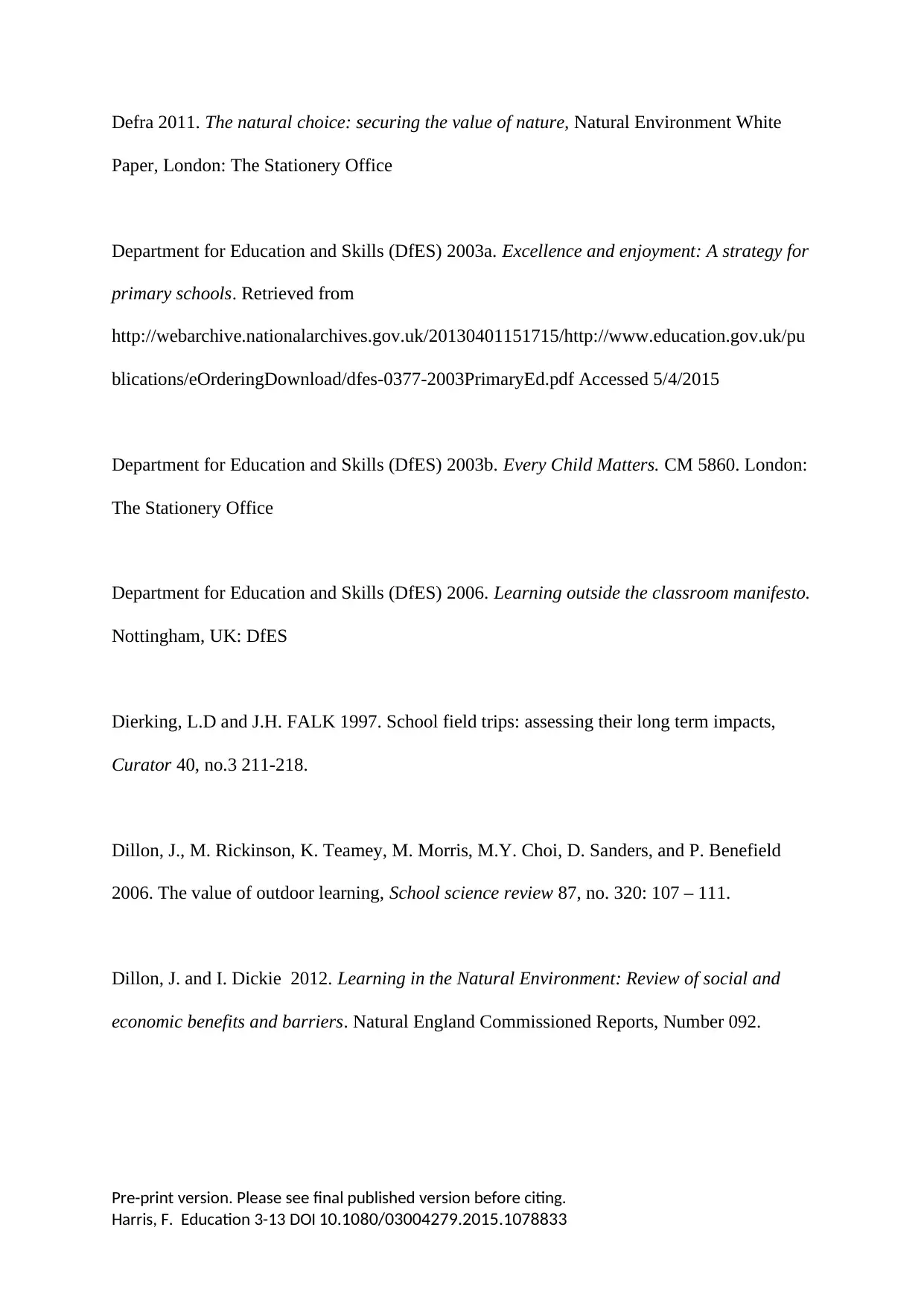
Pre-print version. Please see final published version before citing.
Harris, F. Education 3-13 DOI 10.1080/03004279.2015.1078833
Defra 2011. The natural choice: securing the value of nature, Natural Environment White
Paper, London: The Stationery Office
Department for Education and Skills (DfES) 2003a. Excellence and enjoyment: A strategy for
primary schools. Retrieved from
http://webarchive.nationalarchives.gov.uk/20130401151715/http://www.education.gov.uk/pu
blications/eOrderingDownload/dfes-0377-2003PrimaryEd.pdf Accessed 5/4/2015
Department for Education and Skills (DfES) 2003b. Every Child Matters. CM 5860. London:
The Stationery Office
Department for Education and Skills (DfES) 2006. Learning outside the classroom manifesto.
Nottingham, UK: DfES
Dierking, L.D and J.H. FALK 1997. School field trips: assessing their long term impacts,
Curator 40, no.3 211-218.
Dillon, J., M. Rickinson, K. Teamey, M. Morris, M.Y. Choi, D. Sanders, and P. Benefield
2006. The value of outdoor learning, School science review 87, no. 320: 107 – 111.
Dillon, J. and I. Dickie 2012. Learning in the Natural Environment: Review of social and
economic benefits and barriers. Natural England Commissioned Reports, Number 092.
Harris, F. Education 3-13 DOI 10.1080/03004279.2015.1078833
Defra 2011. The natural choice: securing the value of nature, Natural Environment White
Paper, London: The Stationery Office
Department for Education and Skills (DfES) 2003a. Excellence and enjoyment: A strategy for
primary schools. Retrieved from
http://webarchive.nationalarchives.gov.uk/20130401151715/http://www.education.gov.uk/pu
blications/eOrderingDownload/dfes-0377-2003PrimaryEd.pdf Accessed 5/4/2015
Department for Education and Skills (DfES) 2003b. Every Child Matters. CM 5860. London:
The Stationery Office
Department for Education and Skills (DfES) 2006. Learning outside the classroom manifesto.
Nottingham, UK: DfES
Dierking, L.D and J.H. FALK 1997. School field trips: assessing their long term impacts,
Curator 40, no.3 211-218.
Dillon, J., M. Rickinson, K. Teamey, M. Morris, M.Y. Choi, D. Sanders, and P. Benefield
2006. The value of outdoor learning, School science review 87, no. 320: 107 – 111.
Dillon, J. and I. Dickie 2012. Learning in the Natural Environment: Review of social and
economic benefits and barriers. Natural England Commissioned Reports, Number 092.
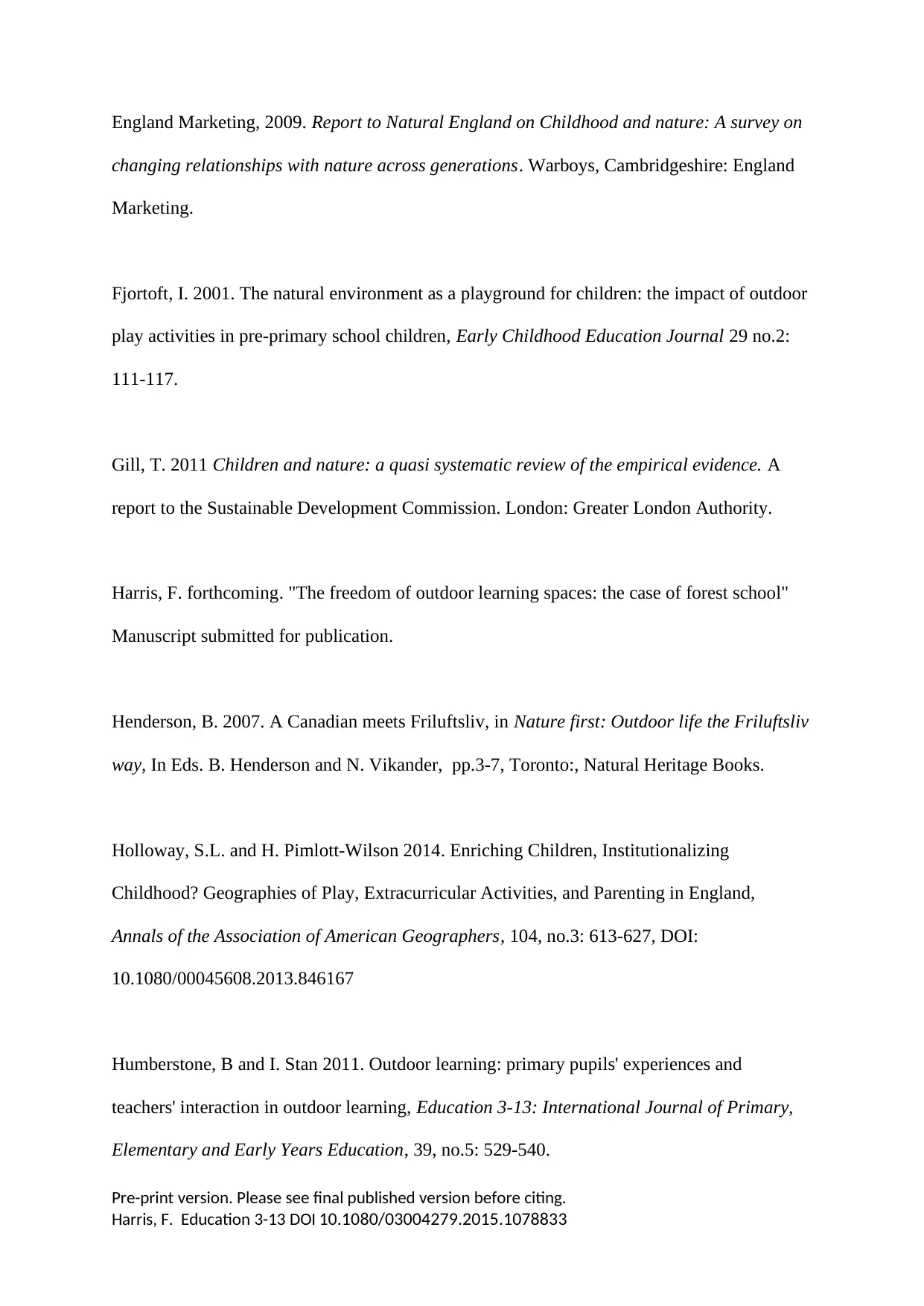
Pre-print version. Please see final published version before citing.
Harris, F. Education 3-13 DOI 10.1080/03004279.2015.1078833
England Marketing, 2009. Report to Natural England on Childhood and nature: A survey on
changing relationships with nature across generations. Warboys, Cambridgeshire: England
Marketing.
Fjortoft, I. 2001. The natural environment as a playground for children: the impact of outdoor
play activities in pre-primary school children, Early Childhood Education Journal 29 no.2:
111-117.
Gill, T. 2011 Children and nature: a quasi systematic review of the empirical evidence. A
report to the Sustainable Development Commission. London: Greater London Authority.
Harris, F. forthcoming. "The freedom of outdoor learning spaces: the case of forest school"
Manuscript submitted for publication.
Henderson, B. 2007. A Canadian meets Friluftsliv, in Nature first: Outdoor life the Friluftsliv
way, In Eds. B. Henderson and N. Vikander, pp.3-7, Toronto:, Natural Heritage Books.
Holloway, S.L. and H. Pimlott-Wilson 2014. Enriching Children, Institutionalizing
Childhood? Geographies of Play, Extracurricular Activities, and Parenting in England,
Annals of the Association of American Geographers, 104, no.3: 613-627, DOI:
10.1080/00045608.2013.846167
Humberstone, B and I. Stan 2011. Outdoor learning: primary pupils' experiences and
teachers' interaction in outdoor learning, Education 3-13: International Journal of Primary,
Elementary and Early Years Education, 39, no.5: 529-540.
Harris, F. Education 3-13 DOI 10.1080/03004279.2015.1078833
England Marketing, 2009. Report to Natural England on Childhood and nature: A survey on
changing relationships with nature across generations. Warboys, Cambridgeshire: England
Marketing.
Fjortoft, I. 2001. The natural environment as a playground for children: the impact of outdoor
play activities in pre-primary school children, Early Childhood Education Journal 29 no.2:
111-117.
Gill, T. 2011 Children and nature: a quasi systematic review of the empirical evidence. A
report to the Sustainable Development Commission. London: Greater London Authority.
Harris, F. forthcoming. "The freedom of outdoor learning spaces: the case of forest school"
Manuscript submitted for publication.
Henderson, B. 2007. A Canadian meets Friluftsliv, in Nature first: Outdoor life the Friluftsliv
way, In Eds. B. Henderson and N. Vikander, pp.3-7, Toronto:, Natural Heritage Books.
Holloway, S.L. and H. Pimlott-Wilson 2014. Enriching Children, Institutionalizing
Childhood? Geographies of Play, Extracurricular Activities, and Parenting in England,
Annals of the Association of American Geographers, 104, no.3: 613-627, DOI:
10.1080/00045608.2013.846167
Humberstone, B and I. Stan 2011. Outdoor learning: primary pupils' experiences and
teachers' interaction in outdoor learning, Education 3-13: International Journal of Primary,
Elementary and Early Years Education, 39, no.5: 529-540.
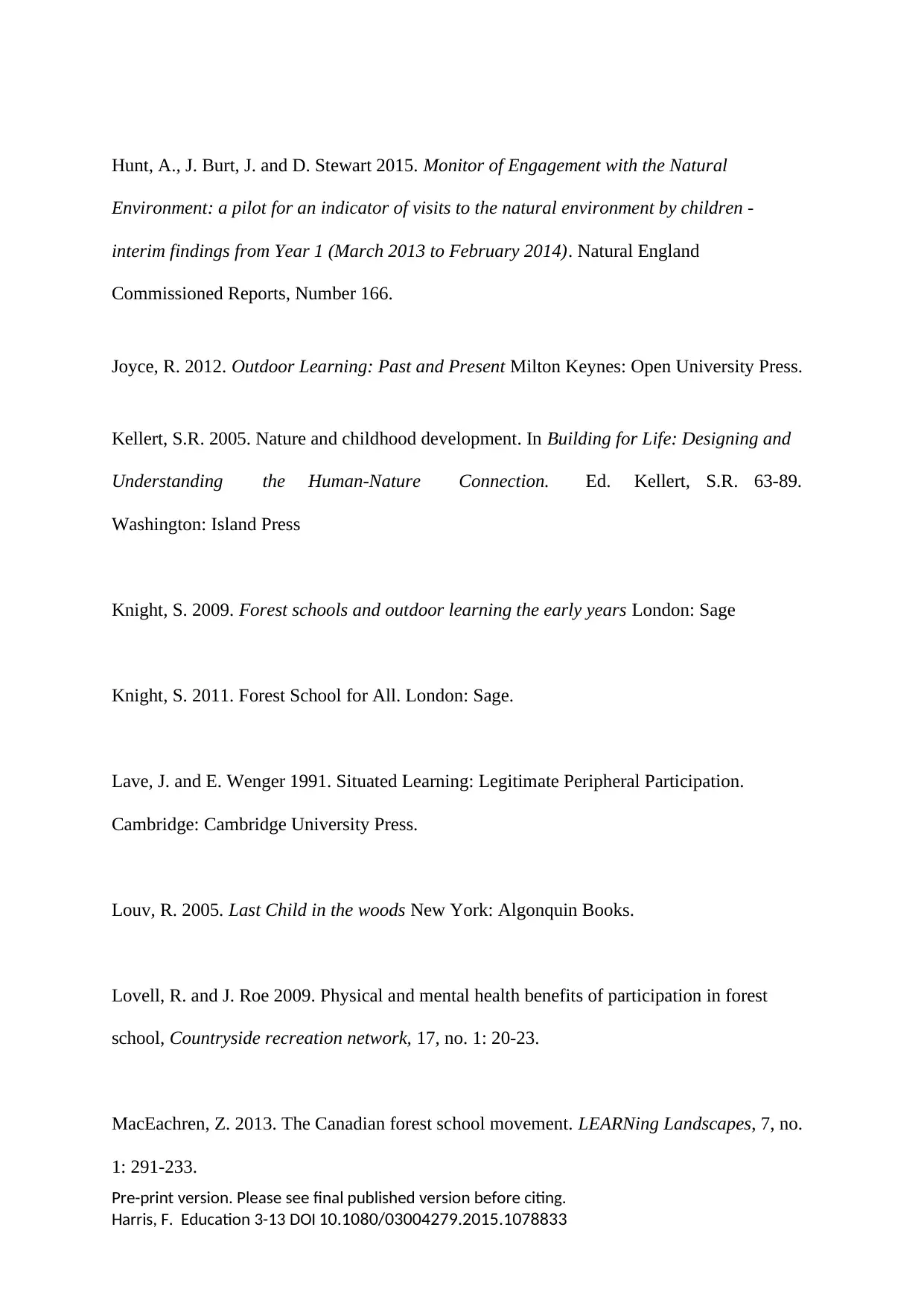
Pre-print version. Please see final published version before citing.
Harris, F. Education 3-13 DOI 10.1080/03004279.2015.1078833
Hunt, A., J. Burt, J. and D. Stewart 2015. Monitor of Engagement with the Natural
Environment: a pilot for an indicator of visits to the natural environment by children -
interim findings from Year 1 (March 2013 to February 2014). Natural England
Commissioned Reports, Number 166.
Joyce, R. 2012. Outdoor Learning: Past and Present Milton Keynes: Open University Press.
Kellert, S.R. 2005. Nature and childhood development. In Building for Life: Designing and
Understanding the Human-Nature Connection. Ed. Kellert, S.R. 63-89.
Washington: Island Press
Knight, S. 2009. Forest schools and outdoor learning the early years London: Sage
Knight, S. 2011. Forest School for All. London: Sage.
Lave, J. and E. Wenger 1991. Situated Learning: Legitimate Peripheral Participation.
Cambridge: Cambridge University Press.
Louv, R. 2005. Last Child in the woods New York: Algonquin Books.
Lovell, R. and J. Roe 2009. Physical and mental health benefits of participation in forest
school, Countryside recreation network, 17, no. 1: 20-23.
MacEachren, Z. 2013. The Canadian forest school movement. LEARNing Landscapes, 7, no.
1: 291-233.
Harris, F. Education 3-13 DOI 10.1080/03004279.2015.1078833
Hunt, A., J. Burt, J. and D. Stewart 2015. Monitor of Engagement with the Natural
Environment: a pilot for an indicator of visits to the natural environment by children -
interim findings from Year 1 (March 2013 to February 2014). Natural England
Commissioned Reports, Number 166.
Joyce, R. 2012. Outdoor Learning: Past and Present Milton Keynes: Open University Press.
Kellert, S.R. 2005. Nature and childhood development. In Building for Life: Designing and
Understanding the Human-Nature Connection. Ed. Kellert, S.R. 63-89.
Washington: Island Press
Knight, S. 2009. Forest schools and outdoor learning the early years London: Sage
Knight, S. 2011. Forest School for All. London: Sage.
Lave, J. and E. Wenger 1991. Situated Learning: Legitimate Peripheral Participation.
Cambridge: Cambridge University Press.
Louv, R. 2005. Last Child in the woods New York: Algonquin Books.
Lovell, R. and J. Roe 2009. Physical and mental health benefits of participation in forest
school, Countryside recreation network, 17, no. 1: 20-23.
MacEachren, Z. 2013. The Canadian forest school movement. LEARNing Landscapes, 7, no.
1: 291-233.
Secure Best Marks with AI Grader
Need help grading? Try our AI Grader for instant feedback on your assignments.
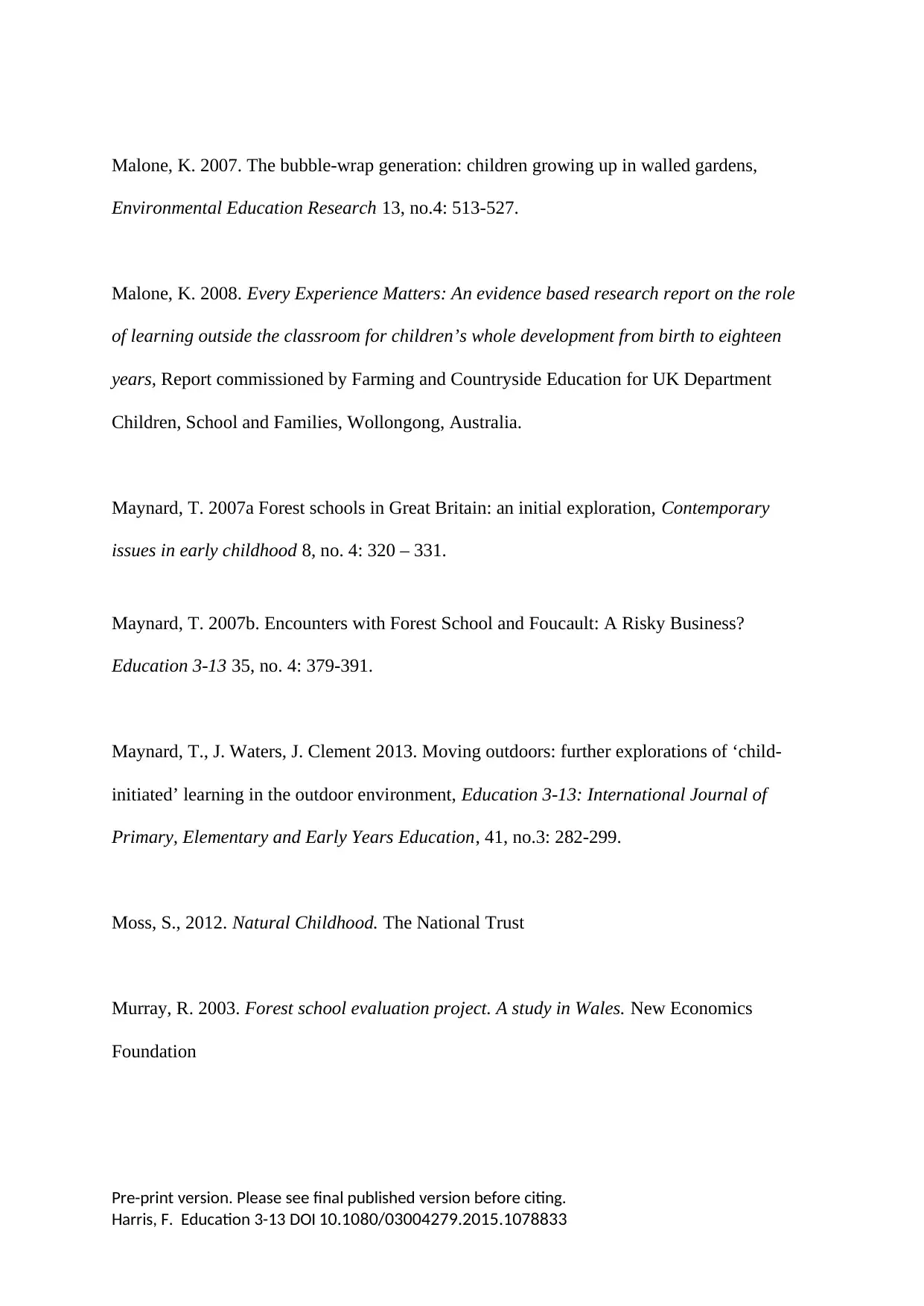
Pre-print version. Please see final published version before citing.
Harris, F. Education 3-13 DOI 10.1080/03004279.2015.1078833
Malone, K. 2007. The bubble-wrap generation: children growing up in walled gardens,
Environmental Education Research 13, no.4: 513-527.
Malone, K. 2008. Every Experience Matters: An evidence based research report on the role
of learning outside the classroom for children’s whole development from birth to eighteen
years, Report commissioned by Farming and Countryside Education for UK Department
Children, School and Families, Wollongong, Australia.
Maynard, T. 2007a Forest schools in Great Britain: an initial exploration, Contemporary
issues in early childhood 8, no. 4: 320 – 331.
Maynard, T. 2007b. Encounters with Forest School and Foucault: A Risky Business?
Education 3-13 35, no. 4: 379-391.
Maynard, T., J. Waters, J. Clement 2013. Moving outdoors: further explorations of ‘child-
initiated’ learning in the outdoor environment, Education 3-13: International Journal of
Primary, Elementary and Early Years Education, 41, no.3: 282-299.
Moss, S., 2012. Natural Childhood. The National Trust
Murray, R. 2003. Forest school evaluation project. A study in Wales. New Economics
Foundation
Harris, F. Education 3-13 DOI 10.1080/03004279.2015.1078833
Malone, K. 2007. The bubble-wrap generation: children growing up in walled gardens,
Environmental Education Research 13, no.4: 513-527.
Malone, K. 2008. Every Experience Matters: An evidence based research report on the role
of learning outside the classroom for children’s whole development from birth to eighteen
years, Report commissioned by Farming and Countryside Education for UK Department
Children, School and Families, Wollongong, Australia.
Maynard, T. 2007a Forest schools in Great Britain: an initial exploration, Contemporary
issues in early childhood 8, no. 4: 320 – 331.
Maynard, T. 2007b. Encounters with Forest School and Foucault: A Risky Business?
Education 3-13 35, no. 4: 379-391.
Maynard, T., J. Waters, J. Clement 2013. Moving outdoors: further explorations of ‘child-
initiated’ learning in the outdoor environment, Education 3-13: International Journal of
Primary, Elementary and Early Years Education, 41, no.3: 282-299.
Moss, S., 2012. Natural Childhood. The National Trust
Murray, R. 2003. Forest school evaluation project. A study in Wales. New Economics
Foundation
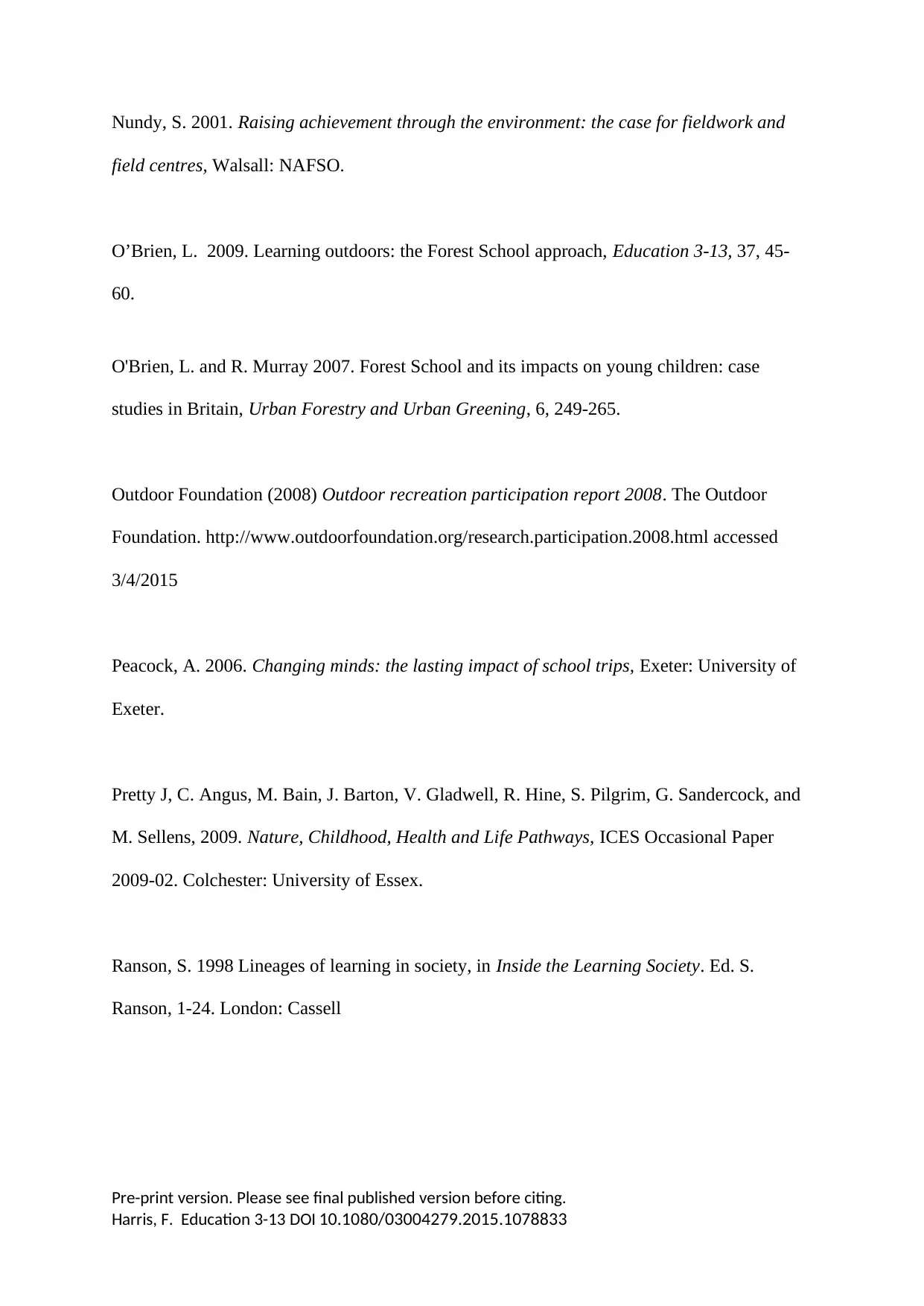
Pre-print version. Please see final published version before citing.
Harris, F. Education 3-13 DOI 10.1080/03004279.2015.1078833
Nundy, S. 2001. Raising achievement through the environment: the case for fieldwork and
field centres, Walsall: NAFSO.
O’Brien, L. 2009. Learning outdoors: the Forest School approach, Education 3-13, 37, 45-
60.
O'Brien, L. and R. Murray 2007. Forest School and its impacts on young children: case
studies in Britain, Urban Forestry and Urban Greening, 6, 249-265.
Outdoor Foundation (2008) Outdoor recreation participation report 2008. The Outdoor
Foundation. http://www.outdoorfoundation.org/research.participation.2008.html accessed
3/4/2015
Peacock, A. 2006. Changing minds: the lasting impact of school trips, Exeter: University of
Exeter.
Pretty J, C. Angus, M. Bain, J. Barton, V. Gladwell, R. Hine, S. Pilgrim, G. Sandercock, and
M. Sellens, 2009. Nature, Childhood, Health and Life Pathways, ICES Occasional Paper
2009-02. Colchester: University of Essex.
Ranson, S. 1998 Lineages of learning in society, in Inside the Learning Society. Ed. S.
Ranson, 1-24. London: Cassell
Harris, F. Education 3-13 DOI 10.1080/03004279.2015.1078833
Nundy, S. 2001. Raising achievement through the environment: the case for fieldwork and
field centres, Walsall: NAFSO.
O’Brien, L. 2009. Learning outdoors: the Forest School approach, Education 3-13, 37, 45-
60.
O'Brien, L. and R. Murray 2007. Forest School and its impacts on young children: case
studies in Britain, Urban Forestry and Urban Greening, 6, 249-265.
Outdoor Foundation (2008) Outdoor recreation participation report 2008. The Outdoor
Foundation. http://www.outdoorfoundation.org/research.participation.2008.html accessed
3/4/2015
Peacock, A. 2006. Changing minds: the lasting impact of school trips, Exeter: University of
Exeter.
Pretty J, C. Angus, M. Bain, J. Barton, V. Gladwell, R. Hine, S. Pilgrim, G. Sandercock, and
M. Sellens, 2009. Nature, Childhood, Health and Life Pathways, ICES Occasional Paper
2009-02. Colchester: University of Essex.
Ranson, S. 1998 Lineages of learning in society, in Inside the Learning Society. Ed. S.
Ranson, 1-24. London: Cassell
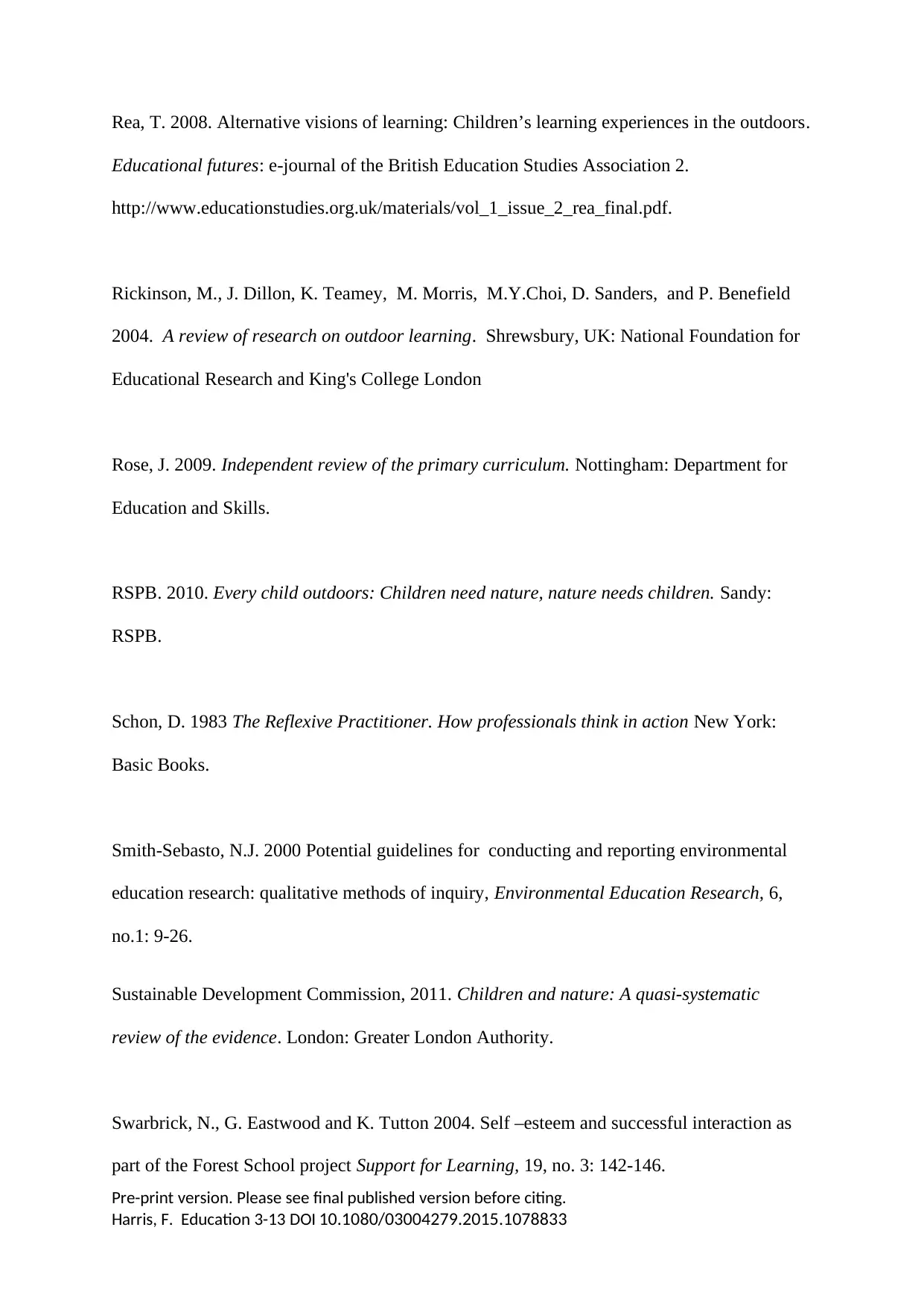
Pre-print version. Please see final published version before citing.
Harris, F. Education 3-13 DOI 10.1080/03004279.2015.1078833
Rea, T. 2008. Alternative visions of learning: Children’s learning experiences in the outdoors.
Educational futures: e-journal of the British Education Studies Association 2.
http://www.educationstudies.org.uk/materials/vol_1_issue_2_rea_final.pdf.
Rickinson, M., J. Dillon, K. Teamey, M. Morris, M.Y.Choi, D. Sanders, and P. Benefield
2004. A review of research on outdoor learning. Shrewsbury, UK: National Foundation for
Educational Research and King's College London
Rose, J. 2009. Independent review of the primary curriculum. Nottingham: Department for
Education and Skills.
RSPB. 2010. Every child outdoors: Children need nature, nature needs children. Sandy:
RSPB.
Schon, D. 1983 The Reflexive Practitioner. How professionals think in action New York:
Basic Books.
Smith-Sebasto, N.J. 2000 Potential guidelines for conducting and reporting environmental
education research: qualitative methods of inquiry, Environmental Education Research, 6,
no.1: 9-26.
Sustainable Development Commission, 2011. Children and nature: A quasi-systematic
review of the evidence. London: Greater London Authority.
Swarbrick, N., G. Eastwood and K. Tutton 2004. Self –esteem and successful interaction as
part of the Forest School project Support for Learning, 19, no. 3: 142-146.
Harris, F. Education 3-13 DOI 10.1080/03004279.2015.1078833
Rea, T. 2008. Alternative visions of learning: Children’s learning experiences in the outdoors.
Educational futures: e-journal of the British Education Studies Association 2.
http://www.educationstudies.org.uk/materials/vol_1_issue_2_rea_final.pdf.
Rickinson, M., J. Dillon, K. Teamey, M. Morris, M.Y.Choi, D. Sanders, and P. Benefield
2004. A review of research on outdoor learning. Shrewsbury, UK: National Foundation for
Educational Research and King's College London
Rose, J. 2009. Independent review of the primary curriculum. Nottingham: Department for
Education and Skills.
RSPB. 2010. Every child outdoors: Children need nature, nature needs children. Sandy:
RSPB.
Schon, D. 1983 The Reflexive Practitioner. How professionals think in action New York:
Basic Books.
Smith-Sebasto, N.J. 2000 Potential guidelines for conducting and reporting environmental
education research: qualitative methods of inquiry, Environmental Education Research, 6,
no.1: 9-26.
Sustainable Development Commission, 2011. Children and nature: A quasi-systematic
review of the evidence. London: Greater London Authority.
Swarbrick, N., G. Eastwood and K. Tutton 2004. Self –esteem and successful interaction as
part of the Forest School project Support for Learning, 19, no. 3: 142-146.
Paraphrase This Document
Need a fresh take? Get an instant paraphrase of this document with our AI Paraphraser

Pre-print version. Please see final published version before citing.
Harris, F. Education 3-13 DOI 10.1080/03004279.2015.1078833
UK NEA 2011. The UK National ecosystem assessment: Synthesis of the key findings.
Cambridge: UNEP, WCMC.
Waite, S. 2010. Losing our Way? the Downward Path for Outdoor Learning for Children
Aged 2-11 Years. Journal of Adventure Education and Outdoor Learning 10, no. 2: 111-126.
Waite, S. 2011. Teaching and learning outside the classroom: personal values, alternative
pedagogies and standards, Education 3-13: International Journal of Primary, Elementary and
Early Years Education, 39, no.1, 65-82.
Waite, S. and Goodenough, A. 2010. How can we know?: Approaches to assessing some
‘soft’ benefits of woodland activities for children in participative research with the third
sector. Paper for Childen and Nature: measuring success? Seminar, London, 21st October,
2010.
Waite, S.J., J. Evans and S. Rogers 2011. A time of change: outdoor learning and pedagogies
of transition between foundation stage and year 1. in Waite, S. (Ed.) Children Learning
outside the Classroom. From Birth to Eleven, 50-63. London: Sage.
Ward Thompson, C., P. Aspinall and A. Montarzino 2008. The childhood factor: Adult visits
to green places and the significance of childhood experience. Environment and Behaviour,
40, 111–143.
Harris, F. Education 3-13 DOI 10.1080/03004279.2015.1078833
UK NEA 2011. The UK National ecosystem assessment: Synthesis of the key findings.
Cambridge: UNEP, WCMC.
Waite, S. 2010. Losing our Way? the Downward Path for Outdoor Learning for Children
Aged 2-11 Years. Journal of Adventure Education and Outdoor Learning 10, no. 2: 111-126.
Waite, S. 2011. Teaching and learning outside the classroom: personal values, alternative
pedagogies and standards, Education 3-13: International Journal of Primary, Elementary and
Early Years Education, 39, no.1, 65-82.
Waite, S. and Goodenough, A. 2010. How can we know?: Approaches to assessing some
‘soft’ benefits of woodland activities for children in participative research with the third
sector. Paper for Childen and Nature: measuring success? Seminar, London, 21st October,
2010.
Waite, S.J., J. Evans and S. Rogers 2011. A time of change: outdoor learning and pedagogies
of transition between foundation stage and year 1. in Waite, S. (Ed.) Children Learning
outside the Classroom. From Birth to Eleven, 50-63. London: Sage.
Ward Thompson, C., P. Aspinall and A. Montarzino 2008. The childhood factor: Adult visits
to green places and the significance of childhood experience. Environment and Behaviour,
40, 111–143.
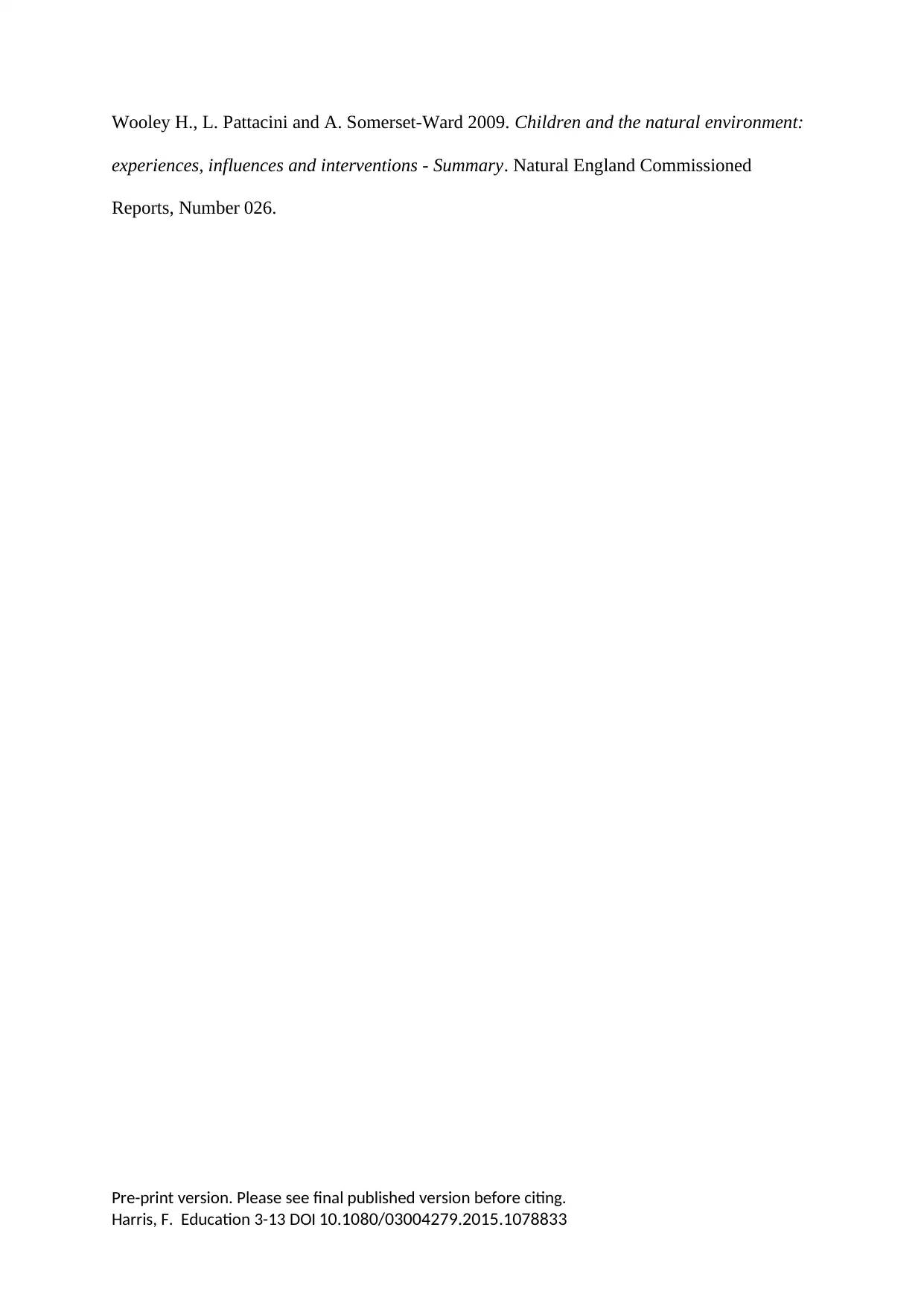
Pre-print version. Please see final published version before citing.
Harris, F. Education 3-13 DOI 10.1080/03004279.2015.1078833
Wooley H., L. Pattacini and A. Somerset-Ward 2009. Children and the natural environment:
experiences, influences and interventions - Summary. Natural England Commissioned
Reports, Number 026.
Harris, F. Education 3-13 DOI 10.1080/03004279.2015.1078833
Wooley H., L. Pattacini and A. Somerset-Ward 2009. Children and the natural environment:
experiences, influences and interventions - Summary. Natural England Commissioned
Reports, Number 026.
1 out of 42
Your All-in-One AI-Powered Toolkit for Academic Success.
+13062052269
info@desklib.com
Available 24*7 on WhatsApp / Email
![[object Object]](/_next/static/media/star-bottom.7253800d.svg)
Unlock your academic potential
© 2024 | Zucol Services PVT LTD | All rights reserved.

